This is a new weekly summary highlighting some of the historical happenings within the 2000+ year history of the Catholic Church. If you have any specific comments, questions, or requests on topics, reach out to Parishioner Mark Nalevanko (mark.nalevanko@gmail.com).
Upcoming Week in Church History: January 28 – February 3
We have made it through one year!!! We cap off this series with a couple educators of the Church, one known for his academic-minded writings and another for his zeal to educate the young out in the missionary fields, a feast day commemorating one of the early events in Jesus’ life and an early bishop in the East. Thanks to everyone who has followed along. Wondering what’s next? Have no fear! We will be starting a new weekly series next week titled “Why do Catholics do that?” It will continue to pull in some of the historical background which played a huge role in many of the traditions of the Church while also inserting some theological points.
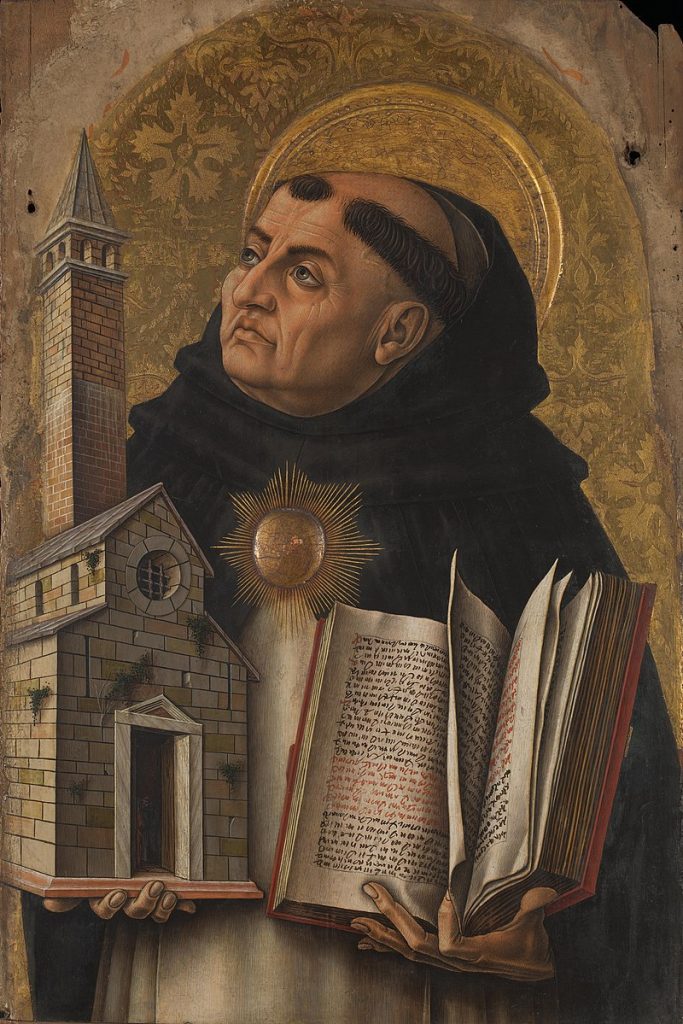
Sun, Jan 28: Memorial of St. Thomas Aquinas (c. 1225 – March 7, 1274) Anyone who has done any sort of theological studies has likely dealt with in one form or another the great masterpiece (and lengthy work!) of Thomas Aquinas known as the Summa Theologiae. This work which unfortunately was not entirely finished by the time of Thomas’ death incorporated philosophy as part of a systematic approach to understanding both the natures of God and man with Christ serving as the way for man to reach God. Born in S. Italy to a noble family that occupied both positions militarily and within the Church, Thomas followed the route of religious life. Starting his education at age 5 in the famous abbey of Monte Cassino and then in Naples, he later secretly joined the Dominican Order as his family did not support the decision. Thomas would go on to study at the University of Paris before holding teaching positions in Cologne and then back at Paris. As a student, he was known for being quiet leading some to think he was slow-minded – far be it! He later returned to his home region and served as an educator for other Dominicans, which prompted him to write the Summa. Thomas would return to teach in Paris a second time before returning again to teach in Naples. Thomas was known for the ability to levitate and undergo mystical experiences. Unfortunately while on the way to the Second Council of Lyon, which was focused on uniting the Eastern Orthodox Church with the Catholic Church, he fell ill and died on March 7, 1274 before reaching the age of 50. His feast is not March 7 as that commonly falls within Lent so it was moved to Jan 28 as part of the liturgical calendar reforms of 1969.
Wed, Jan 31: Memorial of St. John Bosco (Aug 16, 1815 – Jan 31, 1888) Born near Turin, Italy in NW Italy to a family of farmhands and a life of poverty, John experienced a vivid dream at a young age showing the importance of a life of gentleness and kindness as opposed to one filled with anger and sin. He became a referee of sorts in breaking up fights among kids and took an interest in some of the performing arts, such as juggling, magic and acrobatics. With educational opportunities as a youth limited, he eventually found a formal education in a seminary and was ordained a priest in 1841. He found a particular calling in the education of boys in the model of Frances de Sales (see his feast day last week) while also incorporating the instruction of trades such as shoemaking and tailoring. As programs grew, John started utilizing a printing press to help disseminate catechetical pamphlets. In 1859, John was granted permission to found the Salesians which today represents a huge global missionary entity within the Church. John died on Jan 31, 1888 and was canonized by Pope Pius XII in 1949. He is the patron saint of youth, editors, and educators/teachers.
Fri, Feb 2: Feast of the Presentation of the Lord Coming 40 days after Christmas, this feast day marks one of the few events described in the life of Jesus between the Nativity and Baptism (see Luke 2:22-40). It was Jewish custom going back to the time of Moses to present the firstborn son to the Lord in tandem with a sacrificial offering, such as two young pigeons. At Jesus’ time on earth that meant at the Temple in Jerusalem. As Luke documents, a man named Simeon, who had been instructed by God that he would see the salvation of the world before his death, would encounter the family and prophesize the glory but also the pain that would come in the future surrounding Jesus’ life and death.
Sat, Feb 3: Memorial of St. Blaise (?? – 316) Known by Catholics as the Saint for Throat Ailments, there’s not much really known about the life of this early bishop of the East from an area known as Cappadocia in present day central Turkey. This is the same area from which St. Basil and his holy family resided. Despite the Edict of Milan being issued in 313, which permitted Christians to publicly follow their faith, persecutions still persisted in the East where worship to pagan gods was demanded on the penalty of death. As part of these persecutions, Blaise was imprisoned, scourged and eventually beheaded. The tradition of calling upon this saint as part of a blessing of the throat comes from a later work (written some 400 years later) called the Acts of St. Blaise, which documented an event where a mother with a child choking on a fish bone pleaded for the bishop’s help. St. Blaise offered up prayers for the child who instantly coughed up the bone and was healed.
Upcoming Week in Church History: January 21-27
“One can catch more flies with a spoonful of honey than with a hundred barrels of vinegar.” This week we take a look at the life of one of the Catholic heroes of the era known as the Counter-Reformation in the late 16th/early 17th centuries. We also recall one of the most famous conversion stories documented in the Bible (Saul to Paul) along with the lives of two of his most important cohorts.
Mon, Jan 22: Day of Prayer for the Legal Protection of Unborn Children
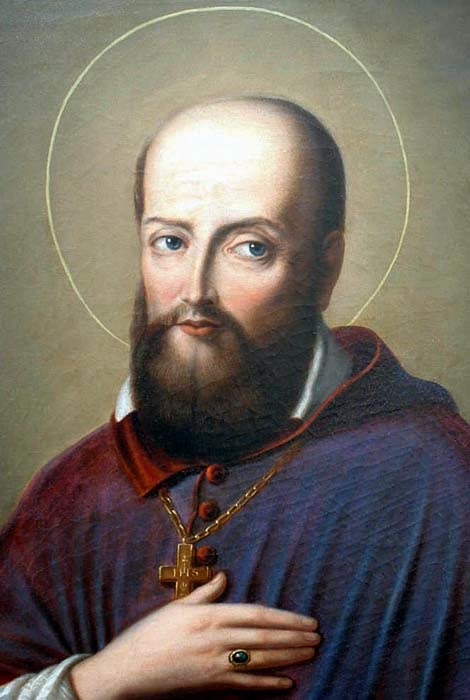
Wed, Jan 24: Memorial of St Francis de Sales (Aug 21, 1567 – Dec 28,1622) Born as the first of six sons to a family near Bordeaux, France, Francis shunned an expected life of nobility. He instead dedicated his life to God and was ordained a priest in 1593. He quickly volunteered to work in Geneva, which had become a stronghold for the Calvinist movement of the Protestant Reformation era. As bishop he was forced to reside in a nearby town in Annecy, France because the Calvinists did not permit his residence in Geneva. This did not discourage Francis as he wrote and taught extensively on the Catholic faith and encouraged frequent reception of the Eucharist. He was known for a welcoming and gentle style of catechesis (see quote in summary as one example when discussing the importance of balance in life). His efforts brought many Protestants back into the Catholic fold and he would be later recognized by the Church as a Saint in 1665 and then a Doctor of the Church in 1877. While he died of a stroke on Dec 28, 1622, his feast day on Jan 24 aligns with his burial in 1624 in Annecy. He is the patron saint of Authors/Writers, several religious communities, and several schools including DeSales University in Eastern PA.
Thurs, Jan 25: Feast of the Conversion of St. Paul the Apostle This day celebrates the famous conversion story of Saul to Paul that is documented in Acts of the Apostles chapter 9. While Saul traveled to Damascus, a flash of light caused him to fall to the ground and he then heard the words “Saul, Saul, why do you persecute me?” After being told it was Jesus talking to him, who instructed him to go into the city and wait until he was told what to do, Paul was left blinded for a time until a disciple of Jesus in the city, Ananais, laid hands on him and healed him. Paul would then be baptized and begin his famous discipleship in the name of Christ.
Fri, Jan 26: Memorial of Sts. Timothy (c.17- c. 97) and Titus (1st century AD) Timothy came from one of the first Christian families of Lystra near the center of present-day Turkey and served as one of the early Christian leaders of his community shortly after St. Paul’s first visit to the area. Timothy’s role as a companion of Paul on some of his travels and fellow evangelist is well known through the two letters to Timothy and several other letters by Paul that are contained within the New Testament. Non-biblical sources claim that Timothy eventually was stoned to death around 97 AD at the age of 80 while trying to halt pagan practices. Another traveling companion and secretary of Paul was Titus, who was a Greek convert to the Faith, probably from the island of Crete. According to Paul’s letter to Titus within the New Testament, Titus was instructed to appoint Church leadership on the island as Paul continued on his journeys. It is believed that Titus lived well into his 90s, dying of old age.
Upcoming Week in Church History: January 14-20
“Let us think not, as we look at the world, that we have renounced anything of much consequence, for the whole earth is very small compared with all the heaven.” This week we recall the lives of two extraordinary early Church Fathers, one known for his solitary life in the desert and another who served as pope – elected in one of the most memorable (and perhaps unexpected) ways while also serving honorably until his martyrdom.
Wed, Jan 17: Memorial of St. Anthony (251-356) Anthony is known as one of the earliest Desert Fathers (see picture). Born into a wealthy Christian Egyptian family, he applied the teaching of Matthew 19:21 where Jesus responded to a young rich man’s inquiry to know what he may be lacking in pursuing eternal life by calling him to sell all his belongings and give to the poor. Unlike the young rich man in the Gospel, Anthony followed this particular call at around the age of 20 shortly after the death of his parents. He then sought a life of solitude in the desert – praying, fasting, battling evil spirits, and doing acts of penance while also being a source of spiritual healing and guidance to those that sought his counsel (see quote at beginning of this summary as one example). Eventually he formed a monastic community with those who similarly dwelled in the area he lived. He combated the Arian heresy of the age. Anthony lived a remarkably long time (105 years) and at over 90 years old traveled the desert to find St. Paul the Hermit, who preceded Anthony as a Desert Father. Anthony’s story is famously known through a biography written by St. Athanasius, who visited with him on several occasions and was given one of his few possessions, a sheepskin cloak, as death approached.
Sat, Jan 20: Memorial of Pope St. Fabian (c 200 – Jan 20, 250) Perhaps known for one of the more interesting papal elections, Fabian was a relatively unknown Roman layman who upon coming to Rome from the countryside and seeing that a papal election was underway, he gathered near and a dove suddenly descended upon the head of Fabian. The electors recalled this happening at the Baptism of Jesus and interpreted the event as a sign for Fabian’s dignity. By acclamation the electors declared Fabian the new pope! Fabian would reign for fourteen years and is believed to have commissioned the “apostles to the Gauls”, the first bishops of France which included St. Denis, the first bishop of Paris. Fabian is also believed to have divided the Christian communities of Rome into seven districts with each under the supervision of a deacon. While a period of peace concerning Christian persecution had existed for a few years, the rise of Emperor Decius changed that. The emperor required Romans to demonstrate loyalty to the empire by offering incense to the Roman gods. Fabian along with many other Christians refused leading to their eventual martyrdom.
Upcoming Week in Church History: January 7-13
This week we take a look at what the feast of the Epiphany, which is today commonly associated with the visit of the Magi, looked like in the early Church. We also take a look at who the Magi most likely were and how they were drawn to travel to Bethlehem.
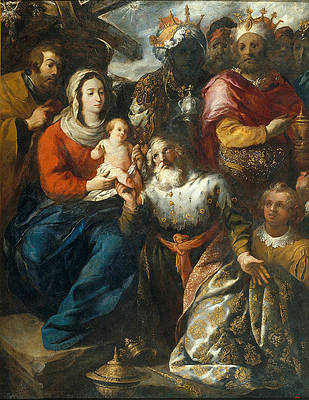
Sun, Jan 7: Solemnity of the Epiphany of the Lord Writing around AD 200, both Hippolytus of Rome and Clement of Alexandria (Egypt) are the first extant references to a feast among some groups of Christians in the East (Egypt, Middle East) associated with the name Epiphany or Theophany (both names of Greek origin)which commemorated the manifestation or appearance of divinity in Jesus. Given the rather ambiguous name, a number of events in Jesus’ life were recalled with this feast including the Nativity, the visit of the Magi, his Baptism, and the miracle of changing water into wine at the Wedding Feast of Cana. However, by the late AD 300s, the Church in the West (Europe and Western North Africa) firmly established the feast as specifically commemorating the visit of the Magi. But who were these Magi and why did they visit? Despite what the modern-day Christmas carol suggests, there are no early Church Father writings suggesting the Magi were “kings” or that three of them came. Over time various traditions would establish the number and names of the Magi with the Latin Church in the West settling on 3 Magi (likely corresponding to the 3 gifts mentioned in the Gospel narrative) with the names Gaspar, Melchior and Balthasar. While several theories exist, one of the more plausible scenarios is that the Magi were astrologers from the area of Babylon under the Persian Parthian Empire at that time, a several month’s journey toward the East. As part of their astrological belief system, the appearance of certain signs in the sky around the time of Jesus’ birth involving the planet Jupiter signified both the upcoming death of the current king in Persia along with the birth of a new conquering king in the West (ie: area of Jerusalem). Historical records show that a change in ruler in the Parthian Empire indeed occurred in 2 BC after the reign of Phraates IV had lasted for about 35 years which gives some credence to the older traditional theory that Jesus probably was born around 2 BC versus some of the earlier dates proposed by modern scholars of between 6 BC – 4 BC. So in practicality, the Magi may have set off on a journey to see the current ruler in the West, namely Herod in Jerusalem, to learn themselves about what all may be happening in that land and then eventually to Bethlehem as primarily a peace mission! It’s amazing how God’s providence can work.
Mon, Jan 8: Feast of the Baptism of the Lord Commemorating the baptism of Jesus in the Jordan River by John the Baptist, this event in Jesus’ life is still associated as part of the Epiphany in the Eastern Church. With the emphasis in the West on the visit by the Magi as the Epiphany, the Baptism of the Lord officially became a separate feast day in the Western Church under Pope Pius XII in 1955 with the current date of the Monday after Epiphany Sunday established in 1969.
Upcoming Week in Church History: December 31-January 6
As we end one calendar year and start the beginning of another, we celebrate the role of family, Mary’s special status as Mother of God, two early Doctors of the Church, and two founders of Catholic education in the US. It’s quite a week to kick off the new year!
Sun, Dec 31: Feast of the Holy Family of Jesus, Mary and Joseph Serving as a model for all Christian families, we honor the holiest of families – Jesus, Mary and Joseph. Christ humbled himself to become man and in doing so be obedient within the family unit while Mary and Joseph served lovingly as guardians, caregivers and teachers during his youth. This feast was established out of local traditions in 1892 under Pope Leo XIII and then elevated to the universal Church’s calendar of feasts under Pope Benedict XV starting in 1921. Since 1969 the feast has been celebrated on the first Sunday after Christmas. Ultimately this is a feast day for all families!
Mon, Jan 1: Solemnity of Mary, the Holy Mother of God This feast day has been celebrated on the Octave (8th) day of Christmas since 1969 and recognizes Mary’s unique role as mother of Jesus Christ, the Son of God. This title which comes from the Greek Theotokos meaning “Bearer of God” was a title associated with Mary from early Church days, although without serious debate from some including the later condemned Bishop Nestorius. The First Council of Ephesus in 431 formally adopted the title as part of efforts to affirm the divinity of Christ. This feast is normally considered a holy day of obligation with mass attendance required as reasonably possible unless falling on a Saturday or a Monday with the latter being the case this year (2024).
Tues, Jan 2: Memorials of Basil the Great (c. 329-Jan 1, 379) and Gregory Nazianzen (c 329-Jan 25,390) Known as the father of Eastern monasticism, Basil along with his friend Gregory of Nazianzus, both from an area in central Turkey, fought against heresies such as Arianism in the 4th century during a time of significant Church growth after the legalization of the Faith within the Roman Empire. Basil came from a very devout family, which included several Church-canonized saints such as his grandmother, Macrina the Elder, and his siblings Gregory of Nyssa, Peter of Sebaste and Macrina the Younger. Basil and Gregory met through their studies, first regionally and then later in Athens, becoming great friends. After both experienced conversion stories, Basil and Gregory initially sought monasticism over more public Church positions but were eventually drawn to important bishop positions. Basil eventually established a more community-based form of monasticism that centered around a balance of daily prayer and work, which was a basis for St. Benedict’s monastic rule, and has existed ever since within the Church. As bishop of Caesarea, he established what was essentially the first hospital center, a complex that Gregory described as like one of the seven wonders of the ancient world at his funeral. Basil and Gregory are known for developing the theological concepts of ousia (essence/substance)and hypostasis (person) towards a better understanding of the Trinity – three consubstantial Persons (Father, Son and Holy Spirit) as one God. This work led them to be declared Doctors of the Church. Basil died around the age of 50 from the effects of ascetic living. Gregory would spend his last few years as a hermit and writer.
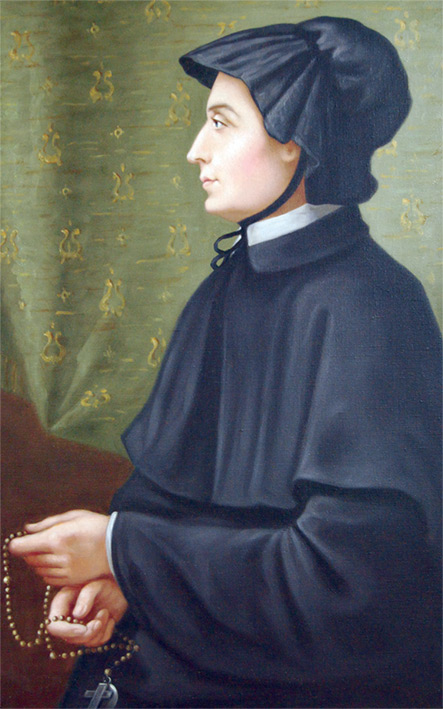
Thurs, Jan 4: Memorial of St. Elizabeth Ann Seton (Aug 28, 1774 – Jan 4, 1821) The second child to a late 18th century Anglican/Episcopalian New York City family, Elizabeth (see picture) would later become the first person born in the US to be canonized a saint by the Church. At 19, Elizabeth married William Seton but became a widow 10 years later after he died of tuberculosis while the family lived for a brief time in Italy. It was in Italy that Elizabeth was introduced to Catholicism and was received into the Church upon her return to New York at St Peter’s Church, the only Catholic Church that existed in the city at that time! However, the conversion news did not go well for her academy for young ladies as attendance numbers dwindled. She was about to leave for Canada when a French community arrived looking to establish the first Catholic seminary in the US in 1808 (now called Mount St. Mary’s University in Emmitsburg, Maryland). Elizabeth would go on to establish next to the seminary a girl’s school called St. Joseph’s Academy and Free School (first free Catholic school and the start of the Catholic parochial school system in the US) along with a religious community focused on care for the children of the poor called the Sisters of Charity of St. Joseph’s (first Catholic sisters community founded in the US). The community would later move under the Daughters of Charity founded by Vincent de Paul. Elizabeth was canonized by Pope Paul VI on Sept 14, 1975. She is the patron saint of Catholic Schools, Educators/Teachers, and Widows.
Fri, Jan 5: Memorial of St. John Neumann (March 28, 1811 – Jan 5, 1860) As another pivotal Catholic schools founder in the US, John came from Bohemia in present-day Czech Republic. While studying to be a priest, he read about a need for priests in the US so John departed to America in 1836 at the age of 25, seeing the ocean for the first time. While his intentions were to be ordained before departing, circumstances dictated otherwise and he was ordained a parish priest in New York City shortly after arriving. After some time serving in New York, New Jersey and then Maryland, he was appointed bishop of Philadelphia in 1852 at a time when immigration trends prompted a need to open a new parish in the area at nearly one per month! John put special attention into the education of immigrant children and organized the first diocesan school system, growing the parochial schools in his diocese from one to 200! Unfortunately, John’s life ended at a young age of 48, collapsing and dying while running errands. He was canonized by Pope Paul VI on June 19, 1977 and also a patron saint of Educators/Teachers.
Upcoming Two Weeks in Church History: December 17-30
As we approach the Christmas season and a New Year, we will take a short survey of several noteworthy events in the Church’s history over the last 2 weeks of December… from the assigning of a date to Christ’s birth to the momentous crowning of a king in re-establishing an empire to the first recognized martyr of the Church to the last living Apostle.
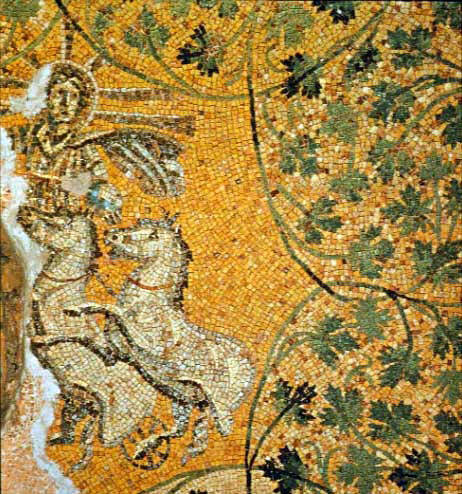
Mon, Dec 25: The Nativity of the Lord (Christmas) While Christians are accustomed to this date’s significance in commemorating the birth of Jesus in Bethlehem, how did this date actually get selected and why do some Eastern Christians adhere to a different date? From historical records, the Nativity of the Lord was not one of the earliest feasts celebrated by the Church but mostly grew organically from local observances. Late second century fathers of the Church, such as Irenaeus and Tertullian, actually never mention the feast when providing lists of feast days at a time when the Church held more significance to the days when saints died instead of their birthdays. Some early proposed dates for the birthday of Christ coincided with the Spring (March-May) but a celebration of the Epiphany (probably with the Nativity too) in early January shifted the focus to a Winter date. The first recorded extant historical proof concerning the celebration of Christmas by the Roman Church isn’t until Dec 25, 336. The adoption/practice of this date gradually grew with evidence suggesting Pope Julius I (r 337-352) declared Dec 25 as the date after a review of traditions and historical data at the time. The modern-day debate over why the specific date was selected has never really been conclusively resolved. Two main hypotheses exist, both of which are sound ideas and perhaps both correct even based on the evidence available from early Church writings. Firstly, the Dec 25 date is nine months after the Feast of the Annunciation (March 25) commemorating the conception of Jesus in connection with the Spring equinox, a date used by the early Church. Alternatively, there was a Roman pagan feast called the “birthday of the Unconquered Sun” held on Dec 25 in connection with the Winter solstice which may have been chosen as the date of the Nativity of the Lord in part to help steer Christians away from pagan influences. Regardless of which hypothesis one adheres to, early Church artwork and writings exist suggesting a cosmological association of Christ with the sun and solar events (see 3rd century mosaic under St. Peter’s Basilica in Rome). With that said, why does the Orthodox Church recognize Jan 7 as Christmas? It essentially boils down to following the Julian calendar (used by the Orthodox Church) vs. the Gregorian calendar (which follows a more precise accounting of the solar year and is used in most parts of the world today). Today, a Gregorian calendar date is 13 days in front of the corresponding Julian calendar day, the difference between Dec 25 and Jan 7!
Mon, Dec 25: Crowning of Charlemagne (800) On Christmas day in 800, King Charlemagne of the Franks, in recognition for his role in serving as protector of Rome and the papacy would be crowned in Rome by Pope Leo III, thus becoming the first emperor of the west since the official fall of the Western Roman Empire in 476. This alliance of Church and state under what was now called the Holy Roman Empire would remain for the next 1000 years, thus playing a most important role in the course of European history and civilization during those years.
Tues, Dec 26: Feast of Stephen, The First Martyr (c.5 – c.34) Mentioned in the Acts of the Apostles as one of the ordained seven deacons of the early Church in Jerusalem tasked with the care of the Hellenistic (Greek) Jews, Stephen was denounced by Jewish authorities for his preaching concerning Christ and ultimately stoned to death with Saul, the future Apostle Paul, being present at the event. Stephen is the patron saint of Deacons.
Wed, Dec 27: Feast of Apostle John (c. 6 – c. 100) Known as one of the sons of Zebedee, a fisherman, and the Beloved Apostle, John would be the only Apostle not to face martyrdom, but instead live a long life and die of natural old age. Tradition holds that he wrote the three epistles, the Gospel of John (around AD 65-85) and the Book of Revelation (around AD 100), all part of the canon of the Bible. While much of John’s life story after Christ’s resurrection is uncertain, traditions hold that he was exiled to Patmos, a Greek Island in the Aegean Sea just off the coast of present-day Turkey during the time of Emperor Domitian (r 81-96). Probably before his exile he mentored the future Bishops Ignatius of Antioch and Polycarp of Smyrna. There are no relics of John, which tends to give credence to the belief that John may have been assumed into heaven. Stories concerning John’s life began circulating within a 2nd century collection called the Acts of John, which included a few variations surrounding the details of his death including his request that a trench be dug which he laid in as he prepared to release his spirit, followed by a great light event and his body not being found the next day.
Thurs, Dec 28: Feast of the Holy Innocents This feast day calls to mind the event recorded in the Gospel of Matthew (2:16-18) where Herod the Great ordered the execution of all male children two years and under in the vicinity of Bethlehem after unsuccessfully learning of Jesus’ whereabouts from the magi. As mentioned in the immediately preceding versus in Matthews, Joseph was instructed in a dream to take the family and flee to Egypt in order to avoid the event. While the estimated numbers of children killed has varied widely among different sources, it is probable that the number was not immense. One reasonable estimate suggested between 6-20 considering the small size of Bethlehem. Nonetheless, the event goes down as one of Herod’s cruelest events recorded (note: he also had 3 of his sons and many others killed). It is unclear exactly how long the flight to Egypt lasted but considering Herod’s death is documented in 4 BC it likely was a short time (ie: a few weeks to maybe 2 years) if following the estimation that the birth of Jesus occurred between 6 BC and 4 BC based on the available Roman census information we have.
Upcoming Week in Church History: December 10-16
“Juanito, the most humble of my sons, where are you going? Know and understand well, you the most humble of my sons, that I am the ever virgin Holy Mary, Mother of the True God.” This week we recall a 16th century Marian apparition, the patron saint of eye ailments, and a mystic-poet who became a Doctor of the Church.
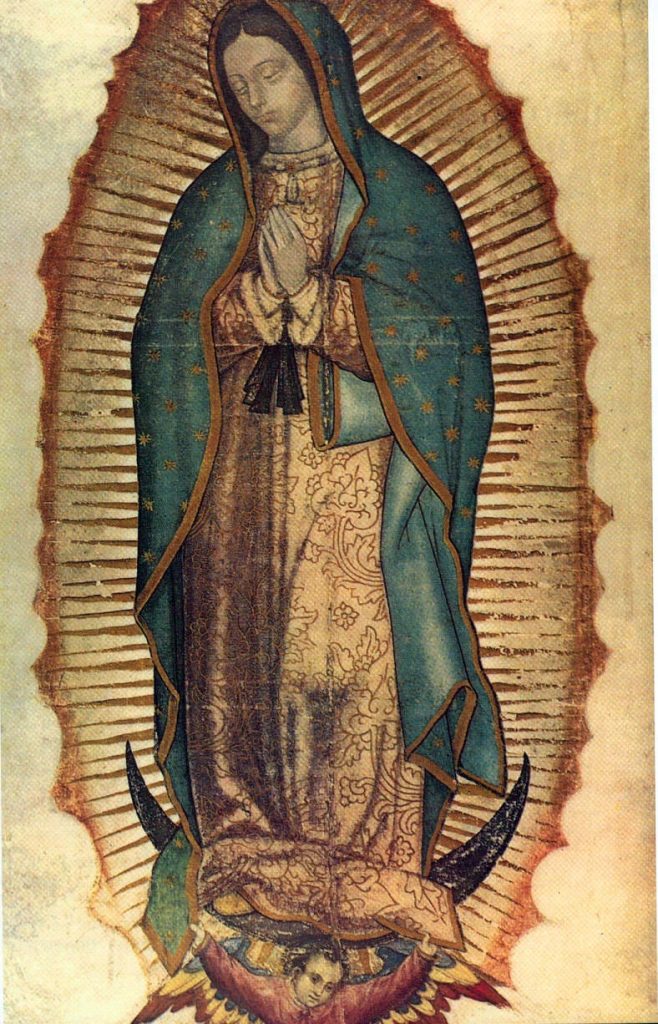
Tues, Dec 12: Feast of Our Lady of Guadalupe In December 1531 Mexican peasant Juan Deigo experienced a series of Marian apparitions on Tepeyac Hill, located within a suburb of present-day Mexico City. The first apparition featured a young woman who said she was Mary, “Mother of the True God”, and asked that a church be built at the site in her honor. At the guidance of his local bishop, Juan asked Mary during a subsequent apparition for a miraculous sign as proof of her identity. That proof would be the imprinting of an image of herself on Juan Diego’s cloak along with many blooming Castilian roses, flowers not native to Mexico! During the course of the apparitions, Juan Diego’s uncle fell deathly ill, but miraculously recovered aided by the intercessions of Mary as reported in a vision by his uncle, at which time Mary requested that she be known under the title of Guadalupe. A chapel and then eventually a basilica was constructed at the foot of Tepeyac Hill. The basilica holds to this day Juan Diego’s cloak with the image of Mary (see picture).
Wed, Dec 13: Memorial of St. Lucy (283 – Dec 13, 304) A fourth century virgin martyr under the persecution of emperor Diocletian, legend has it that Lucy would wear a candle wreath while bringing food to Christians hiding in the Roman catacombs. Tradition also holds that she denied marriage which prompted her suitor in vengefulness to accuse her of being Christian. This ultimately led to her martyrdom with legend stating that attempts were made to cut her throat and gouge her eyes, but she still had her speech and eyesight. Consequently, Lucy is the patron saint of the blind and eye disorders with several prayers asking for Lucy intercessions concerning good eyesight.
Thurs, Dec 14: Memorial of St. John of the Cross (Jun 24, 1542 – Dec 14, 1591) Ordained a Carmelite priest at 25, John met Teresa of Avila (both coming from the same area of Spain) and the two worked together in an effort to reform some of the lax and immoral behaviors of other clergy and religious of their age. Their efforts faced backlash leading to John’s imprisonment and regular lashings performed in public. He would eventually be released as tensions among religious authorities were resolved and went on to write his most famous work called The Ascent of Mount Carmel chronicling the soul’s journey in seeking perfect union with God. This work along with others eventually led him to becoming known as the “mystical doctor” in the Church. John also founded several monasteries before falling ill and dying on this day in 1591.
Two Week Bonus in Church History: November 26-December 9
With the recent Thanksgiving Holiday, we are covering 2 weeks by taking a look at three early Church figures, including the patron saint of our parish, the original Santa Claus, and among other things the patron saint of beekeepers (say what!?). Plus another major feast day concerning the life of the Blessed Virgin Mary approaches.
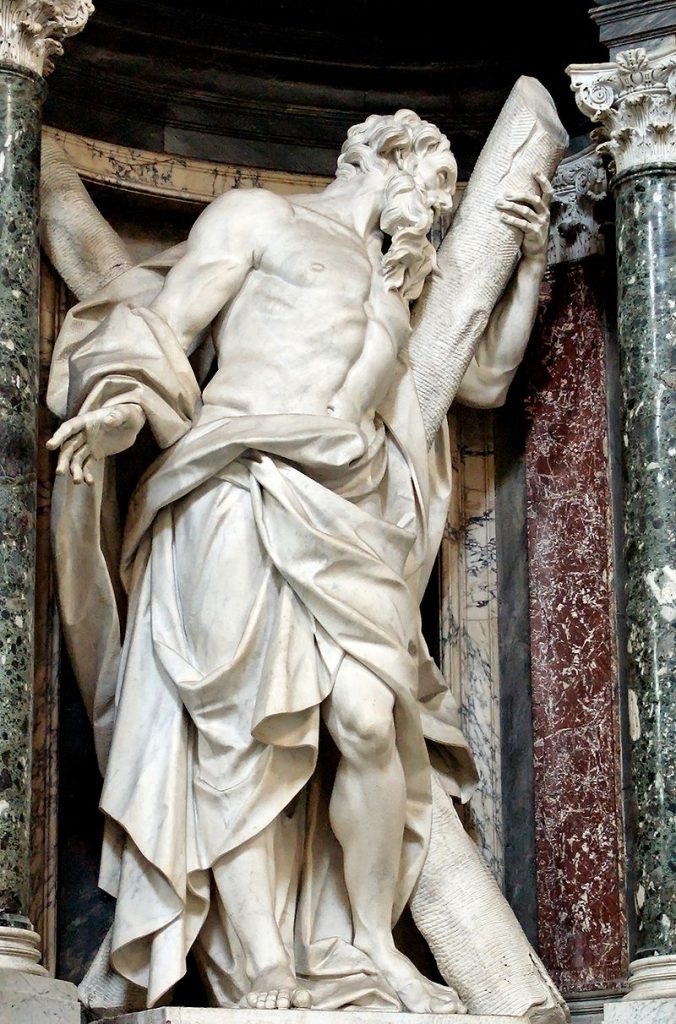
Thur, Nov 30: Feast of the Apostle Andrew As brothers, both Andrew and Simon Peter from the town of Bethsaida in Galilee (an area in present day northern Israel and southern Lebanon) are mentioned in the Gospels of Matthew, Mark and Luke as being called by Jesus while working as fisherman. However, John 1 offers additional insight by mentioning how Andrew, being a disciple of John the Baptist, met Jesus first and then brought news of Jesus to his brother proclaiming “We have found the Messiah!” Peter would then proceed to meet Jesus for the first time most likely. The Gospel of John also records some of Andrew’s words from the feeding of five thousand when he introduces a boy, who had a few fish and loaves. Beyond those accountings there is not much recorded specifically about Andrew within the Bible. Some non-biblical writings suggest Andrew traveled far north after Christ’s resurrection to areas around the Black Sea, establishing the See of Byzantium (later called Constantinople and now Istanbul, Turkey) and eventually into modern day Ukraine, Russia, and Romania with his martyrdom by crucifixion in Greece around AD 60. In particular, it is believed a second century Acts of Andrew chronicled many of Andrew’s miracles and travels from which a 6th century version compiled by St. Gregory of Tours served as the foundation for what remains today.
Wed, Dec 6: Memorial of St. Nicholas (Mar 15, 270 – Dec 6, 343) The original Santa Claus is believed to have been a bishop in an area of present-day southern Turkey. Although no writings by Nicholas or contemporary chroniclers still exist, the Church of St. Nicholas in Myra goes back to the reign of Theodosius II in the first half of the AD 400s suggesting Nicholas’ early recognition within the Church. Later documentation mentioned he attended the Council of Nicaea in AD 325 while also chronicling his acts of charity to the poor. One story in particular claimed he secretly tossed a bag of gold three times through the window of a poor man who could not provide dowries for his three daughters’ weddings. A custom of gift giving on his feast day soon developed and over time the name Santa Claus surfaced, coming from Dutch traditions, which called St. Nicholas – Sinterklass.
Thurs, Dec 7: Memorial of St. Ambrose (337 – Apr 4, 397) The life of Ambrose, bishop of Milan, was already chronicled in part with the memorial of his death in early April. However, the Church actually celebrates Dec 7th as his feast day in recognition of the day he was consecrated bishop. While he initially offered his civil services towards helping ensure a peaceful election of a new bishop after the previous bishop’s death, the people ended up publicly acclaiming him their new bishop! He is a Doctor of the Church for his many writings and played a pivotal role in the catechesis of St. Augustine. He was not afraid to stand up against the emperor at times and was quoted as saying “The emperor is in the Church, not above the Church.” It was during a conflict with the emperor concerning the potential seizure of a church building that he literally barricaded himself with a congregation. During the time spent, coordinated hymn singing was employed, something that carried over as part of future Mass rites to the present day. One interesting story concerning Ambrose recounts that while an infant a swarm of bees settled on his face, leaving behind a drop of honey. While some took this as a sign of his future success in speaking and writing (aka honeyed tongue), the legend stuck (pun intended) leading to him being the patron saint of beekeepers, in addition to beggars, learning and the city of Milan.
Fri, Dec 8: Solemnity of the Immaculate Conception. This Holy Day of Obligation for the Church recognizes the conception of the Blessed Virgin Mary free from the stain of original sin. While the Church recognized this belief through history as suggested by the writings of early Church fathers such as Justin Martyr (2nd century), Irenaeus (3rd century) and Cyril of Jerusalem (4th century) and recorded feast day celebrations going back to the 7th century, it was not until Pope Pius IX’s 1854 papal decree Ineffabilis Deus where it was declared as infallible dogma of faith. This particular tenet of faith tends to be one of the more controversial topics within ecumenical discussions between Catholics, Orthodox, and Protestants. Sometimes Catholics and non-Catholics will also incorrectly associate this feast day with Jesus’ conception instead of Mary’s.
Upcoming Week in Church History: November 19-25
This week we take a look at one of the early events in the life of the Blessed Virgin Mary, one that is not documented in the New Testament, but has been part of Church Tradition from very early times. We also recall the lives of a young lady of Roman nobility, who became an early Christian martyr, and a group of 17th-19th century Vietnamese martyrs.
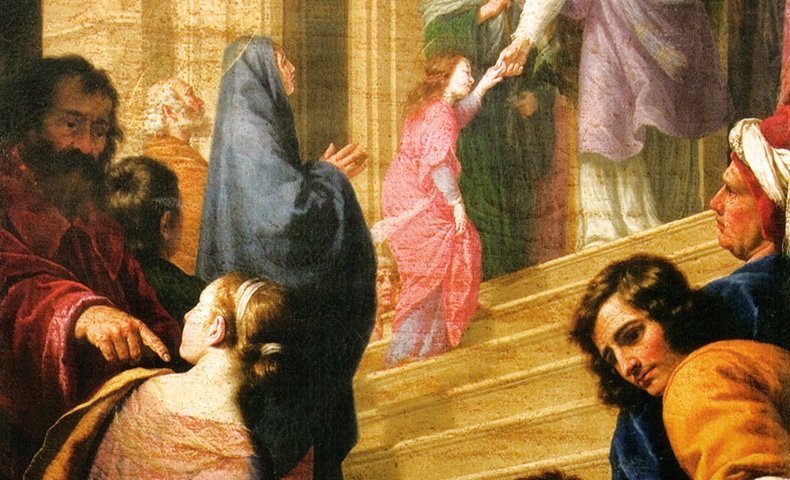
Tues, Nov 21: Memorial of the Presentation of the Blessed Virgin Mary Although not recorded in the New Testament, the 2nd century Gospel of James (aka Protoevangelium of James) recounts when Mary’s parents (Joachim and Anne) decided to consecrate her to God by bringing her to the Temple in Jerusalem at the age of three in thanksgiving for her birth. The story says that Mary lived in the Temple area until twelve at which time the high priest, Zacharias, received a visit by an angel telling him to gather the widowers with their rods and a sign would be shown from which one would be chosen to be Mary’s guardian. Some traditions held that both of Mary’s parents had already died at this point. Zacharias gathered the widowers’ rods, prayed, and then distributed them back to the widowers. Upon Joseph receiving his rod, a dove came out of it and flew upon Joseph’s head. Joseph was initially reluctant as he had other children and was old, but he accepted. The 13th or 14th century Golden Legend modified the story some by stating that among the rods gathered and placed on the altar, the one who owned the rod that flowered, which turned out to be Joseph, would be the chosen one to be espoused to Mary. This adapted version of the story is what is commonly shown in many statues/artwork involving Joseph holding a blossoming rod. The feast day of Mary’s Presentation originated with the dedication of a Basilica in honor of Mary under Emperor Justinian I around 534 in Jerusalem near the old Temple. The church has since been replaced with the Church of St. Anne which has existed in the same location since the 12th century.
Wed, Nov 22: Memorial of St. Cecilia (c 200-235) Recognized as one of the early Christian martyrs persecuted before the legalization of the faith, Cecilia is believed to have come from a noble Roman family and lived during the early 3th century. She took a vow of virginity but was forced to marry. Legend has it that she told her husband, Valerian, on her wedding night that an angel was watching over her and he would be punished if he sexually violated her. Valerian asked to see this angel so Cecilia told him to go get baptized by the pope and then he would see the angel. Valerian agreed and saw the angel! Legends concerning her death convey unsuccessful attempts to suffocate her in the baths using extreme heat and to even cut off her head by sword! Instead she was left bleeding and lived for three more days. During that time she asked that a church be built at her home. She is the patron saint of musicians and often depicted in artwork with a musical instrument for her singing to God while at her wedding.
Fri, Nov 24: Memorial of St. Andrew Dung-Lac and Companions As documented with many other instances, the initial acceptance of the Christian faith can lead to severe persecution, including death. The situation was no different in Vietnam where the Christian faith first arrived in 1615 through a group of Jesuits. However, periods of persecution over the next three centuries led to an estimated 100,000 to 300,000 martyrs of the faith in the area. In 1832, all foreign missionaries were banned. It was during this ban that priest Andew Dung-Lac was captured and executed. Dung-Lac is part of a representative group of 117 martyrs who were canonized by Pope John Paul II in 1988.
Upcoming Week in Church History: November 12 – 18
This week we look at the life of the first US citizen to be canonized a saint, who despite her health and fears of water would travel by sea between Europe and America more than 30 times! We also recall the life of a young 13th century royal Hungarian princess known for her piety who is quoted as saying “How could I bear a crown of gold when the Lord bears a crown of thorns? And bears it for me!”
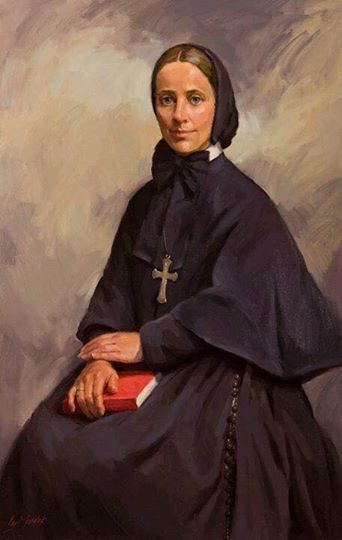
Mon, Nov 13: Memorial of St. Francis Xavier Cabrini (July 15, 1850 – Dec 22, 1917) Recognized as the first US citizen to be canonized, Mother Cabrini was born Maria Francesca as the youngest of 13 children in what is today the region of Lombardy in northern Italy. After her parents death in 1870, she desired to be admitted into the Daughters of the Sacred Heart of Arluno but was told her health was too frail to join (note: Cabrini was born 2 months prematurely and had a delicate health throughout her life). She instead worked at an orphanage before founding in 1880 a religious community of her own called the Missionary Sisters of the Sacred Heart of Jesus focused on teaching and caring for orphans. At the urging of the pope and despite her fear of water and drowning, she traveled to New York in 1889 to continue her missionary work with a focus on the Italian immigrants. In subsequent years she founded several hospitals as part of 67 missionary institutions in several cities across the US while also becoming a naturalized US citizen in 1909. Mother Cabrini died from battling malaria on Dec 22, 1917. Her currently assigned feast day of Nov 13 marks the day she was beatified by Pope Pius XII in 1938. She is the patron saint of hospital administrators and immigrants.
Fri, Nov 17: Memorial of St. Elizabeth of Hungary (July 7, 1207 – Nov 17-1231) The daughter of the King of Hungary and living as a contemporary to St. Francis of Assisi, Elizabeth modeled her life after the new Franciscan Order. Married at the age of 14 she had three children and became a widow before the age of 21 when her husband died while on Crusade. From that time on she lived a life as a nun, joining the Secular Franciscan Order, ministering to the poor and giving alms, despite strong pressures to marry again in order to advance her family’s political ambitions. Her most famous miracle story involved a case where she secretly made bread for the poor, but upon being asked by her husband what she was hiding under her cloak in order to calm suspicions by some that she was stealing from the treasury, a bouquet of white and red roses fell from her cloak instead! Elizabeth died from declining health at the young age of 24. She is the patron saint of bakers and Catholic Charities.
Upcoming Week in Church History: November 5-11
“Hitherto I have served you as a soldier; allow me now to become a soldier to God. Let the man who is to serve you receive your money. I am a soldier of Christ; it is not permissible for me to fight.” This week we recall the life of a man who turned away from military life and would later become an early bishop of the Church in France. We also recognize the oldest church of Rome and a 5th century pope who became a Doctor of the Church.
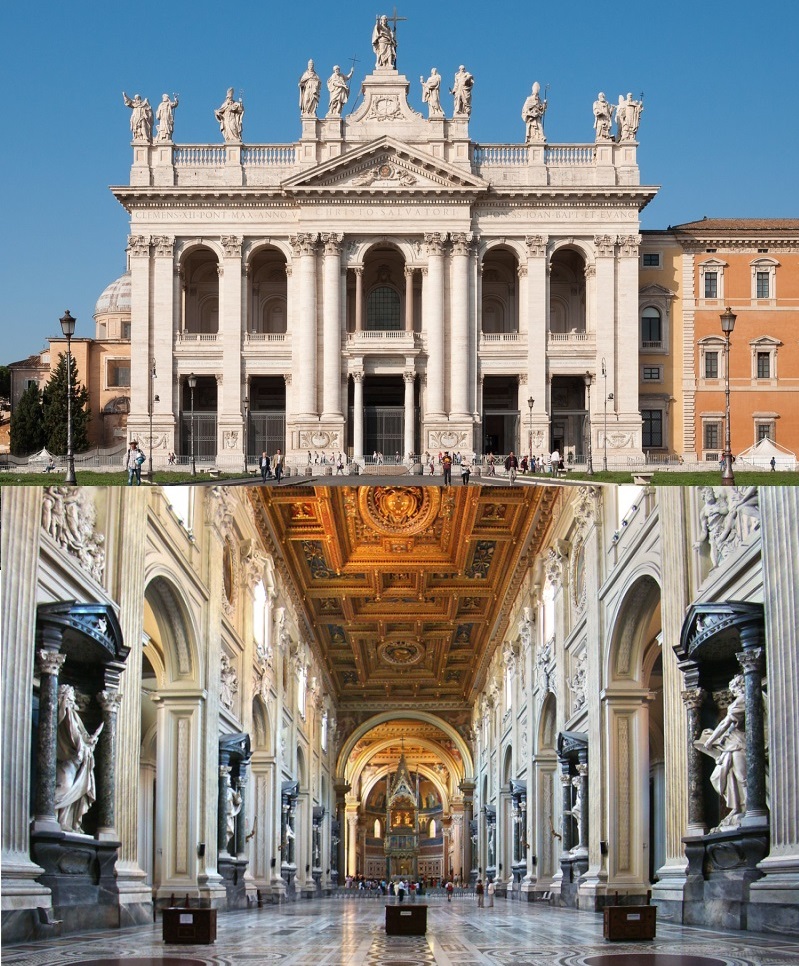
Thurs, Nov 9: Feast of The Dedication of the Lateran Basilica Serving as the cathedral church for the Diocese of Rome (see picture) and thus the seat for the bishop of Rome, the pope, the Lateran Basilica was founded in AD 324 over the remains of a Roman fort. Constantine the Great would donate the land around AD 311 consisting of the Lateran Palace, which had been previously owned by the wealthy Laterani family. The Lateran Basilica would be built as an extension to the palace within a few years with tradition suggesting that Constantine himself helped with the construction along with the donation of many furnishings.The Lateran Palace would become the pope’s residence for the next approximate thousand years until moving over to the Vatican after fires in the 14th century severely damaged the structure. A major reconstruction project occurred in the 16th century followed by renovations of the interior in the 17th century and the completion of its current facade in the 18th century. Pope Pius XII used the complex as a safe haven for a number of Jews during World War II. It is the oldest public church in Rome and the oldest basilica in the Western world. Along with St. Peter’s Basilica (Vatican), St. Paul’s and St. Mary Major, the Lateran Basilica represents one of the 4 papal or major basilicas of the Church, all located in Rome.
Fri, Nov 10: Memorial of Pope St. Leo the Great (400 – Nov 10, 461) Believed to be a Roman aristocrat from the region of Tuscany, Italy, Leo is best known for his Tome as pope, which definitively answered ongoing debates and heresies concerning the nature of Christ. He declared Christ to be fully man and fully human united in one person. This teaching would be formally approved at the Council of Chalcedon (in present day Turkey) in AD 451. Leo served as pope from AD 440-461 during a time of heavy invasions by barbarian tribes. In addition to his doctrinal teaching, he is also famously known for meeting with Attila the Hun as his forces approached Rome in AD 452, convincing Attila to turn back. Unfortunately, Rome would be sacked in AD 455 by the Vandals. Dying on this date in AD 461, Leo I along with Gregory I (r 590-604) are the only popes to be proclaimed Doctors of the Church.
Sat, Nov 11: Memorial of St Martin of Tours (316 – Nov 8, 397) Born in present day Hungary to a military officer, Martin would confess the Christian faith in his youth as he also entered a military life. While stationed in Gaul (present day France), he had a conversion towards seeking to be a “soldier of Christ” and refused to fight anymore (see quote at beginning). He traveled to Tours, becoming a disciple of Hillary of Poitiers and a monk around AD 361 while also helping establish one of the oldest monasteries in Europe. Upon the death of the bishop in Tours, Martin was acclaimed the next bishop, a position he reluctantly took, but held until his death. Martin proved to be a great administrator, establishing a parish system within his diocese where he would visit each parish once-a-year while also continuing to set-up monasteries. The most famous story associated with Martin centers around an event while a military officer. While entering a city, he saw a scantily clad beggar at which point he cut his cloak in half and gave one half to the beggar. This legend has led to his common portrayal in artwork as being on a horse dividing his cloak to give away. Martin is the patron saint of horses and soldiers.
Upcoming Week in Church History: October 29-November 4
“Be sure that you first preach by the way you live.” -Charles Borromeo. While this week we recall all the faithful departed, both those in heaven and in purgatory, we also look in particular at the life of a leader during the early years of the Church’s Counter-Reformation movement.
Wed, Nov 1: Solemnity of All Saints Day With its beginnings documented as early as the 4th century, various locations would initially commemorate at different times of the year all Christian martyrs with May 13 and November 1 being the most commonly recognized dates. Over time the commemoration would expand to include all saints, known as the Church Triumphant, the souls residing in heaven . While historical records are a bit uncertain, some scholars believe that the November 1st date may have originated in Ireland as a replacement for a Celtic harvest festival celebrated on that same date. However, other scholars point to Germany as being the origin of the date’s establishment. The feast day would not be assigned a universally recognized date until Pope Gregory IV in the 9th century designated it on November 1st as a Holy Day of Obligation. The vigil of All Saint’s Day (aka All Hallows’ Eve) would in modern times become superseded by the largely secularized holiday of Halloween.
Thurs, Nov 2: All Souls Day As follow-on to All Saints Day, All Souls Day serves as a day of remembrance for all of the faithful departed who are in purgatory waiting to enter heaven. As taught by the Church, it is believed that those still living can pray for the departed souls in purgatory to help assist their purification. Praying for the dead has its biblical roots in 2 Maccabees 12:39-45, which chronicles an after-life purification act done by the Jews for those that had recently died.
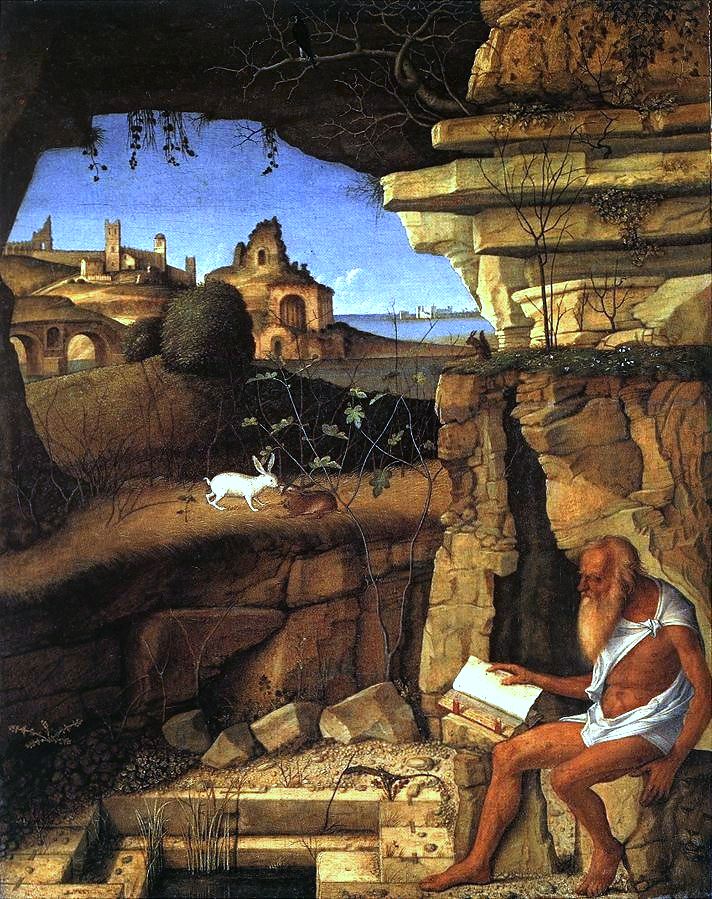
Sat, Nov 4: Memorial of Charles Borromeo (Oct 2, 1538 – Nov 3,1584) Living during the Protestant Reformation era of the 16th century, Charles was born into a wealthy family in the northern Italian region of Lombardy. Thanks to nepotism (his uncle was Pope Pius IV), he was made an administrator and then archbishop of Milan during his early to mid 20s. However despite his youth he took his position seriously and actually resided in his diocese, something that had not been done for almost a century in that diocese and a practice that unfortunately had grown increasingly common with bishops during that era. The diocese held some 2000 parishes and 3000 priests but Charles saw that reforms were necessary among the clergy so he established seminaries. Likewise, he made education of the laity important with the establishment of over 700 catechetical schools. All this led to Charles’ eventual designation after death at a rather young age of 46 as the patron saint of catechists and seminarians. Perhaps Charles’ most noteworthy and lasting impact on everyday Catholic life came with the introduction of the confessional as a piece of furniture to help facilitate greater participation in the sacrament of Penance. As one of the strongest leaders of the Catholic Counter-Reformation movement he also helped re-convene the Council of Trent in 1562 after it had been suspended for 10 years!
Upcoming Week in Church History: October 22-28
“Faith and Reason are like two wings of the human spirit by which it soars to the truth”. This week we recall the lives of a modern philosophical pope and two Apostles along with an important battle of the Roman Empire, which laid the ground for the flowering of the Christian faith across the known world.
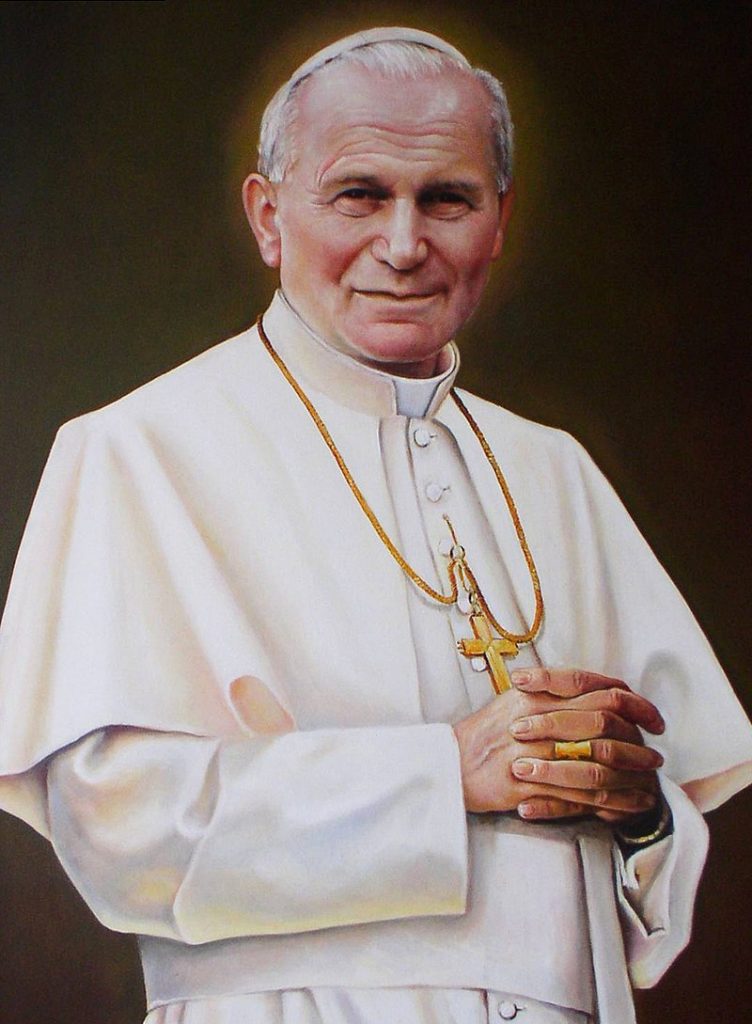
Sun, Oct 22: Memorial of Pope St. John Paul II (May 18, 1920-April 2, 2005): Born Karol Wojtyla in Wadowice, Poland, this future pope would be known for enjoying the outdoors and doing plays during his youth. However, he would lose his mother, father, and older brother before turning 21. His academic career was cut short with the outbreak of World War II during which Karol entered a secret seminary program in Krakow. He was ordained in 1946 and then earned a doctorate in theology in Rome. After stints as a parish pastor and university chaplain while also earning a doctorate in philosophy, Karol would become a bishop in 1958 and attend Vatican II. Inaugurated somewhat surprisingly as pope on this day in 1978 (the first non-Italian pope in 455 years!) John Paul II would end up serving as pope for 27 years, the third longest papacy (only Pius IX and Peter were longer) while surviving an assassination attempt in the process. He was known for being a charismatic world traveler, a proponent of ecumenism between churches, an invaluable diplomat in bringing down Communism in Eastern Europe and the Soviet Union, and the author of World Youth Day. During his last years of life he suffered from Parkinson’s disease. Dying on April 2, 2005, he was beatified under Pope Benedict XVI and then canonized under Pope Francis in 2014. He was a voracious writer, authoring over a dozen books, 14 encyclicals, a few plays and even some poetry.
Sat, Oct 28: Feast of Apostles Simon and Jude (first century AD) As with many of the apostles, little is known about the lives of these two Apostles. Tradition holds Jude to be the same person as Judas (son of James) mentioned in the list of Apostles in Luke 6:16 and Acts 1:13 and the one listed as “brethren” of Jesus (along with James, Joseph and Simon) in Matthew 13:55 and Mark 6:3. Lebbeus or Thaddeus was a name used instead in the list of Apostles in Matthew 10:3 and Mark 3:18 perhaps to distinguish him from Judas Iscariot, which led some to propose that these were all interchangeable names for the same person. Simon is also listed as an Apostle in the Gospels with the title “the Zealot” or the “Cananaean”, both meaning zealous, tacked on to perhaps distinguish him from Simon Peter while also emphasizing his zeal for Jewish law. It may have also meant that Simon was part of an extremist Jewish sect known as the Zealots that advocated a free and independent Jewish nation. This same sect led the rebellion against Rome which ended in the destruction of the Temple in AD 70. Nothing is mentioned in the Gospels about Simon the Zealot’s activities though. Simon and Jude share the same feast day as a result of a Church tradition which had them traveling together evangelizing in Persia before meeting their martyrdom in the early AD 60s. Over time St. Jude became known as the patron saint of hopeless causes perhaps tied to confusion between him and Judas Iscariot (Christ’s betrayer) resulting in no one wanting to pray to the wrong Judas!
Sat, Oct 28: Battle of Milvian Bridge (312) While likely a battle few may be all that familiar with, the events surrounding this battle and its implication on Church history can’t be understated. While traveling to Rome for the impending battle against his rival Maxentius for the emperor’s throne, Constantine the Great and his soldiers saw a vision in the sky that looked like a cross with the Greek words that when translated read “in this sign, you shall conquer”. The symbol became known as the Chi-Rho, a superimposing of the letters X and P, which are the first two letters in spelling out Christ in Greek, and was used by Constantine as a military standard. On Oct 28, 312 the Battle of Milvian Bridge was held as Maxentius surprisingly decided to come outside of Rome with his men versus using the city’s defenses to his advantage. Constantine and his men won decisively, thus laying the way for Constantine to enter Rome and be fully recognized as the Western Roman Emperor. Constantine would credit the victory to Christ and in 313 with the Eastern Roman Emperor, Licinius, declare religious freedom throughout the Roman Empire. The Christian faith no longer had to survive in secrecy but could now be professed openly, which kickstarted a huge expansion of the faith over the next several decades and centuries with Constantine serving as a huge benefactor to the Church.
Upcoming Week in Church History: October 15-21
“See that ye all follow the bishop, even as Jesus Christ does the Father, and the presbyter as ye would the apostles; and reverence the deacons, as being the institution of God… wherever Jesus Christ is, there is the Catholic Church.” This week we remember the lives and work of a 1st/2nd century bishop of the Church in addition to the author of both a gospel and the Acts of the Apostles.
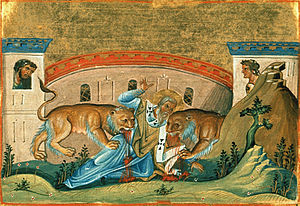
Tues, Oct 17: Memorial of St. Ignatius of Antioch (died early 2nd century AD) Most of what is known regarding this third Bishop of Antioch and disciple of the Apostle John comes from his letters to various churches and his friend the Bishop of Smyrna, St. Polycarp. (Note: St. Peter the Apostle was the first bishop of Antioch, one of the 4 largest cities in all of the Roman Empire at the time, before relocating to Rome.) These letters were written while on a long journey under military escort from Antioch to Rome. While precise dating of his martyrdom is unknown, it is believed Ignatius was condemned to death and fed to the animals as part of the games at the Roman Colosseum during the reign of Emperor Trajan in the early 2nd century (see picture). His letters convey 2 underlying themes: 1) a hierarchical structure of the ecclesial community with bishops, presbyters, and deacons, and 2) an emphasis on unity among all the faithful. His writings are the oldest extant to clearly show the use of the word “Catholic” in reference to the early Church as mentioned as part of a quote at the beginning of this week’s summary.
Wed, Oct 18: Feast of St Luke the Evangelist (first century AD) Tradition holds Luke to be the author of one of the Gospels and the Acts of the Apostles, both written originally in Greek sometime likely in the 2nd half of the first century AD. Debates continue over whether Luke was a Gentile himself or a Hellenized Jew. At the start of Acts, the author references his “first book” (i.e. St Luke’s Gospel) with both works being addressed to a person named Theophilus, which means “friend of God” in Greek and thus imply a generic greeting versus one directed to a specific individual. In the New Testament, Luke is mentioned in three places, all letters attributed to St. Paul, strongly suggesting that Luke traveled with Paul on at least some of his journeys. In a letter to Philemon, Luke is mentioned as assisting Paul’s missionary work. As part of the naming of various people who send their greetings to the Colossians, Luke is mentioned as being a “beloved physician” (Col 4:14). In the letter to Timothy, Paul as part of a request for more help mentions that only Luke remains to assist him. Scholarly work has suggested that in the late 2nd century a prologue was added to St. Luke’s gospel in response to heretical teachings from Marcion, who claimed Jesus was a separate god from the creator God and that Paul was the only true apostle of Jesus. This prologue affirmed the authorship of a gospel and what was now called The Acts of the Apostles to Luke the physician from Antioch. In traditional artwork, Luke is often accompanied by a winged ox or bull, symbolizing life through sacrifice, which is a point of emphasis in Luke’s portraying Christ’s sacrificial death in establishing a new and everlasting covenant. He is the patron saint of artists and physicians.
Upcoming Week in Church History: October 8-14
“What unites us is greater than what divides us.” This week we look at the life of a 20th century pope who was a huge advocate for renewal, peace and unity. He was also responsible for calling the last Ecumenical Council of the Church, which also commenced this week back in 1962.
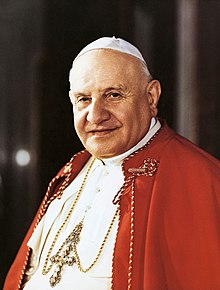
Mon, Oct 11: Memorial of Pope St. John XXIII (Nov 25, 1881 – June 3, 1963) Born Angelo Giuseppe Roncalli in a small northern Italian village, John was the eldest son among 12 other siblings as part of a sharecropper family. At 15 he joined the Secular Franciscan Order and began his seminary studies eventually earning a doctorate in canon law and becoming a priest in 1904. During World War I John served as medical assistance and chaplain. After the war he became involved as a papal representative to multiple countries, including Bulgaria, Turkey, Greece and France. Serving under Pope Pius XII during World War II, John made efforts to save Jews from the Holocaust and played an active role in garnering the Church’s support for the establishment of a state of Israel. While serving later as bishop of Venice, John would be elected pope in 1958. During his papacy he is most well-known for calling the Ecumenical Council to be known as the Second Vatican Council, which opened on Oct 11 in 1962. Unfortunately he died from stomach cancer in 1963 before the council’s conclusion. Earlier in 1963 he became the first pope to be recognized as Time Magazine’s ‘Man of the Year’ due in part from his offer to mediate between the US and USSR during the Cuban Missile Crisis. John would be canonized alongside Pope John Paul II on April 27, 2014 with Oct 11 designated as his feast day in memorial of the opening of the Second Vatican Council as well.
Mon, Oct 11: Second Vatican Council Begins (1962) As mentioned above, this 21st Ecumenical Council of the Church was called by Pope John XXIII. The council convened in St. Peter’s Basilica for a total of four sessions with each session lasting 8-12 weeks in the autumns of 1962-1965. John XXII called the council in order to produce an “aggiornamento” or “updating” of the Church aimed at better connecting with people within an increasingly secularized world that trended toward treating man as God with teachings of the Church being pushed aside in favor of science, while also seeking progress in the reunion of all Christians (i.e. ecumenism). Future popes Joseph Ratzinger (Benedict XVI) and Karol Wojtyla (John Paul II) were present at the sessions along with some 2,500 bishops, abbots and religious superiors, thus the largest attended council by far! Some of the most noteworthy writings of the council centered around divine revelation, the liturgy, the nature of the Church and the Church’s role in the modern world. Unfortunately, misinterpretations of some of the teachings from the 16 documents (4 constitutions, 9 decrees and 3 declarations) led to a fair amount of controversy as some got carried away in claiming some questionable changes made after the council followed the “spirit of Vatican II”. However, as one famous saying goes: “Those who quote the spirit of Vatican II have seldom read the documents.” While the documents themselves did not solemnly make declarative statements of infallible teaching they did incorporate and expound upon prior Church teachings with the bishops serving as the ordinary universal magisterium, whose teachings are to be obediently followed by all members of the Church.
Upcoming Week in Church History: October 1-7
“Angel of God, my guardian dear, To whom his love commits me here, Ever this day be at my side, To light and guard, to rule and guide. Amen.” This week we take a moment to give thanks to our guardian angels in addition to one of the most well-known saints in the Church’s history, and the intercessory power of the Blessed Virgin Mary at one of the most pivotal battles in world history.
Mon, Oct 2: Memorial of the Holy Guardian Angels: In tandem with last week’s feast concerning the archangels Michael, Gabriel and Raphael, this date calls attention to the spiritual beings created by God who are assigned to the specific individual protection of you and I. As mentioned in the Catechism (CCC 328), “The existence of the spiritual, non-corporeal beings that Sacred Scripture usually calls “angels” is a truth of faith. The witness of Scripture is as clear as the unanimity of Tradition.” As purely spiritual creatures, angels have intellect and will, and are immortal. St. Basil is quoted later in CCC 336: “Beside each believer stands an angel as protector and shepherd leading him to life.” Altars dedicated in honor of guardian angels go back to the 4th century and local feast celebrations to at least the 11th century. Pope Paul V added a general feast of the Church in recognition of guardian angels in 1607. A short lyrical prayer to our guardian angels was mentioned at the beginning of this week’s summary.
Wed, Oct 4: Memorial of St. Francis of Assisi (1181 – Oct 3, 1226): Francis was baptized Giovanni to a wealthy family in the small Italian town of Assisi, but his father would call him Francis from an early age. Initially living a lavish lifestyle then soldier until he was captured in 1202 at which time an illness prompted the beginnings of a conversion that saw him lose interest in worldly affairs and turn to a life of poverty and preaching. While visiting a dilapidated chapel (Church of San Damiano), Francis saw the crucifix come alive and say “Francis, go, repair my house, which as you see, is falling completely to ruin.” This event prompted him to sell his belongings to fund the repair of the church. The events caused immense strife between Francis and his father ultimately leading to Francis giving up his inheritance and becoming a beggar. Francis began to form a religious order focused on following in the footsteps of Christ that would officially become the Franciscan Order in 1210. In subsequent years, Francis and his Friar brothers were instrumental in many areas including an attempt during one of the Crusades to convert the Muslim Sultan, being known for an extreme fondness of nature, and the creation of the first living Nativity scene. Francis would carry the stigmata in his final 2 years before dying in 1226. He was declared a saint in 1228 by Pope Gregory IX.
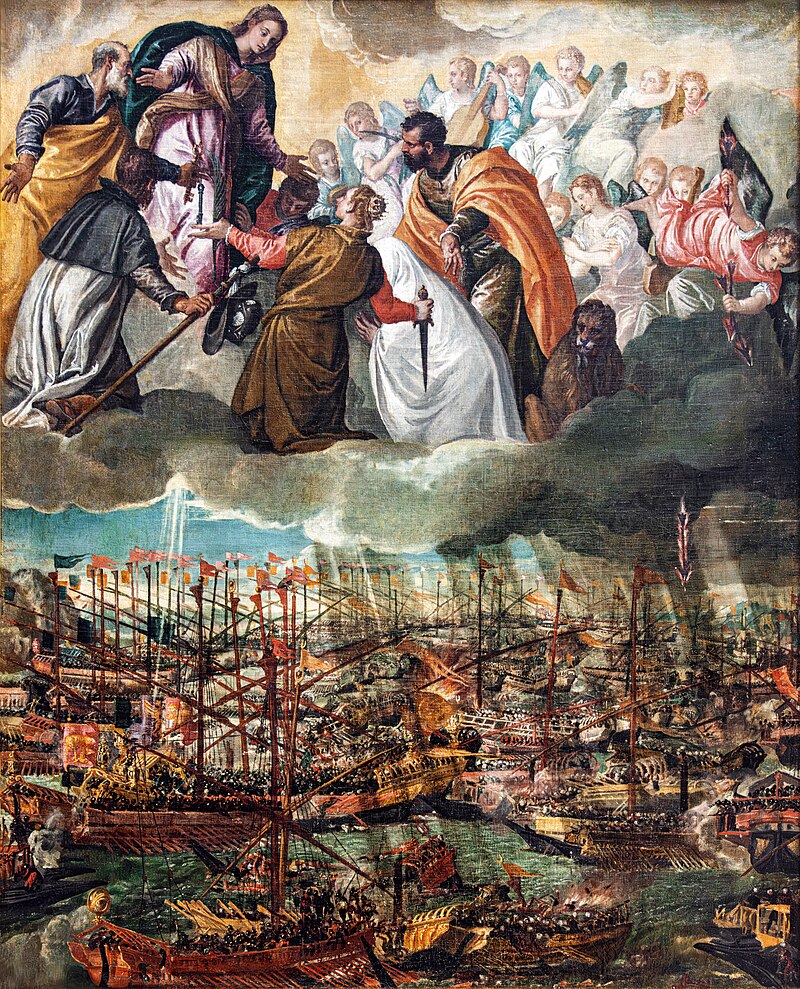
Sat, Oct 7: Memorial of Our Lady of the Rosary: This memorial recalls the victory at the Battle of Lepanto in 1571 where against significant odds a coalition of Catholic ships prevailed over a much larger (reports of at least 3x more men) and strategically advantaged Muslim force at a port in Greece that was on the verge of invading Italy and then perhaps the rest of Europe. Prior to the battle the entire Catholic fleet said the rosary. At one point during the sea battle, the wind inexplicably changed direction giving the advantage to the Catholic fleet. This was at a time when ships had to be rowed into battle where having wind at your back was a huge advantage as it allowed a huge portion of the battle force to be relieved from rowing duties and join the battle. Pope Pius V quickly instituted a feast in recognition of Our Lady’s intercession with the events surrounding the victory of this battle.
Upcoming Week in Church History: September 24-30
And Gabriel said to Mary “Hail, full of grace! The Lord is with you”(Luke 1:28). This week we recall the role of several archangels in salvation history. We also look back at the lives of two very mission-oriented priests, one in the service of the poor and the other who became the greatest translator of Scripture the Church has ever known famously saying “Ignorance of Scripture is ignorance of Christ.”
Wed, Sep 27: Memorial of St. Vincent de Paul (Apr 24, 1581 – Sep 27, 1660) Born in southern France as the third of five children to peasant farmers, Vincent showed an aptitude for literacy early in his life and entered a seminary at age 15. Eventually studying theology at the University of Toulouse, Vincent tutored to help pay his way and initially saw becoming a priest as a way to get away from his humble and poverty-filled beginnings. In 1600 he was ordained a priest at age 19, which at the time was actually against the regulations of the Council of Trent that had set 25 as the minimum age for becoming a priest. So instead of becoming a parish priest, he continued his studies for a few more years. It is believed that Vincent was captured by pirates while traveling in the Mediterranean and sold into slavery in North Africa for 2 years before returning back to France. The confession of a dying peasant turned Vincent’s heart to a life of missionary work centered around Paris which focused on the poor with the financial assistance of wealthy contacts he had established in prior years. His efforts led to the establishment of several charities including the Congregation of the Mission, commonly called the Vincentians, who would go on to found several universities including Niagara, St. John’s and Depaul in the US. Vincent died on this date in 1660 and was canonized in 1737. Pope Leo XIII made him the patron of all charitable societies.
Fri, Sep 29: Feast of Sts. Michael, Gabriel, and Raphael: Representing the archangels category, which are within the third tier of the Christian hierarchy of angels, Michael, Gabriel and Raphael are the most commonly mentioned in literature, each with his own special assignment. Michael, meaning “Who is like God?” in Hebrew, is described as the chief of the angels and archangels and mentioned specifically in Jude 1:9 and Revelation 12:7 as leading the battle against the devil and his angels with artwork typically depicting him with a sword battling against a serpent or evil. Conversely, Gabriel, meaning “God’s strength” is portrayed in scripture as an important messenger between God and man, in particular appearing to Daniel to help explain his visions and proclaiming announcements to Zechariah about the pregnancy of his wife with John the Baptist and to Mary about her pregnancy with Jesus. We learn of Raphael, which means “God has healed” in Hebrew, in the Old Testament Book of Tobit as he came to heal the eyesight of Tobit and remove a demon from Sarah, who had caused the death of seven husbands prior to her marriage of Tobit’s son Tobias.
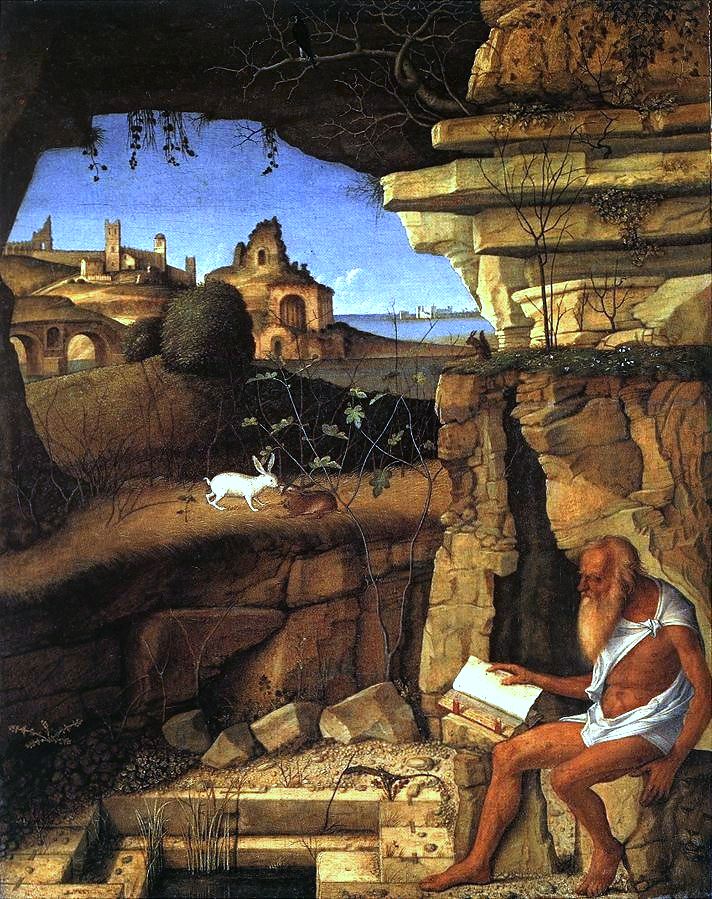
Sat, Sep 30: Memorial of St. Jerome (342? – Sep 30, 420): Born in present-day Croatia or Slovenia (the town’s exact location is unknown) with the name Eusebius Hieronymus, Jerome traveled to Rome to continue his studies at which time he was baptized. Turning to an ascetic life he lived near Antioch, becoming a priest, then Constantinople, meeting other well-known theologians of that age such as Gregory of Nazianzus and Gregory of Nyssa. Jerome’s representation as a theologian drew the attention of Pope Damasus I who instructed him to begin the work Jerome was most known for, a more accurate Latin translation of Scripture, later known as the Vulgate. He initially did translations of the New Testament but while working on the Old Testament he found the various Greek manuscripts he was utilizing wanting with too many variations and discrepancies among them. His welcome in Rome had somewhat run out too as he garnered a reputation for being bad-tempered and critical in his writings. He even criticized the quick elevation of St. Ambrose from a civil servant to bishop of Milan. He turned his attention to Hebrew manuscripts and relocated to the area of Jerusalem where he would remain for the rest of his life, including a large portion of time in a cave believed to be the birthplace of Jesus (see picture), as he continued translations and commentaries on the Bible until dying on this date in 420. Jerome is a Doctor of the Church and the patron saint of librarians, scholars, and translators.
Upcoming Week in Church History: September 17-23
From the extraordinary example of faith by a group of 19th century Korean martyrs to the feast of one of the Apostles and Evangelists of the Gospels to a 20th century “flying monk”, we have quite the assortment of saint lives to recall this upcoming week.
Wed, Sep 20: Memorial of Sts. Andrew Kim Taegon (Aug 21, 1821 – Sep 16,1846) and Paul Chong Hasang and Companions (1839-1867): The first native Korean priest, Andrew Kim, was the son of Christian converts. After being baptized at 15, he traveled 1300 miles to a seminary in China. After his training and ordination, Andrew Kim worked within Korea, then under strict Confusian control that strictly prohibited Christianity, to have more missionaries enter the country secretly until he was caught, tortured and beheaded in 1846 at just the age of 25. He is the patron saint of Korean clergy. Paul Chong, a lay married man and several others (total of 98 Koreans and 3 French missionaries) who died for their faith in Korea between 1839 and 1867 are also recognized with this memorial established by Pope John Paul II in 1984. Religious freedom in Korea was finally achieved in 1883.
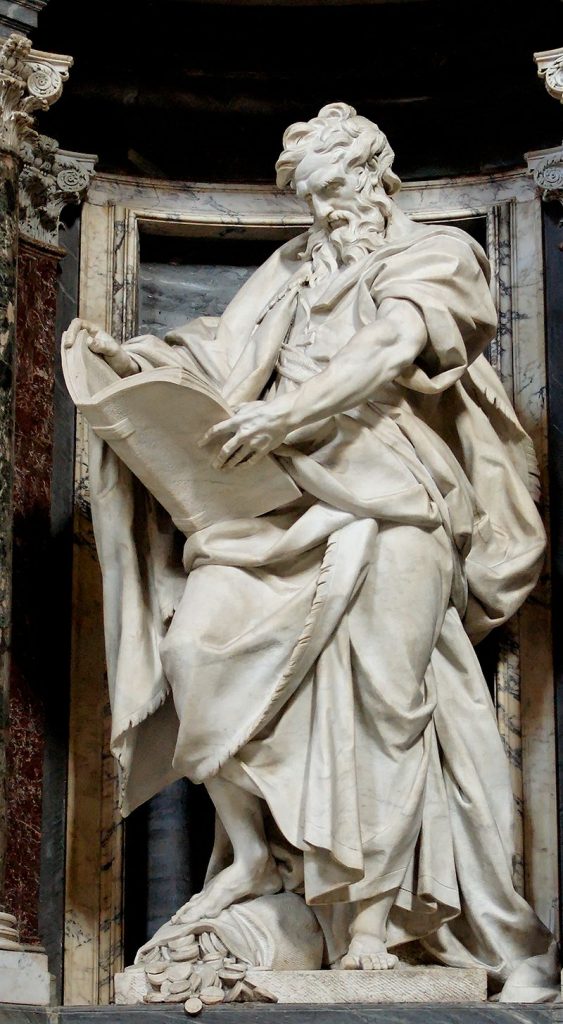
Thu, Sep 21: Feast of St Matthew (1st century AD): Named as one of the 12 apostles of Jesus with tradition holding him to be the author of the Gospel with his name, Matthew’s life like many of the apostles is fairly unknown. While all three synoptic Gospels (Matthew, Mark, Luke) record the calling of a tax collector to follow Jesus, Mark and Luke use the name Levi instead of Matthew. While the commonality of the account suggests probably the same person was being referenced in each Gospel, it is admittedly not clarified in Scripture. Matthew’s Gospel also mentions him hosting a meal with Jesus and other tax collectors and Acts of the Apostles mentions him being in an upper room with other apostles after Jesus’s Ascension at which time they decided who would join them as an apostle to replace Judas. But those are all the events mentioned concerning Matthew in Scripture. Historical records point towards Matthew later spreading the Good News to Ethiopia, which is believed to have been the place of his martyrdom as the result of enraging a person of royalty, yet again similar to several other apostle martyrdom stories. While modern debates continue over the Gospel of Matthew’s authorship and whether it’s the first Gospel to be written, some of the earliest Church records such as Papias in the early 2nd century and Irenaeus in the late 2nd century point to Matthew’s authorship in writing a Gospel in Hebrew to a largely Jewish community around Palestine potentially as early as AD 42 at which time the Church was under persecution and may have scattered from Herod Agrippa I (recall that the Apostle James, brother of John, was martyred at this time). One also has to consider the potential for a chronological reason as to why Matthew was always listed first when lists started circulating around that eventually led to the canon of Scriptures.
Sat, Sep 23: Memorial of St Padre Pio (May 25, 1887 – Sep 23 1968): One of the most famously known recent saints declared by the Church, Padre Pio was born Francesco Forgione to a family of farmers in southern Italy. At 15, Francesco joined the Capuchins and took the name Pio. He was ordained in 1910 and drafted for World War I but was discharged after it was discovered he had tuberculosis. During 1918 Pio developed the permanent physical signs of stigmata, which would be present for the rest of his life and become something of a source for garnering celebrity status among people looking to visit his friary. Pio much preferred living a simple, quiet life helping the sick and hearing confessions. Known for having an incredible foresight in knowing why people came to him for confession, he was also known to experience bilocation, including miraculous accounts of him being seen by pilots flying and directing them away from the area of his monastery at San Giovanni Rotondo, thus avoiding bombing to the area during World War II. Pio died on this date in 1968 at which time the stigmata wounds completely healed. He was canonized in 2002 with an estimated 300,000 people attending.
Upcoming Week in Church History: September 10-16
“As a moth gnaws a garment, so doth envy consumes a man.” “If you wish to leave much wealth to your children, leave them in God’s care. Do not leave them riches, but virtue and skill.” “Why not learn to enjoy the little things – there are so many of them.” This week we highlight the life of one of the most famous preachers of the early Church in the East, St. John Chrysostom. Learn more here.
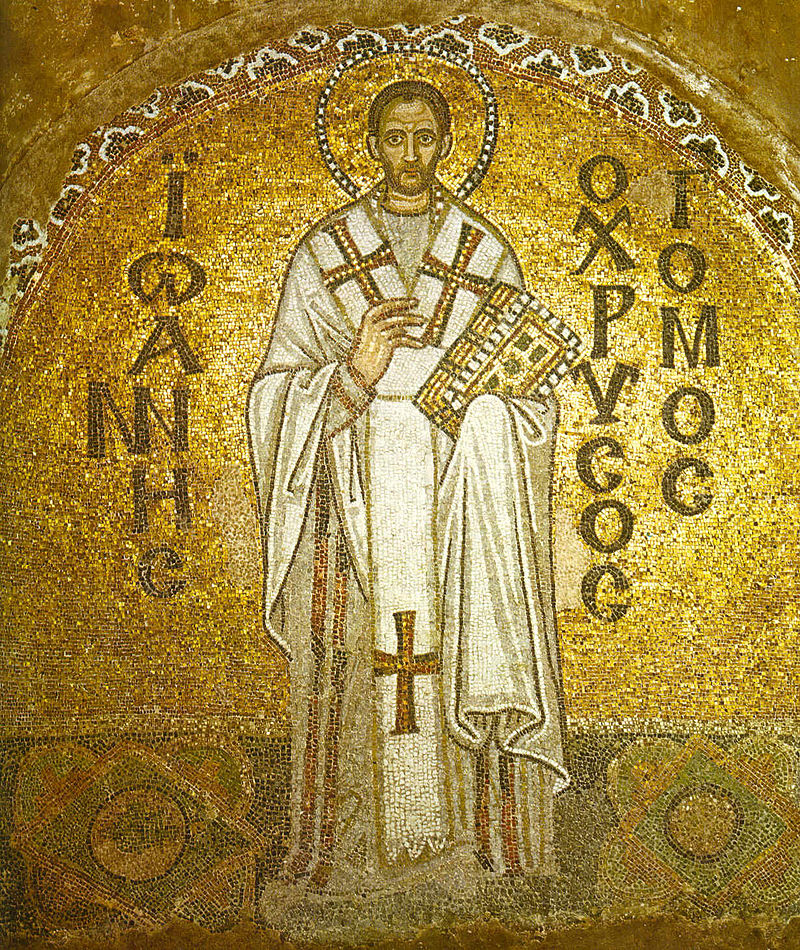
Wed, Sept 13: Memorial of St. John Chrysostom (347 – Sept 14, 407): Born in Antioch (southernmost part of Turkey near the border with Syria) to a military officer, John studied to be a rhetorician and lawyer but grew in the faith and went on to study theology. He lived an ascetic life as a hermit while memorizing the entire Bible before being ordained a deacon in 381 then a priest in 386 and later the archbishop of Constantinople in 397 during a time of political instability. Known as a great preacher, people gave him the name Chrysostomos, meaning “golden-mouthed” after his death. Known as a Doctor of the Church too, he wrote extensively including commentaries on books in the Bible, the liturgy, and hundreds of homilies still extant such as a series of 22 sermons compiled in his Homilies on the Statues. His straightforward and candid approach in ridiculing lavish lifestyles and pagan-like practices while advocating almsgiving did lead to creating some enemies, including royalty, which resulted in his exile eventually in 406. He appealed to Pope Innocent I, who sided with his cause, but John died in 407 while traveling to his place of exile. John is the patron saint of preachers.
Thurs, Sept 14: Feast of the Exaltation of the Holy Cross: In recollection of 1) the finding of the True Cross by St. Helena (mentioned during the week of Aug 13-19), 2) the dedication of churches built under Emperor Constantine the Great on the sites of Jesus’ crucifixion and burial, and 3) the restoration of the True Cross to Jerusalem in AD 629 after falling into Persian hands for a number of years, the Church designated a feast day focused on the veneration of the Holy Cross. Pieces of the True Cross were distributed across the Roman Empire by the 5th century.
Fri, Sept 15: Memorial of Our Lady of Sorrows: Growing in popularity as a form of devotion starting around the 12th century in recognition of the Sorrowful Mother of Christ, this memorial is often depicted in art as a weeping Mary with a heart pierced by either one or seven swords. The first sword alludes to Luke 2:35 and Simeon’s prophecy after seeing the presentation of Jesus at the temple whereby he told Mary that her soul would be pierced by a sword as a result of what would come by her child. The other sorrows of Mary include the flight into Egypt, the loss of the child Jesus in the Temple, the fourth station of the Cross whereby Mary meets her son during his Passion, the Crucifixion, the descent of Jesus from the Cross, and his Burial.
Upcoming Week in Church History: September 3-9
This week we celebrate the Nativity of the Blessed Virgin Mary and highlight the life of a Spanish Jesuit who would become the Apostle to the Slaves in the New World.
Friday, September 8: Feast of the Nativity of the Blessed Virgin Mary: On this day the Church celebrates the birth of Mary, mother of Jesus. While the Bible does not mention Mary’s birth, the Gospel of James, a 2nd century apocryphal text, offers the first known account where we learn her parents’ names were Joachim and Anne. The same text then mentions Mary’s presentation at the Temple at age 3. More on what happened then will be discussed when the memorial of The Presentation of the Blessed Virgin Mary occurs on November 21. The origin of the feast of Mary’s Nativity, also known as Marymas, goes back to the 6th century in the East around the time of the dedication of the Church of Saint Anne in Jerusalem, which was built on the believed spot of Mary’s home. The feast became more commonly celebrated in the West by the end of the 7th century. Within the liturgical year it is celebrated exactly nine months after the solemnity of the Immaculate Conception on December 8.
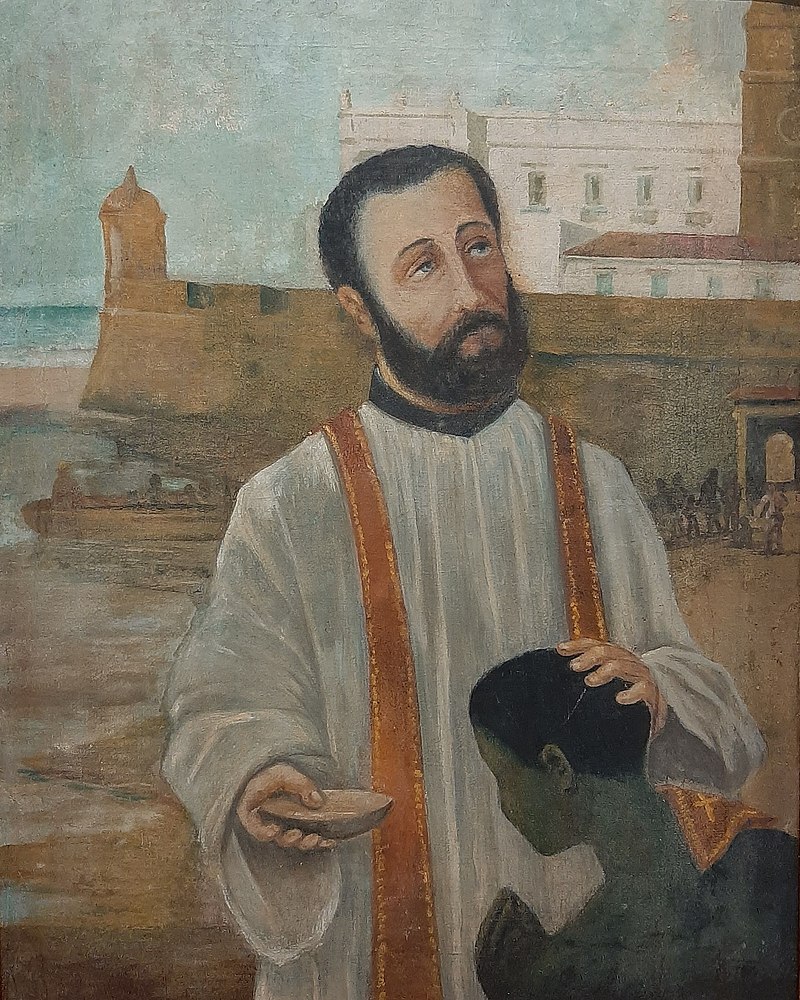
Saturday, September 9: Memorial of St. Peter Claver (June 26, 1580 – Sept 8, 1654): Born in northeastern Spain to a farming family, Peter made a commitment during his university years to dedicate his life to the service of God and became a Jesuit. At a time when New World exploration and slave trading were expanding greatly, Peter volunteered to go to the Spanish colonies, arriving in Cartagena (present-day Colombia) in 1610, never to return back home. Peter completed his studies and was ordained a priest in 1616. Cartagena was a slave-trading hub with around 10,000 slaves arriving each year. Peter would meet the newly arrived slaves on each ship upon arrival, ministering to those onboard. When ships were not arriving, he would travel the countryside, visiting one plantation after another. It is estimated he catechized and baptized around 300,000 slaves during his 40 years of ministry, rightfully earning him the title Apostle to the Slaves! From the after effects of suffering from the plague, he was essentially left paralyzed the last 4 years of his life, dying on this date in 1654. He was canonized by Pope Leo XII in 1888. Peter is the patron saint of African Missions and Colombia.
Upcoming Week in Church History: August 27-September 2
“Not in rioting and drunkenness, not in chambering and wantonness, not in strife and envying, but put on the Lord Jesus Christ, and make no provision for the flesh, to fulfill the lusts thereof.” (Romans 13:13-14). This week we highlight the life and conversion story of one of the intellectual heavyweights and Doctors of the early church, Augustine of Hippo.
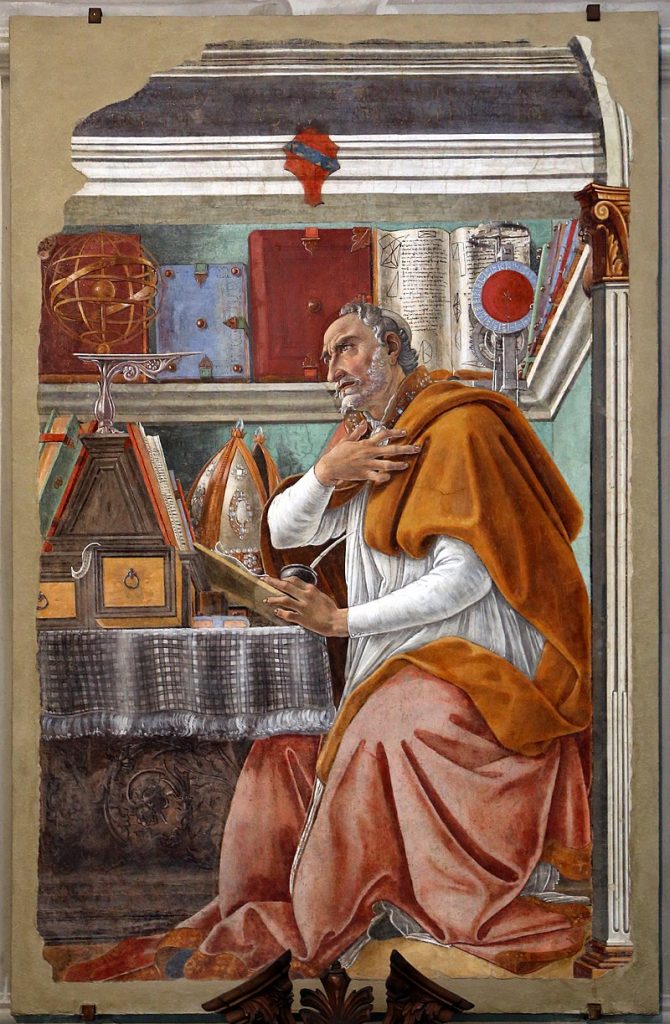
Monday, August 28: Memorial of St Augustine (Nov 13, 354 – Aug 28, 430): Born in modern-day Algeria in northwestern Africa about 60 miles from the Mediterranean to a devout Christian mother, Monica, and a pagan father, Patricius, Augustine would experience a well-documented and winding journey from fully embracing worldly pleasures to the Christian faith as detailed in his autobiography Confessions. A brilliant student, he would initially teach grammar and then rhetoric in N. Africa before moving to Milan, which is where he was finally drawn to the faith under the influence of St. Ambrose, the bishop of Milan at that time. At a pivotal moment as a 31 year old man, Augustine heard a child’s voice from what seemed like a neighbor’s house repeatedly saying “take up and read; take up and read” which prompted him to pick up the Scriptures and randomly read the first passage that his eyes fell on, which were the verses highlighted at the beginning of this week’s summary. Augustine would be compelled to embrace the faith fully and was baptized by Ambrose the following Easter Vigil in 387. He would utilize his skills developed as a rhetorician to now being a preacher and a writer. He wrote on Christian doctrine and conducted biblical exegesis along with composing oppositional work against several heresies of the age. In 395 he was elevated to bishop of Hippo (along the Algerian coast), which he would maintain until his death on this day in 430 at the time the Vandals were besieging the city. The Vandals would eventually burn and destroy the entire city with the exception of the cathedral and its library. Augustine was canonized by popular acclaim and recognized as a Doctor of the Church in 1298. He is the patron saint of brewers (in recognition of his conversion from a life of poor choices/vices), printers (he wrote a lot!), and theologians (arguably the most influential Christian writer of all time). Augustine also established a rule for monks which is followed to this day by the Augustinians.
Upcoming Week in Church History: August 20-26
“Holy Communion is the shortest and safest way to heaven.” – Pope St. Pius X. This week we learn about the first twentieth-century Pope along with an Irish Marian apparition, one of Mary’s many titles of honor, and one of the least known apostles of Christ.
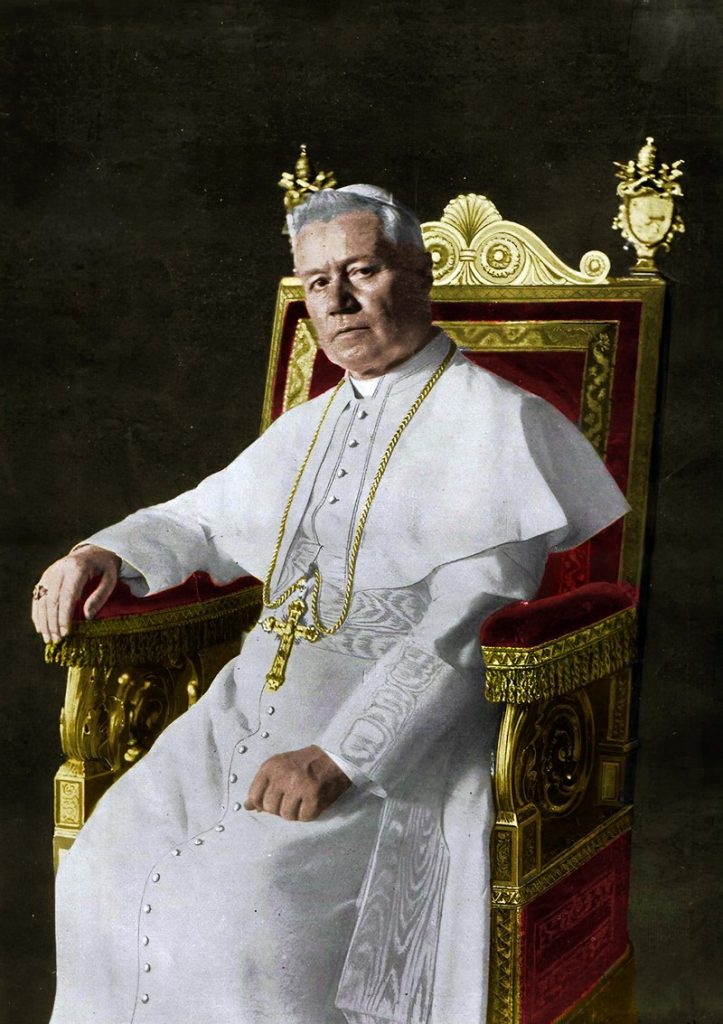
Monday, August 21: Memorial of Pope St. Pius X (June 2, 1835-Aug 20, 1914 ): Born Guiseppe in N. Italy as the second of ten children, Pius X was a typical hyperactive child, but a good student and prayed regularly. Ordained a priest in 1858 and known for being a good teacher and living a simple life throughout, Pius would become a bishop in 1884, a cardinal in 1893 and eventually elected pope in 1903. His papacy is most known for liturgical reforms including a restoration of Gregorian Chant, a renewed emphasis on the Eucharist with frequent reception encouraged, and initiating work on the creation of the first official Code of Canon Law meant to compile and harmonize all the various canons that had been promulgated through the Church’s history. The 1917 Code of Canon Law was the end product. Pius also vigorously opposed the Modernist heresy which included relativism and its diminishing of the objectivity of truth. His motto was “to restore all things in Christ.” He died from failing health on this day in 1914 shortly after the outbreak of World War I. He was canonized in 1954.
Monday, August 21: Marian Apparition in Knock, Ireland (1879): On this day in 1879, a group of 15 people saw an apparition for about 2 hours in the rain at the Church of St. John the Baptist in Knock, Ireland. The apparition included the Blessed Virgin Mary, St Joseph, St John the Evangelist, angels and Christ as the Lamb of God. While nothing was said, rich symbolism was involved and centered on Mary’s relationship to the Eucharist. The apparition was quickly approved by the local bishop and then recognized by the Vatican under Pope Pius XII in 1954, elevating the apparition to a universally approved status of “worthy of belief” within the Church like other well known apparitions, such as Lourdes and Fatima. More recently Pope Francis, who has visited the site too, officially recognized Knock in March 2021 as an International Eucharistic and Marian Shrine.
Tuesday, August 22: Queenship of the Blessed Virgin Mary: Established as a feast day in 1954 under Pope Pius XII, the Church recognizes another special title given to Mary – Queen of Heaven. There are biblical roots to this title going back to the Davidic Kingdom in the Old Testament whereby kings of the line of David would designate their mother a special position known as “Great Lady” or “Queen Mother” given that often times the king would have multiple wives leading to a situation where the mother would in practice be the chief confidant of the king. With Jesus being from the line of David and now the King of Heaven, the “Queen Mother” royal office in Heaven is offered to His mother, Mary, a tradition within the Church that is documented to as far back as St. Ephrem in the 4th century at a time when a fuller development of doctrine continued from the declaration of Mary as the Mother of God.
Thursday, August 24: Feast of Apostle Bartholomew (1-71): Coming from the Aramaic bar Talmay, which means “son of Talmay”, Bartholomew is perhaps one of the most unknown of the apostles with him only mentioned in the list of the twelve apostles recorded in the Gospels of Matthew, Mark and Luke and once in Acts. Tradition holds that Bartholomew is the same person as Nathaneal as mentioned in John’s Gospel Ch. 1 where Philip brings Nathanael to Jesus who says “Before Philip called you, when you were under the fig tree, I saw you.” This comment alluded to Jesus knowing about what may have been a very decisive moment in Nathanael’s past life. Nathaneal then answered, “Rabbi, you are the Son of God! You are the King of Israel!” Stories circulated over the centuries suggesting Bartholomew performed missionary work in India and Armenia (north of Iraq and Iran), where he suffered martyrdom perhaps due to outrage caused by the conversion of the king to the faith.
Upcoming Week in Church History: August 13-19
Prisoner Number 16670 stepped forward and said “I would like to take that man’s place. He has a wife and children.” The commandant asked “Who are you?”. The prisoner replied “A priest.” The volunteer would join 9 other men and be led to a dark isolation block to begin the slow process of starvation. Learn more about this heroic priest during WWII and the mother of the Roman Emperor who helped let the Christian faith shine brightly across the empire.
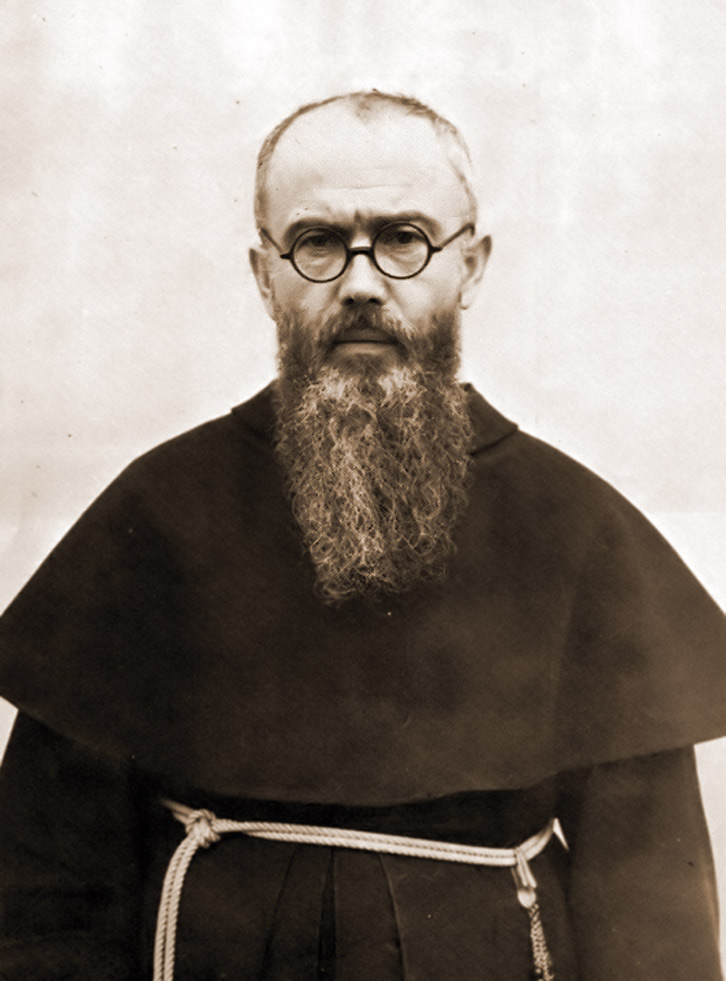
Monday, August 14: Memorial of St. Maximilian Kolbe (1894-1941): Polish priest and Franciscan friar, Maximilian is most known for volunteering at the German concentration camp of Auschwitz during World War II to take the place of another man, who had a family and was chosen to die by starvation in response to the escape of a prisoner around the end of July 1941. After 2 weeks, Maximilian and 3 others from the group sentenced to death were still alive so they were each given a legal injection on this date in 1941. Pope St John Paul II (and fellow Pole) canonized Maximillian on October 10, 1982. The man who Maximilian volunteered to take his place survived the holocaust and was present at the ceremony. In Maximilian’s early life a vision of the Virgin Mary at the age of 12 drew him into a religious life becoming a priest in 1918. He taught and then did missionary work in China and Japan. Returning later to Poland, WWII began and he remained in a monastery until occupied by Germans, leading to his arrest and eventual transport to Auschwitz.
Tuesday, August 15: Assumption of Blessed Virgin Mary + First Missions Arrive in Japan: Affirmed as Catholic dogma by Pope Pius XII in 1950 in his apostolic constitution Munificentissimus Deus, this feast day recalls “that the Immaculate Mother of God, the ever Virgin Mary, having completed the course of her earthly life, was assumed body and soul into the glory of heaven.” The promulgation confirmed a long standing belief going back to the early Church including a statement during the Council of Chalcedon in 451 about Mary’s tomb being found empty shortly after her burial and thus the apostles concluded her body had been taken up to heaven. There are no bone relics of Mary. This day in 1549 also marks when Francis Xavier, one of the original founders of the Jesuits, and his companions arrived in Kagoshima, Japan beginning the initial Christian missionary work in that area. His feast day is celebrated on December 3 (the date of his death).
Friday, August 18: Memorial of St Helena (246-330): As the mother of Emperor Constantine the Great she became an ardent patron of the Christian faith shortly after Constantine’s turn towards the faith. Known as the first Christian archaeologist, she set a precedent for pilgrimages to the Holy Lands. During her journeys around 326-328, she helped pinpoint the sites of Jesus’s birth, death, and ascension leading to churches being built at those locations. Jerusalem had been destroyed in large part in the late 1st century with Roman reconstruction in the 2nd century focused on pagan worship. Thus, some of the original Christian sites, in particular the site of Jesus’ crucifixion and burial, had been covered up. Legends beginning in the late 4th century held that Helena found the True Cross as part of a set of three crosses at an excavation site. The story goes that she was able to ascertain which cross was the one used by Jesus by having a woman who was near death touch each of the crosses, one of which caused a sudden recovery. Other relics such as nails and rope from the crucifixion and Jesus’ tunic were also found and brought to other locations.
Upcoming Week in Church History: August 6-12
When asked by the Roman prefect about the Church’s wealth, the deacon said “I will show you a valuable part. But give me time to set everything in order and make an inventory.” After three days he gathered a great number of blind, lame, maimed, leprous, orphaned, and widowed persons and put them in rows. When the prefect arrived, the deacon simply said, “These are the treasures of the Church.” Learn more about this deacon along with the founder of an itinerant order of preachers and the foundress of an order focused on living a life of poverty and humility.
Tuesday, August 8: Memorial of St. Dominic (1170-1221): Born on this day in 1170 in the Kingdom of Castile (present-day Castile-Leon in northwestern Spain), Dominic was named after another St. Dominic of Silos, a revered Spanish monk. According to legend, prior to his birth his barren mother made a pilgrimage to St Dominic’s Abbey and dreamt that a dog lept from her womb carrying a flame in its mouth that seemed to set the earth on fire. Dominic became a priest at 24 and carried a long mission combating the Albigensian heresy, a new variation of gnosticism which proposed the idea of 2 gods: one good which was the creator of the spiritual realm and one evil which was the creator of the physical realm. In 1215 he formed a new order of itinerant preachers that lived humble lifestyles and helped spread the practice of saying the Rosary which tradition holds was presented to Dominic in a vision from the Blessed Virgin Mary. He died on Aug 6,1221 and was canonized in 1234.
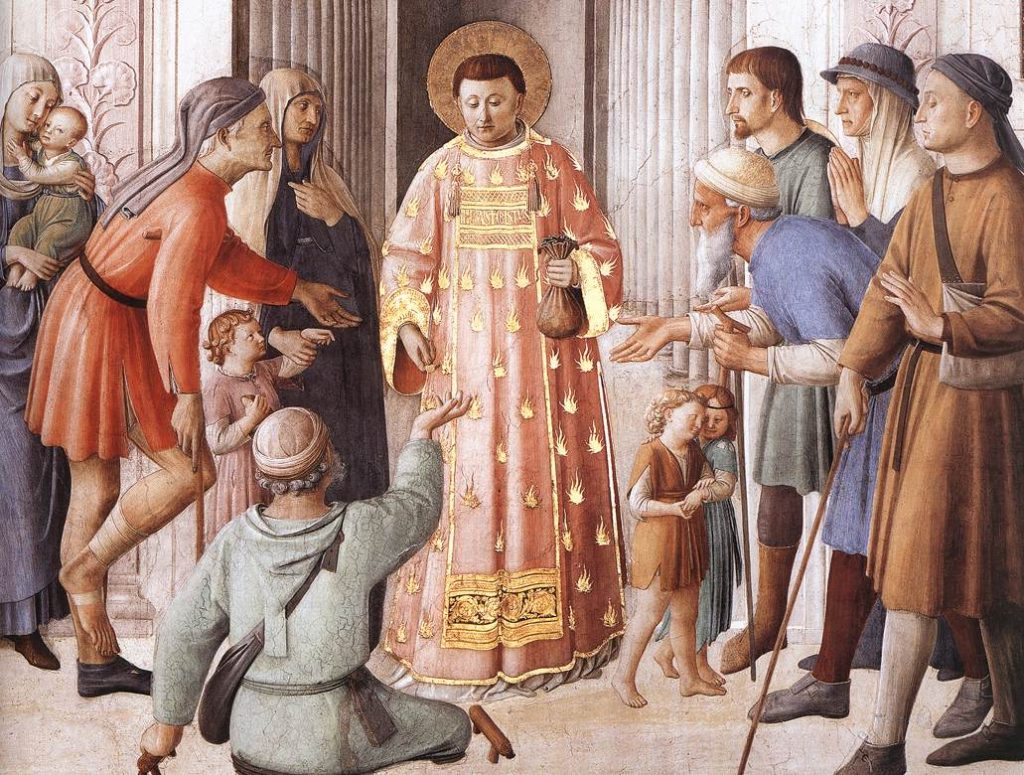
Thursday, August 10: Memorial of St. Lawrence (225-258): A Roman deacon under Pope St. Sixtus II, Lawrence has been a revered early Church martyr throughout much of the history of the Church. Details of his life remain uncertain but tradition holds that he was in charge of the material goods of the Church and the distribution of alms to the poor in Rome (see picture). Upon recognizing the likelihood of his death (note: the pope was martyred a few days before Lawrence’s own martyrdom), he gave away everything he possessed. When asked by the prefect of Rome about the material wealth of the Church, he responded with the quote listed at the beginning of this week’s summary.
Friday, August 11: Memorial of St. Clare (1194-1253): From Assisi, Italy and a contemporary to Francis of Assisi, Clare would seek Francis’ spiritual guidance regularly. Refusing to marry and joining a Benedictine convent, Clare and other women eventually formed a new order now known as the Poor Clares, receiving approval in 1253 just a couple days before her death on Aug 11. The nuns lived a very ascetic lifestyle, walking barefoot, sleeping on the ground, eating no meat, and observing almost complete silence. Clare was canonized in 1255. In 1850, her remains were excavated and showed that while her body had blackened it was still incorrupt at that time.
Upcoming Week in Church History: July 30-August 5
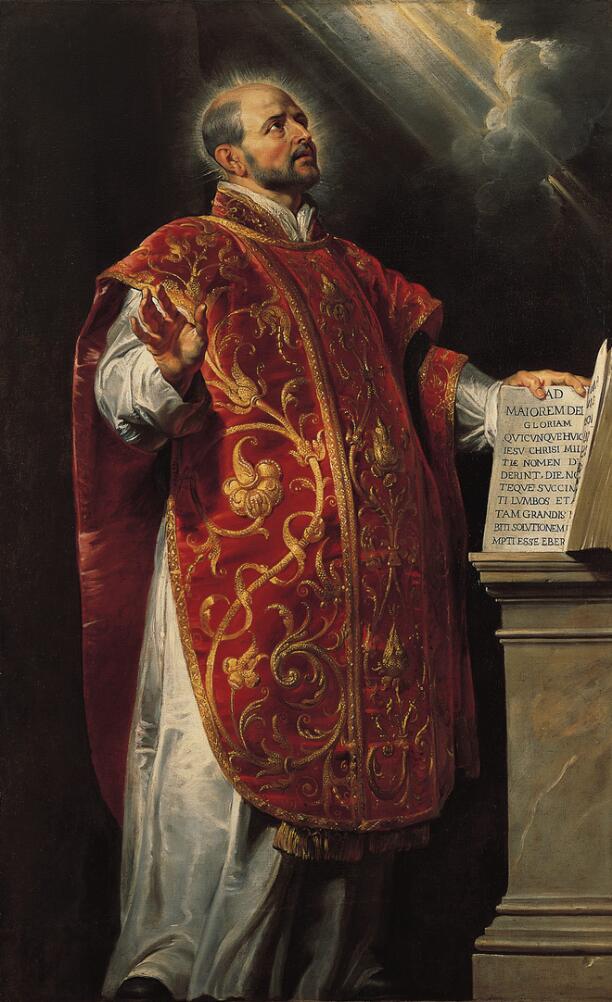
“When you say anything in secret, speak as if you were speaking to the whole world.” “Speak little, listen much.” “The man who sets out making others better is wasting his time unless he begins with himself.” This week learn more about the founder of the Jesuits who shared these nuggets of wisdom along with a Doctor of the Church known for his Marian devotion and a priest who worked as hard as anyone in aiding those seeking the mercy of God.
Monday, July 31: Memorial of St. Ignatius of Loyola (1491-1556): Dying on this day in 1556, Ignatius of Loyola lived a remarkable life. Born Inigo (Ignatius is the Latin version of his name) as the youngest child in a minor noble family in the Basque region of Spain (near the modern day border of Spain and France), he fancied being a knight and spent much of his younger days involved in military exercises until he shattered his leg at the Battle of Pamplona in 1521. While convalescing for months, Ingatius read about the lives of Christ and the saints which prompted a religious conversion that eventually led to the development of a form of meditation known as The Spiritual Exercises and the formation with Peter Faber and Francis Xavier of a religious society known as the Society of Jesus (aka the Jesuits). This order which had a particular focus on education and missionary work from the Far East to the New World of the Americas would be instrumental in initiating a wave of reform within the Church during the 16th century in counteracting the Protestant Revolution of the age. He was canonized in 1622.
Tuesday, August 1: Memorial of St. Alphonsus Liguori (1696-1787): Born near Naples, Italy as the eldest of seven children, Alphonsus was not able to pursue a likely military career due to poor eyesight so he turned his attention to a legal profession. However, after a few years in that profession he felt called to another vocation and became a priest at the age of 30. He suffered from scruples and at one point had a vision of the Virgin Mary. He would be especially known for his devotion to the Virgin Mary in saying the rosary daily and writing in defense of Mariology and about moral theology. He founded the Congregation of the Most Holy Redeemer (aka the Redemptorists) with an initial focus on missionary work in the poor places around Naples but eventually expanding to locations worldwide. He also had a musical talent, writing several hymns. He died on this day in 1787. He was canonized in 1839 and proclaimed a Doctor of the Church in 1871.
Friday, August 4: Memorial of St. John Vianney (1786-1859): Born near Lyon, France as the fourth of six children, John grew up during a time of extreme religious persecution under the French Revolution where many religious practices were held in secret. When Napoleon allowed the re-establishment of the Catholic Church in the early 1800s, John would enter studies to become a priest but it was temporarily interrupted for a period as he hid from being drafted into the army until finally being ordained in 1815. He was appointed a parish priest in Ars, such a small town that John actually got lost trying to find it! He spent much of the remainder of his life re-educating the rural community who had lost an understanding of the faith due to the French Revolution era and became a popular counselor to people in the region, spending up to 16 hours a day hearing confessions! He died on this day in 1859 and was canonized a saint in 1925. His heart has never corrupted!
Upcoming Week in Church History: July 23-29
“Anna, the Lord has heard your prayer, and you shall conceive; and your seed shall be spoken of in all the world.” Thus the angel of the Lord announced the conception of the Blessed Virgin Mary. Learn more about Mary’s parents along with the Apostle James (brother of John) and one of the more famous encyclical letters of modern times, Humanae Vitae, here.
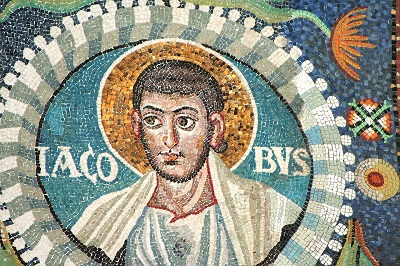
Tuesday, July 25: Feast of the Apostle James (died AD 44?): Known as the brother of the Apostle John, who together were the sons of Zebedee, James (see 6th century mosaic) was a fisherman. He and John were both given the title “sons of thunder” by Jesus, perhaps suggesting fiery temperaments. He was later known as James the Greater to distinguish him as older and/or taller from another apostle named James (see summary from April 30-May 6 for the feast on the other Apostle James). The Acts of the Apostles suggest that James was the first martyr among the apostles, executed by the sword at the order of King Herod Agrippa (grandson of Herod the Great, who had ruled when Jesus was born). Legend has it that his remains are held in Santiago de Compostela in N. Spain, one of the most famous pilgrimage sites in Western Europe going back to the 9th century. Traditions hold that James traveled to preach the Gospel to Spain (he is the patron saint of Spain too) prior to his execution back in Jerusalem. However, there are admittedly doubts by many scholars on the authenticity of these claims given that there are no supporting historical records prior to the 9th century.
Tuesday, July 25: Promulgation of Humanae Vitae by Pope Paul VI (1968): Perhaps one of the most politically controversial encyclical letters in the modern era because of its response to the sexual revolution of the time, Humanae Vitae reaffirmed traditional Church moral teaching regarding the sanctity of life and the role of love and procreation within a marriage. As the document starts out, the “transmission of human life is a most serious role in which married people collaborate freely and responsibly with God the creator.” The document specifically deemed artificial birth control methods as an unlawful way to regulate the number of children as being contrary to God’s design while supporting the use of the natural cycles of infertility for spacing births. Also mentioned are the consequences of artificial methods – increased marital infidelity and the objectifying of women. The second part of the document offered pastoral directives including a focus on self-discipline within married life, decreased sexualized material within culture, and an appeal to scientists to more fully develop our understanding of the natural cycles of infertility.
Wednesday, July 26: Memorial of Sts. Joachim and Anne – Parents of the Virgin Mary (1st century AD): As patron saints of grandparents, Joachim and Anne were the parents of Mary, the mother of Jesus. The little we know of these two individuals actually comes from non-canonical writings. The Gospel of James (written in the 2nd century) describes how the coming of Mary’s birth happened when Joachim was visited by angels as he fasted in the desert for 40 days as a form of penance for the couple’s inability to conceive a child. Similarly around the same time, Anne sent up lamentations to the Lord that were answered by an angelic visit as noted by the quote at the beginning of this week’s summary.
Upcoming Week in Church History: July 16-22
“I was scared to death! Even after all those years of preparation I thought ‘I’m not worthy to do this!’. But I thought ‘I came this far, I guess I should get on with it’.” – Fr. John Durbin reflecting on his ordination and becoming a new priest. Learn more about our pastor’s start as a priest along with the feast of one very significant female follower of Jesus, Mary Magdalene here.
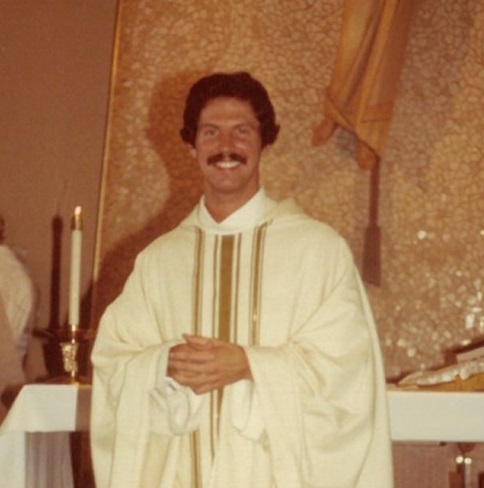
Friday, July 21: Ordination of Fr. John Durbin (1979): From a small town in SW Pennsylvania (Spangler) about 80 miles east of Pittsburgh within the Diocese of Altoona-Johnstown, John Gordon Durbin became an ordained priest on this date in 1979 (see picture). Despite the reservations expressed in the aforementioned quote he’s been “getting on with it” ever since including his current assignment since Summer 2018 at St. Andrew’s. At the time of his ordination there was the opportunity to actually be ordained by Pope John Paul II at St. Peter’s in Rome but Fr. John elected to be ordained by Bishop James J. Hogan at this home parish (St. Patrick’s) so his siblings (4 total) could all be present. Plus it was the home of where his vocation to the priesthood was nurtured. Both the town and the parish no longer exist, at least in name – Spangler is now part of Northern Cambria and the parish is now called Prince of Peace. When asked what may have been one of his biggest misconceptions when becoming a priest, Fr. John said “I thought people would automatically like me because I was a priest! If you change anything in a parish, someone is upset, and sometimes things just need to be changed!” One of the more humorous early situations after becoming a priest was when his father introduced John to someone saying “This is my son Father John.” John replied by saying “Dad, this is not going to work – I can’t be your son ‘father’. After a nice laugh, it was decided that his family would just call him by his first name with nieces and nephews simply calling him ‘Uncle John.’ John preached his first mass by himself, which he recalled was a bit unusual in those days. The topic preached? Each of us has a vocation to build up the Body of Christ because of our baptism. Thank you Fr. John for your vocation and service here to the community of St. Andrew’s.
Saturday, July 22: Feast of St. Mary Magdalene (died around AD 63): Mentioned by name twelve times in the gospels, more than most of the apostles and more than any other woman other than Jesus’s family, Mary came from Magdala, a fishing town in antiquity on the western shore of the Sea of Galilee. Luke 8 mentions Mary Magdalene being healed of seven demons and may have been a wealthy person as part of a group that helped support Jesus’ ministry “out of their means.” According to the gospels, Mary was present at Christ’s crucifixion and burial and perhaps the very first person to see Him resurrected! The portrayal in popular culture of Mary as being a former prostitute is very questionable. The idea first surfaced in the late 6th century under Pope Gregory I. However, there is nothing in the gospels themselves that definitively suggested she was although the interspersion of several people named Mary within the gospels did lead to some conflating of individuals. Tradition holds that Mary traveled to Southern France and lived in a cave until her death.
Upcoming Week in Church History: July 9-15
“Idleness is the enemy of the soul. Therefore the brethren should be occupied at certain times in manual labor, and again at fixed hours in sacred reading.” From St Benedict’s Rule. Learn more about the Father of Western Monasticism, a young Mohawk virgin, and a Scholastic genius here.
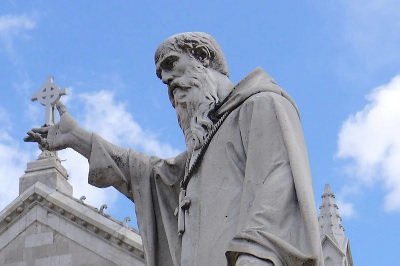
Tuesday, July 11: Memorial of St. Benedict (March 2, 480 – March 21, 547): Later known as the Father of Western Monasticism, Benedict grew up in Norcia, Italy (according to tradition, the twin brother to St. Scholastica) before going to Rome to study. However, he was turned off by the city and through the council of a monk at a nearby monastery in Subiaco ended up living as a hermit in a cave overlooking a lake for 3 years. Benedict was then asked to become an abbot at an area monastery. However, divisions over disciplinary practices escalated to the point that some of the other monks attempted to poison him! Legend has it that their first attempt was to poison him with a drink, but after saying a blessing over the cup, it shattered. A later attempt of poisoning through bread resulted in a raven sweeping down to take it after a blessing was said. Benedict would go on to found 12 monasteries in the area before the most famous of all, Monte Cassino, in 530. Benedict’s most well-known writing is The Rule which described in detail the life of a monastery, later famously summarized by the phrase ora et labora or “pray and work.” His Rule is the most common Rule used by monasteries. It is believed he died at Monte Cassino on March 21, 547. However his feast day is celebrated in July to avoid conflicts with Lent.
Friday, July 14: Memorial of St. Kateri Tekakwitha (1656 – April 17, 1680): Born in a Mohawk village in present day New York to a Mohawk chief and an Algonquin mother, Tekakwitha meaning “she who bumps into things” suffered from smallpox at a young age, which left her with facial scars and impaired eyesight. Losing both her parents and a sibling to the same disease, she was adopted by a relative’s family. As a teenager she resisted marriage and was catechized by a Jesuit missionary, being baptized around 19. Her conversion was not received well within her community so she moved to a Jesuit mission located near Montreal. She was known in her remaining years for a prayerful and ascetical life, taking a vow of virginity. She died during Holy Week in 1680. Shortly after her death reports claimed that her face was remarkably healed of its scars and that she appeared to several individuals. She was canonized by Pope Benedict XVI in 2012. She is also known as the Lily of the Mohawks in recognition of her purity.
Saturday, July 15: Memorial of St. Bonaventure (1221 – July 15, 1274): Known along with Thomas Aquinas to be the greatest 13th century scholastic thinkers, Bonaventure was born in Bagnoregio, a little north of Rome. He joined the Franciscans and studied at the University of Paris before teaching there as well. His theological focus was on the ascent of the soul to God becoming known as the Doctor of Mystical Theology. He played an instrumental role in renewing the Franciscan Order as its General Minister before serving as a bishop. He was involved in an attempted union of Greek and Latin Churches at the Second Council of Lyon in 1274 but he died under mysterious conditions, possibly poisoned, shortly after.
Upcoming Week in Church History: July 2-8
“Unless I see in his hands the print of the nails, and place my finger in the mark of the nails, and place my hand in his side, I will not believe.” (John 20:25) While he is most known for this quote in the Gospel of John, the Apostle Thomas became one of the most remarkable world travelers as he fulfilled his mission to spread the Good News. Learn more about his travels plus a European queen, peacemaker and saint.
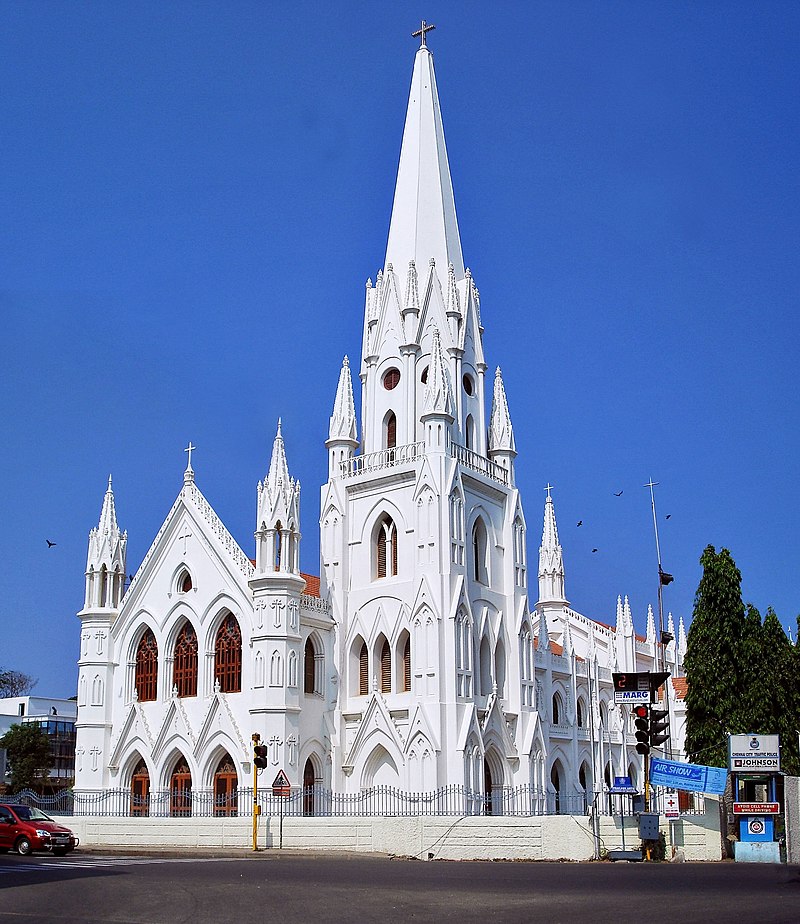
Monday, July 3: Feast of St. Thomas – Apostle (? – AD 72): While often given the moniker “Doubting Thomas” from the recounting in the Gospel of John concerning his initial unbelief in the resurrected Christ, Thomas would go on to likely be the apostle who traveled the furthest from Judea. Best estimates from researchers suggest he followed a typical trade route at that time to India (and possibly even part of China), which entailed traveling to Alexandria, Egypt, taking the Nile south, then boarding a ship at a port city on the Red Sea which separates Africa from the Arabian Peninsula, and finally sailing across the Arabian Sea in the N. Indian Ocean. It is postulated that he arrived in N.India by the late AD 40s. The 3rd century Acts of Thomas chronicles some of Thomas’ journeys including the conversion of a king, whose existence has been historically proven with the discovery in the 19th century of coins in the region with his name. Traditions hold that Thomas returned to Judea to attend the funeral of the Blessed Virgin Mary and the Council of Jerusalem around AD 50. A second trip to India, this time to the southern part, is believed to have happened with archeological evidence including a venerated tomb of St. Thomas (only one known). The remnants of this tomb were found by the Portuguese traders of the 16th century who subsequently built a church upon its foundations (see picture of the current basilica). The writings of St. Ephrem during the 4th century mentioned Thomas worked, died, and was buried in India before his relics were brought to Edessa near the border between modern day Turkey and Syria. Several Christian communities located on strategic waterways in S. India have traditions whereby their ancestors were instructed in the faith by Thomas. While the absolute proof required by some may never be achieved, the increasing evidence as analyzed by scholars in recent centuries give increasing weight to the traditions held since the early Church that Thomas was the first to bring the Christian faith to India. Thomas’ remains eventually moved to Ortona, Italy in the 1200s and remain there to this day.
Wednesday, July 5: Memorial of St. Elizabeth of Portugal (1271 – July 4, 1336): Born into the royal Spanish house of Aragon, Elizabeth was arranged to marry King Denis of Portugal at the age of 10. Known for living a prayerful life with attention to the poor and sick, she would have two children. On more than one occasion she served an important political mediator role, including one situation where she basically prevented the king from killing his own son on the battlefield, thus earning herself the title of Peacemaker. After her husband’s death in 1325, she retired to a monastery living as a Third Order Franciscan while continuing to care for the poor and sick. She is typically displayed in artwork with a royal garb and either a dove or an olive branch. She was canonized by Pope Urban VIII in 1626.
Upcoming Week in Church History: June 25-July 1
“And I tell you that you are Cephas (Peter), and on this rock I will build my church, and the gates of Hades will not overcome it.” (Matthew 16:18) This upcoming week we reflect on the lives of three great leaders of the early Church. the Apostles Peter and Paul and St. Irenaeus, while also remembering the missionary efforts of a Franciscan in California.
Wednesday, June 28: Memorial of St. Irenaeus (130-202): Known as the “Father of Theology”, Irenaus grew up in Smyrna (modern day Izmir, Turkey) under the tutelage of St. Polycarp who was a disciple of the Apostle John. Not long after being ordained, he served in the area of Lyon, France and eventually became bishop after his predecessor was martyred. Most of his pastoral work centered around combating Gnosticism, a heresy that came in various forms but focused primarily on the belief of some “secret” knowledge required for salvation that was only accessible to its members as part of a dualistic belief system that anything material was evil and anything spiritual was good. Irenaeus’ most famous extant work was aptly called Against Heresies. The circumstances of his death are unknown but he is listed as a martyr by the Church. In 2022 Pope Francis named Irenaeus a Doctor of the Church.
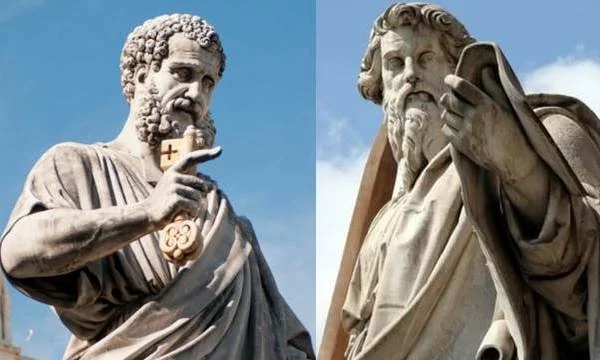
Thursday, June 29: Solemnity of Apostles Peter and Paul (died 64?): As all good Catholics know, Peter was known as Simon before he was chosen by Christ to be the leader of his disciples and in the process was given a new name to mean ‘rock’. Peter would eventually become the first pope as Bishop of Rome. On the other hand, Paul was perhaps the ultimate opponent to the early Church of the 1st century until a miraculous revelation on the road to Damascus changed everything leading to a life of missionary work and profound writing (14 of the 27 books of the New Testament are attributed to him). While some traditions account his conversion as leading to a name change too (Saul to Paul), some historical scholarship believes that Paul was his Latin name while Saul was his Greek name. Having 2 names was not necessarily a unique thing at that time. It is believed that both apostles died in Rome, Peter by crucifixion and Paul by beheading, under the persecutions of Emperor Nero around AD 64 when the emperor blamed the Christians for a fire that destroyed a large part of Rome. St Irenaeus’ writings give credence to Peter and Paul founding the Church in Rome as well.
Saturday, July 1: Memorial of St. Junipero Serra (Nov 24, 1713-Aug 28, 1784): Born in Mallorca, Spain (for you tennis fans – yes, same island as Rafael Nadal), Miquel Josep Serra had an affinity to the local Franciscan friary from a young age and entered it at the age of 16 receiving the name Junipero. He had a bright mind and served as a teacher until his desires shifted to missionary work in the New World landing in Mexico in 1749. It was not long after arrival that Junipero suffered some sort of insect bite on his leg which hampered his walking for the rest of his life. After several years in Mexico, word arrived that the Jesuit missionaries were being expelled by Spanish King Charles (see Weekly Church History of April 2-9 for more) whereby the Franciscan missionaries had an opportunity now to fill the void created. Junipero would travel to California and establish several missions including San Gabriel, San Luis Obispo, San Francisco and Santa Clara along with a vineyard which ultimately began the California wine industry! Controversy surfaced when Junipero was canonized in 2015 as some questions surfaced concerning the methods employed in keeping newly Christianized indigenous people at the missions, which was done in an effort to avoid a relapse from the faith. Junipero fought for the rights of the indigenous people who were subjected to a harsh Spanish military governor whose soldiers maltreated the indigenous people.
Upcoming Week in Church History: June 18-24
“We believe in one God, the Father almighty, maker of all things visible and invisible…” and thus begins the Nicene Creed, which was formally ratified this upcoming week at the First Council of Nicaea. Learn more about this event along with a few other important Catholic figures including the priest who developed the “Big Bang” theory on the origin of the universe, a pious young Jesuit, and two martyrs who stood up to the whims of royalty.
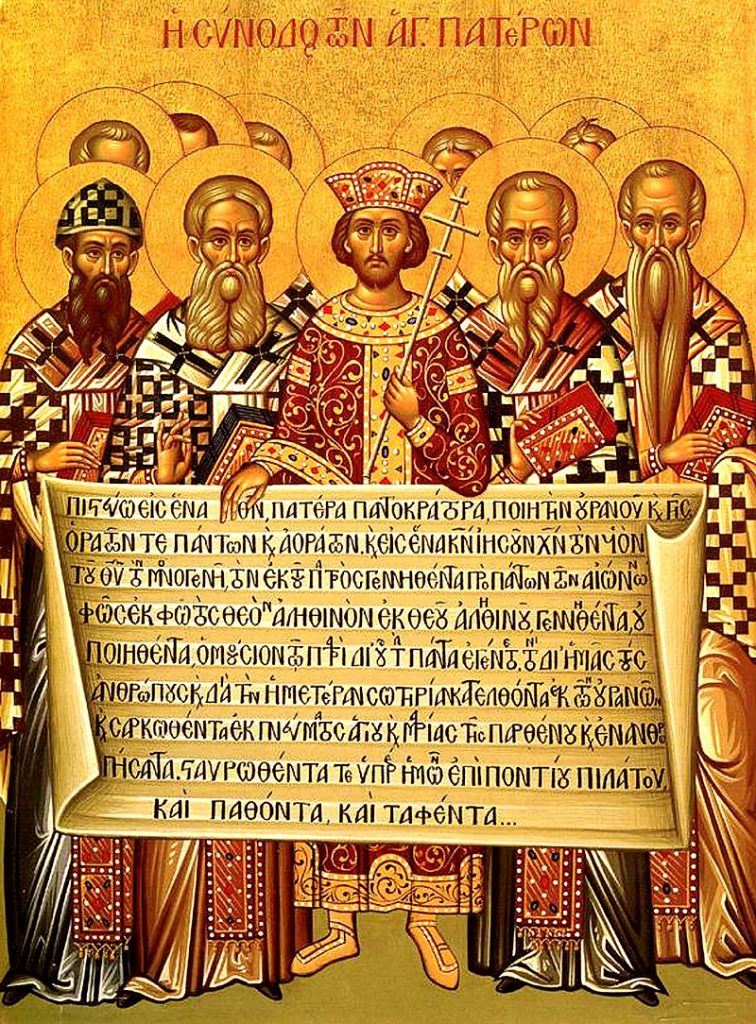
Monday, June 19: Original Nicene Creed Adopted (June 19, 325): As part of the first ecumenical council that convened under Emperor Constantine the Great during May-August 325 in Nicaea (modern day Iznik in northwestern Turkey), a summary of the Christian faith was ratified towards creating a unified and universal creed. The Creed also addressed the concerns brought up by the Arian heresy of the age which attempted to de-emphasize the unity of the Father and the Son. The Creed would subsequently get modified at the second ecumenical council held in Constantinople in 381 whereby the parts concerning the Holy Spirit and after in the Creed, which we say to this day, would get added.
Tuesday, June 20: Priest and Mathematician Georges Lemaitre dies (July 17,1894 – June 20,1966): As proof against some of the claims made in the modern age about faith and science being incompatible, Catholic priests have often times been at the leading edge of scientific discovery. Gregor Mendel (“father of genetics”), Giuseppe Mercalli (volcanologist who developed two earthquake intensity scales), and Georges Lemaitre (“father of the Big Bang theory”) are some noteworthy examples. Lemaitre proved mathematically (and later empirical evidence validated) that the universe was expanding and thus started from some initial point, which later became known as the Big Bang theory.
Wednesday, June 21: Memorial of St. Aloysius Gonzaga (March 9, 1568 – June 21, 1591): Born the eldest of 8 children into a northern Italian aristocratic family, Luigi (Italian version of his name; Aloysius is the Latin version) was exposed from an early age to the art of warfare with the expectation he would be a soldier like his father. However, he grew to shun the violent life surrounding him during the Renaissance age (he witnessed the murder of two of his brothers), renounced his inheritance, and joined the Jesuits at the age of 17. In 1591 plague hit Rome and Aloysius along with other Jesuits worked at a hospital. Eventually Aloysius would contract the illness. He knew from an angelic vision the day he would die (on the octave of the feast of Corpus Christi) which turned out to be true at only 23. He was known for his piety and ascetic lifestyle, canonized a saint by Pope Benedict XIII in 1726 and is the patron saint of Christian youth. Several educational institutions are named after him, including the Jesuit-founded Gonzaga University in Spokane, Washington.
Thursday, June 22: Memorials of Sts. Thomas More and John Fisher: Contemporaries in 16th century England, More, the royal chancellor under King Henry VIII, and Bishop Fisher were two individuals who did not bow down to King Henry VIII’s request to have his marriage to Catherine of Aragon annulled so he could marry his latest romantic interest, Anne Boleyn. The king’s escapades eventually led to the separation of the Church of England from Rome with Henry named head of the church. More and Fisher would both be charged with treason and executed – Fisher on June 22, 1535 and More shortly after on July 6, 1535.
Upcoming Week in Church History: June 11-17
“The soul is the life of the body, God is the life of the soul.” Learn more about one of the great preachers in Church history who is often more remembered for being the saint to pray to when trying to find lost items. We also celebrate a Eucharistic feast day and two feast days centered on Love – divine and human.
Sunday, June 11: Corpus Chrisi – The Most Holy Body and Blood of Christ: Thanks to the proposal of St. Thomas Aquinas to Pope Urban IV back in the 13th century, today we have this feast day that specifically celebrates the Real Presence of Jesus (Body, Blood, Soul, and Divinity) in the Eucharist. Unfortunately, this belief had been increasingly questioned, doubted, and even ridiculed by many through the centuries, but it was unanimously supported by the early Church Fathers. Even Martin Luther with all his issues with the Church that instigated the beginnings of the Protestant Reformation in the 16th century still held to the Real Presence.

Tuesday, June 13: Memorial of St Anthony of Padua(August 15, 1195 – June 13, 1231): Joining the Augustinians in Lisbon, Fernando gave up a future of material wealth and power. He would later join the Franciscan Order, taking the name of Anthony after the desert father Anthony the Great, with the goal of preaching to the Moors (Muslims of Arab or Berber/N. African descent), but illness prevented him from following that path. He went to Italy and became a leader among friars in N. Italy around Padua. He was known for being a powerful preacher with expert knowledge of the Scriptures. One miracle event associated with Anthony as he tried to make the point that heretics refused to listen to his message was he preached near a shoreline resulting in a huge swarm of fish to gather near him to listen more intently than the heretics! (see picture) He died on June 13, 1231 at just 35 due to the effects of some food poisoning, canonized a saint within a year (one of the quickest) and later was designated a Doctor of the Church by Pope Pius XII in 1946 for his collection of Sermons for Sundays and Feast Days. He is the patron saint of lost items, the poor and travelers. A fairly well-known story related to Anthony, this time concerning lost items, happened when a novice decided to leave the religious order, taking an important book of Anthony’s with him. When realizing the book was missing, Anthony prayed. Shortly after, the novice returned the book and re-joined the order!
Friday, June 16: The Most Sacred Heart of Jesus: The Third Friday after Pentecost is designated as the Solemnity of the Most Sacred Heart of Jesus. The Sacred Heart in Christian art is depicted as a flaming heart to represent God’s boundless love for mankind. A devotion to the Sacred Heart in modern times is primarily the result of a series of apparitions experienced by French Sister St . Margaret Mary Alacoque around 1673-75 where Jesus instructed her on the devotion.
Saturday, June 17: Immaculate Heart of the Blessed Virgin Mary: Following immediately after the Most Sacred Heart of Jesus is a feast day venerating the heart of Mary for her example of the human response to Divine Love. Mary’s heart is commonly depicted in art as a heart pierced with seven swords.
Upcoming Week in Church History: June 4-10
“This little tree, a young child of the forest, shall be your holy tree tonight. Let this be called the tree of the Christ-child: gather about it, not in the wild wood, but in your homes; there it will shelter no deeds of blood, but loving gifts and rites of kindness.” Learn more about the Catholic saint who was at the center of starting the tradition of the Christmas tree.
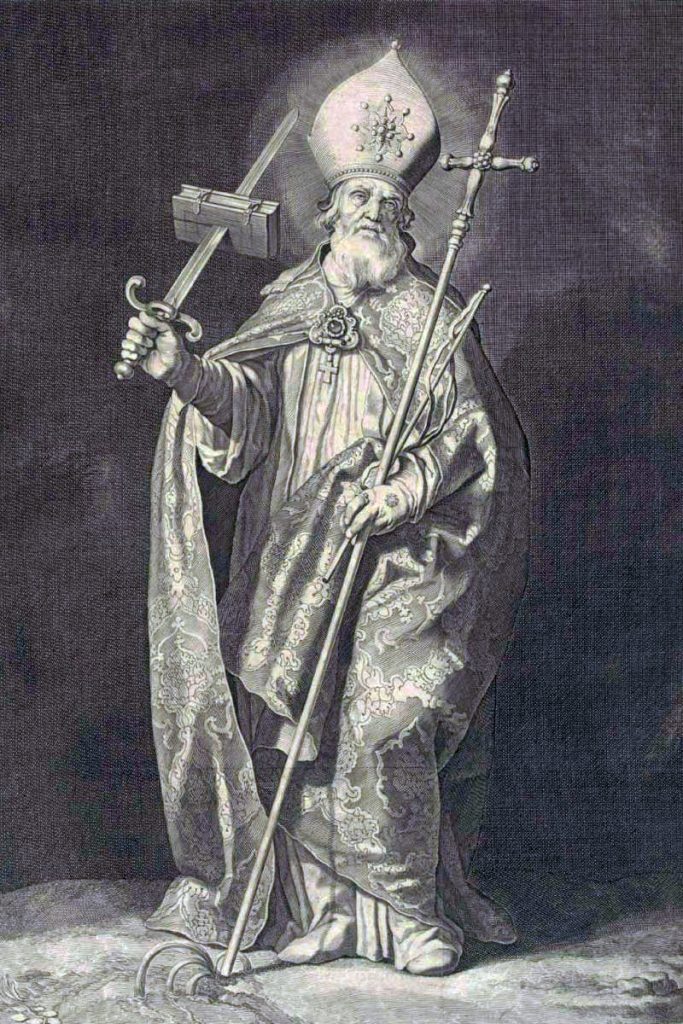
Monday, June 5: Memorial of St Boniface (675 – June 5, 754): Born Winfrid in 7th century England, this saint of the Church became a Benedictine monk yearning to do missionary work. He traveled to Rome and was commissioned under Pope Gregory II, who changed his name to Boniface, to preach the Gospel among the Germanic peoples in northern Europe in an area that had no formal Church organization yet. His extensive travels and efforts would eventually garner him the name “Apostle to the Germans”. One famous story in particular associated with Boniface centers over his chopping down on Christmas eve a huge old oak tree known by local pagans as the “Thunder Oak” which was dedicated to the god Thor. Afterwards, Boniface then evangelized to the pagans by using a small fir tree located near the chopped down oak tree stating the words quoted in the summary above. The tradition of the Christmas tree was started! Boniface’s ongoing efforts to convert pagans against stern opposition by some ultimately led to his martyrdom on June 5, 754.
Tuesday, June 6: Memorial of St Norbert (1080 – June 6, 1134): Living in 12th century France, St. Norbert founded a religious Order in 1120 known as the Praemonstratensians (extra credit if you can pronounce that!), better known as the Norbertines. The Order focused on combating heresies of the age, in particular those that did not fully regard the Blessed Sacrament as being the true body, blood, soul and divinity of Christ. In his later years he was assigned a bishop to the German province of Magdeburg where he died on June 6, 1134. He was canonized a saint by Pope Gregory XIII in 1582.
Saturday, June 9: Memorial of St Ephrem(306 – June 9, 373): Living in 4th century Syria (modern day southern Turkey), St. Ephrem was described by Pope Benedict XVI as the “Harp of the Holy Spirit” in recognition for his prolific hymns and poetic writings, many of which still exist, that conveyed orthodox doctrine of the faith in combating the songs of heretical groups of his time. St. Ephrem is the only Syriac Christian recognized as a doctor of the Church. It is believed he died of the plague while ministering to other victims of the same disease around June 9, 373.
Upcoming Week in Church History: May 28-June 3
An important title and event concerning the Blessed Virgin Mary plus the memorials of a French heroine and a couple early martyrs of the Church highlight the upcoming week.
Monday, May 29: Memorial of the Blessed Virgin Mary, Mother of the Church (2018) and the End of the Byzantine Empire (1453): Added to the liturgical calendar in 2018 on the first Monday after Pentecost, this memorial recognizes Mary who gave birth to Christ, the Head of his Mystical Body (the Church), as the Mother of the Church too. Pope St Paul VI solemnly declared this title for Mary as part of an address at the conclusion of the third session of the Second Vatican Council in 1964. This day in 1453 also marked the end of the Byzantine Empire (aka the Eastern Roman Empire) when Constantinople (modern day Istanbul, Turkey) fell to the Muslim Ottoman Turks and thus ending Christian rule in the area.
Tuesday, May 30: Memorial of St Joan of Arc (Jan 6, 1412 – May 30, 1431): Born into a peasant family southeast of Paris during the time of the Hundred Years’ War between France and England, Joan would begin to receive visions from St. Michael the Archangel around the age of 13. Within this area of France, which had suffered greatly from English raids, a prophecy circulated claiming that an armed virgin would rise and save France. Joan implied she was this promised maidan as she worked toward seeing that the heir to the throne, Charles VII, would become king and ultimately lead France to victory. Joan led an army that brought an end to the siege of Orleans with the crowning of King Charles occurring shortly after. However, in subsequent battles Joan would be wounded and then later captured and sold to the English, who with the aid of a French Bishop working with the English, put her on trial claiming she was abiding to demonic visions, defying Church authority, and even wearing men’s clothes! Joan would be burned at the stake on May 30, 1431 at the age of 19. After the war ended, King Charles with help from Pope Callixtus III found the original trial of Joan to be unjust and consequently nullified the charges made against her. She would later be canonized in 1920.
Wednesday, May 31: Feast – The Visitation of the Blessed Virgin Mary Situated between the Annunciation of the Lord on March 25 and the Nativity of St John the Baptist on June 24, comes this feast day commemorating the time that Mary visited her cousin Elizabeth, which is mentioned in the Gospel of Luke as being a period of about 3 months.
Thursday, June 1: Memorial of St Justin Martyr (100 – 165): As the Patron Saint of Philosophers, Justin lived in Syria during the 2nd century and spent much of his adult life on a quest for religious truth by studying various philosophies until learning about the Christian faith. He wrote repeatedly in defense of the faith including The First Apology, which are among some of the earliest extant writings from the early Church we have after the New Testament writings themselves. He followed the faith to the point of martyrdom in Rome in 165.
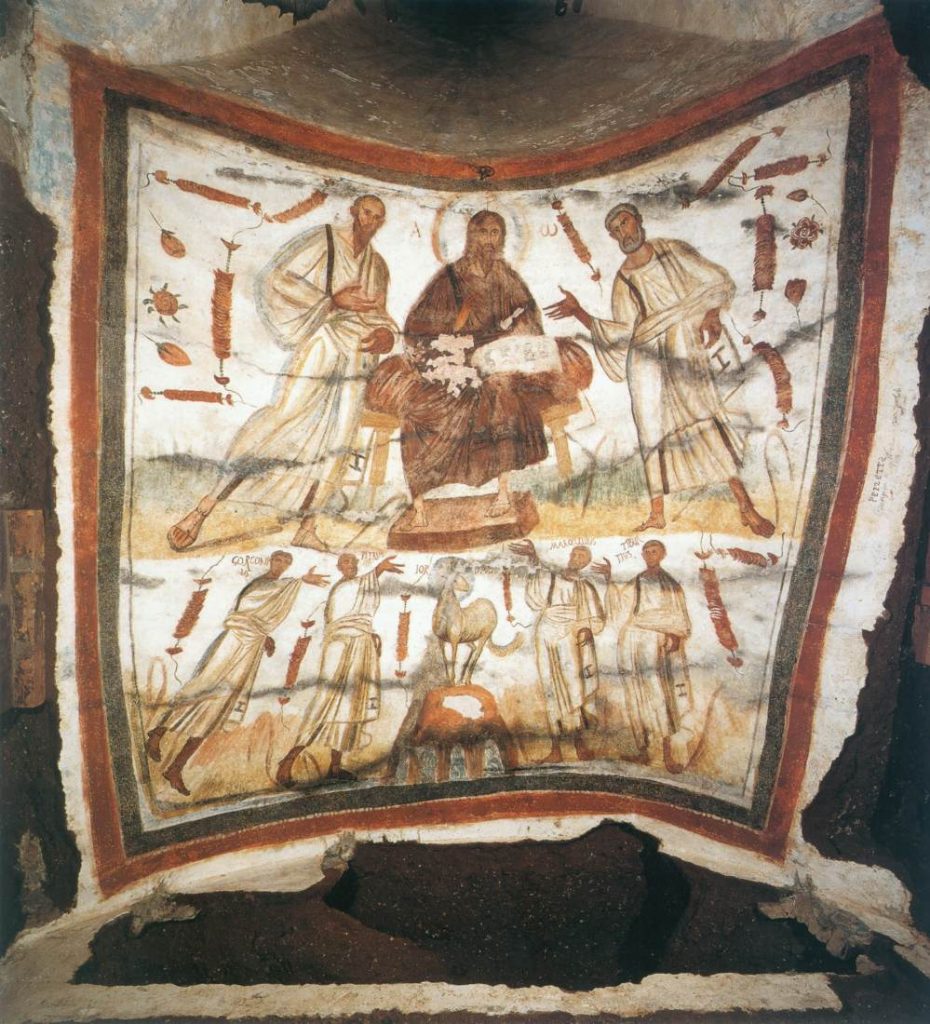
Friday, June 2: Memorial of Sts. Marcellinus and Peter (died 304): While little is known of the lives of these two early martyrs who died in the 4th century near Rome, tradition holds that Marcellinus was a priest and Peter an exorcist. The location of their bodies were divinely revealed to two women who then buried the bodies in what is today known as the Catacombs of Marcellinus and Peter. 21st century excavations suggested the catacombs contained at least 20,000 skeletons along with several examples of early Christian artwork. See associated picture for one example.
Upcoming Week in Church History: May 21-27
Several memorials of saints with widely varying personalities and known for a combination of scholarly, missionary, and reform-minded work highlight the week. As one saint cheerfully put it: “A joyful heart is more easily made perfect than a downcast one!”
Thursday, May 25: Memorial of St Bede(673-May 26, 735): Born in England, entering a monastery at an early age, and becoming a deacon by 19 (6 years before the canonical rule’s age) and a priest by 30, St Bede is known today for being one of the most famous scholars of his time, serving both as a writer and a teacher. In 731 he completed his most famous work, the Ecclesiastical History of the English People . Bede died late in the evening of May 25, 735 or in the early morning hours of May 26, 735 while citing his favorite prayer: “Glory be to the Father, and to the Son, and to the Holy Spirit. As in the beginning, so now, and forever.” In 1899, Pope Leo XIII declared him a Doctor of the Church, the only native from Great Britain to receive that honor.
Thursday, May 25: Memorial Pope St. Gregory VII (1025- May 25, 1085): Known as Hildebrand from the region of modern day Tuscany, Italy, Gregory VII studied in a monastery in Rome. He later served as a counselor and legate for multiple popes before being elected pope by public acclamation (one of the few popes to have been elected in this manner) in 1073. During his papacy, he was known for reform measures including strict adherence to clerical celibacy and more independence of the Church from secular meddling. He affirmed the pope’s role as the universal shepherd of the Church and moral judge of all people, including royalty, as part of his famous decree Dictatus Papae. The crisis of lay investiture, where royalty would aim to control the appointment of Church officials, led to a lengthy feud between Gregory and Holy Roman Emperor Henry IV, ultimately leading to Gregory being exiled for the final years of his life as Henry forcibly took control of Rome and installed an anti-pope.
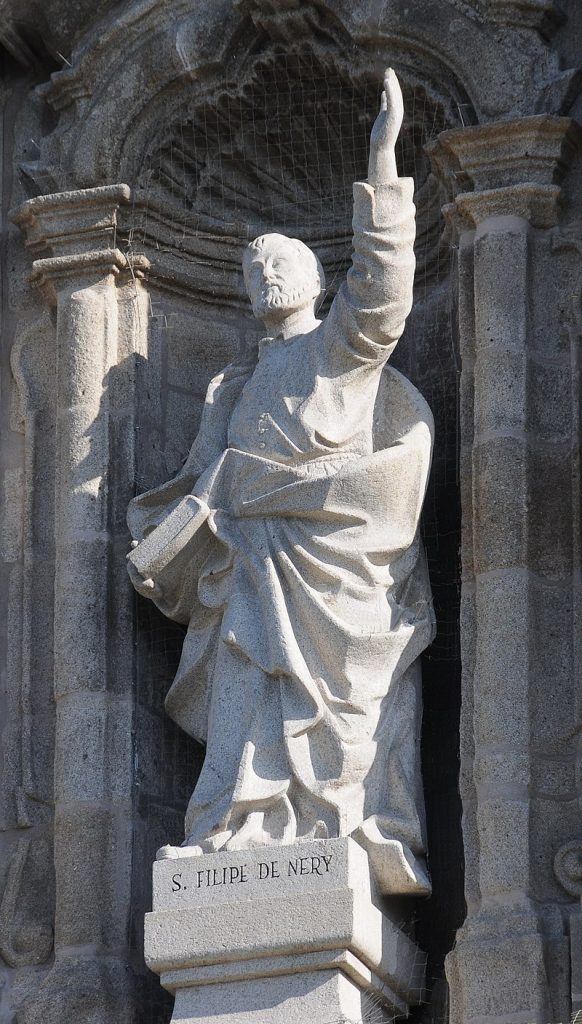
Friday, May 26: Memorial of St Philip Neri (July 22, 1515 – May 26, 1595): Known as the “Apostle to Rome”, Philip from Florence, Italy lived as a missionary layman in Rome for 17 years. He traveled amongst the people in the city preaching and exhorting them to love and serve God. Eventually becoming a priest Philip would go on to form the Confraternity of the Oratorory focused on a communal living environment for diocesan priests. He gained popularity living a pious life with a most cheerful and jocular temper as demonstrated with the first quote at the top of this week’s review. He often prayed “Let me get through today, and I shall not fear tomorrow.” Philip was part of a group of saints in the late 16th century into early 17th century that served a major part in the Counter-Reformation movement against the Protestant Reformation (Revolution). See photo of his statue in Braga, Portugal.
Upcoming Week in Church History: May 14-20
The feast day for the patron saint of farmers, the promulgation of a famous papal encyclical on capitalism and labor, and the deaths of a pope (unexpectedly) and a famous explorer who is less commonly known for his missionary desires highlight some of the events this upcoming week in Church history.
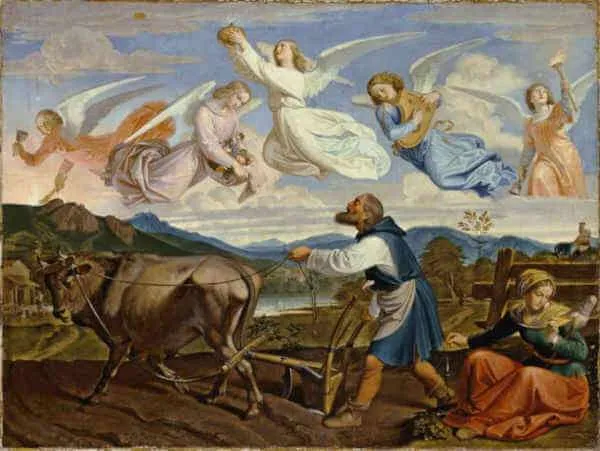
Monday, May 15: Feast Day of St Isidore the Farmer (1070 – 1130): Born to a poor, devout Catholic family near Madrid, Spain, Isidore was named after St. Isidore of Seville who was recently highlighted a few weeks back for his scholarly efforts in the 6th/7th centuries. Isidore the Farmer worked for a wealthy landowner. Over 400 miracles are associated with his life including one that involved the saving of his son who had fallen into a deep well. After praying, the water of the well was said to have risen to the level of the ground! Isidore was known for his piety too. Because of his daily Mass attendance and praying habits, fellow laborers would complain about him being late often, but miraculous accounts were documented where angels either took his place or assisted him as he did his work in the fields. He often shared his meals with the poor leading to accounts of food miraculously appearing to help feed all present. Dying on May 15, 1130, Isidore is also among those saints known to have exhibited an incorruptible body many years after death. He was canonized by Pope Gregory XV in 1622. Isidore is the patron saint of farmers and rural laborers.
Monday, May 15: Pope Leo XIII encyclical Rerum novarum (1891): In response to capitalism and industrialization, Pope Leo XIII (r 1878-1903) promulgated one of the more famous modern encyclicals in 1891 where he emphasized the duty of the state to promote justice through the protection of rights (including the right of private property which was in contrast to the growing socialist ideology of the time). While free market forces are permissible, moral considerations must be made including fair and reasonable wages to workers. Ultimately the relationship between capital and labor must keep in mind the dignity of the person, the common good, and a preference to subsidiarity where government does not replace the family unit but local authorities step in when needed instead of a dominant central authority controlling everything.
Saturday, May 20: Deaths of Pope John XXI (1277) and Christopher Columbus (1506). Pope John XXI reigned for about 8 months only. During that time he did aim to launch a Crusade to the Holy Land and attempted a reunion of East and West within the Church. He also requested a study be built for him as an extension to his residence so he could go somewhere quiet to work undisturbed. However, on May 14, 1277 the ceiling collapsed on him! He was not instantly killed but a few days later on May 20 he died from the injuries sustained. On this same day in 1506, the famous explorer Christopher Columbus died. While some modern interpretations of his life have leaned towards a more negative perspective on the man, most historically sound sources document Columbus as a devout Catholic with a strong desire to use his abilities as a means to spread the faith to new parts of the world despite some of his shortcomings.
Upcoming Week in Church History: May 7-13
A woman “brighter than the sun, shedding rays of light clearer and stronger than a crystal goblet filled with the most sparkling water and pierced by the burning rays of the sun” described the first appearance of the Blessed Virgin Mary to three children in Portugal this week in May 1917. We also recognize a priest known for his heroic ministry at a leper colony in Hawaii.
Wednesday, May 10: Feast Day of St Damien of Molokai (arrives at leper colony in 1873): Belgium priest and member of the Congregation of the Sacred Hearts of Jesus and Mary, Damien became known as the Apostle of the Lepers through his volunteering to minister to an isolated leper colony in Hawaii from 1873 to his death. At the time, leprosy was not treatable and working closely with those infected was viewed as a sure death sentence. Upon arrival Damien was quoted as saying his desire to come was as “one who will be a father to you, and who loves you so much that he does not hesitate to become one of you, to live and die with you.” Damien would contract the disease by 1884 and ultimately die from the disease on April 15, 1889. He was canonized by Pope Benedict XVI in 2009.
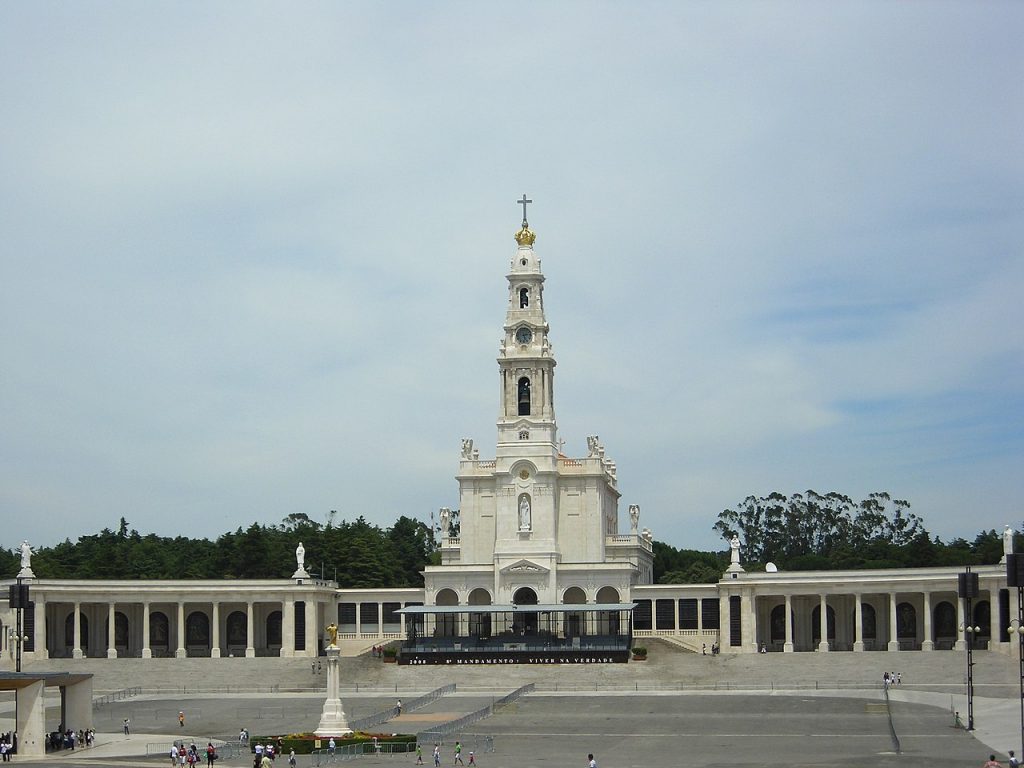
Saturday, May 13: Our Lady of Fatima (1917): This date would mark the first of six monthly apparitions by the Blessed Virgin Mary to Francisco (age 9) and Jacinta Marto (age 7) and their cousin Lucia (age 10) in 1917 near Fatima, Portugal. The children had been prepared for Mary’s coming in the previous year with the appearance of an angel to them. At Mary’s first appearance the children were instructed to say the Rosary daily in an effort to bring peace to the world with World War I currently underway. While the children desired to keep things a secret, news of the apparition quickly spread once Lucia told her mom some of what happened. In subsequent apparitions, Mary would share that the two younger children would die soon (ultimately they died as part of the influenza pandemic), the need for Russia to be converted through a consecration to the Immaculate Heart of Mary for peace, and 2 visions: one of hell and one of the pope suffering and being martyred, which many believe came to fruition with the assassination attempt of Pope John Paul II on May 13, 1981. The final apparition was highlighted by what is known as the “Miracle of the Sun” seen by thousands where it appeared that the sun danced in the sky and all wetness from previous rains instantly dried. Lucia would go on to become a religious sister and died in 2005 at the age of 97. All 3 children were canonized by Pope Francis on May 13, 2017.
Upcoming Week in Church History: April 30-May 6
This week we have the opportunity to explore the extraordinary life of St. Athanasius, the chief defender of the Trinity against Arianism in the 4th century, along with the lives of Apostles Philip and James.
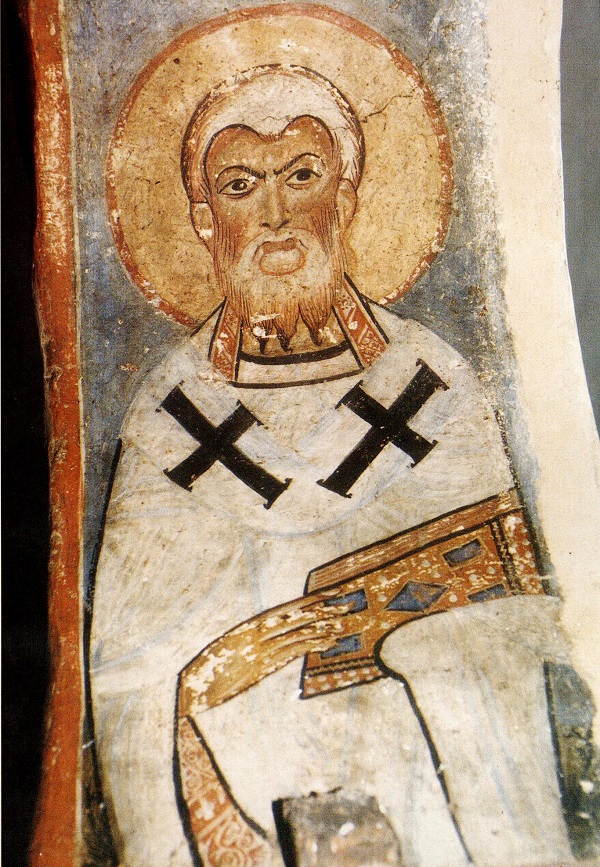
Tuesday, May 2: Memorial of St. Athanasius (died May 2, 373): Born in the last decade of the 3rd century in Alexandria, Egypt, Athanasius had an affinity to serving in the Church even at a young age when a story was recorded about Bishop Alexander in Alexandria seeing Athanasius playing the role of baptizer with some other kids on the seashore using the correct words and administration of water. Athanasius would shortly thereafter come under the tutelage of Bishop Alexander eventually serving as his secretary and then successor. Much of his clerical life was highlighted by opposition to Arianism, a heretical teaching proposed by Arius. As mentioned in earlier articles, Arianism claimed that God the Son was not coeternal with God the Father but essentially the first among creatures (ie: made but not begotten). Bishop Alexander would excommunicate Arius but the heresy would become a huge issue with its formal condemnation at the First Council of Nicaea in 325, which Athanasius attended as secretary. In 328 while on his deathbed Alexander appointed Athanasius his successor. Athanasius’ episcopate was marked by one controversy after another in dealing with Arianism. Through the combination of trumped up charges of mistreating heretics, to a false charge of murder of a missing bishop who was later found, to the back and forth favoritism Arianism enjoyed through a series of emperors, Athanasius was forced into 5 separate periods of exile lasting a total of 17 years. He was able to spend a few final years back as Bishop of Alexander trying to repair the damage and dissent from previous decades. Through it all Athanasius was known as a strong, shrewd and tough leader and wrote several extant works including On the Incarnation of the Word and the Life of Anthony.
Wednesday, May 3: Feast of Apostles Philip and James (??): Little is historically known about Philip and James (son of Alphaeus and sometimes called James the Lesser) beyond what is mentioned in Scriptures about them. John’s Gospel mentions Philip being from Bethsaida (along with Peter and Andrew) and mentions his presence at events such as the feeding of five thousand and the Last Supper. It is believed he did much of his missionary work in parts of modern day Turkey, eventually martyred in Hierapolis with a possible tomb location found relatively recently in 2011. James may have been a cousin of Jesus and tradition holds he was the first bishop of Jerusalem at the time a council was called around AD 50. He died around AD 62 during the persecution of the Church ordered by King Herod Agrippa. Relics of both apostles were sent together to Rome and this is why they share the same feast day.
Upcoming Week in Church History: April 23-29
We will be celebrating the feast day of Saint Mark, author of one of the Gospels. What do we know about his life? We also recognize Catherine of Siena, one of only four female Doctors of the Church.
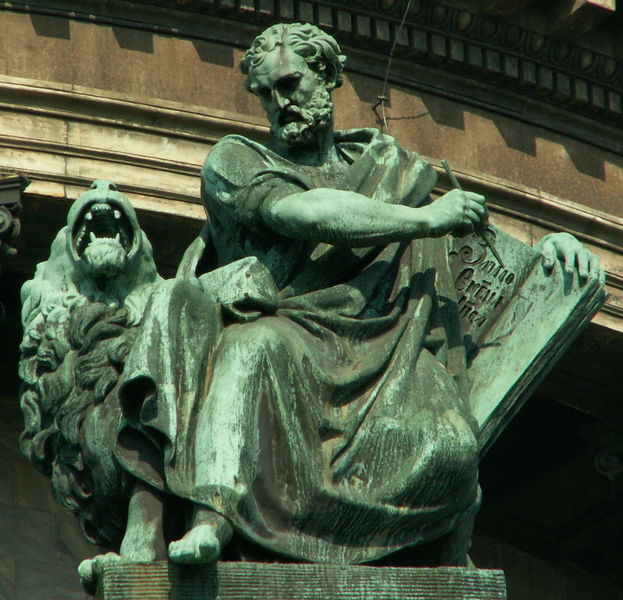
Tuesday, April 25: Feast Day of Saint Mark: Historical sources from African traditions mention John Mark (John – a Hebrew name and Mark – a Latin name) being born to a Jewish family of the tribe of Levi in Cyrene, located in modern day Libya, sometime around AD 5-15. A few years later, civil unrest in the area prompted the family to relocate to the area of Jerusalem where it is believed the family became part of the early close-nit and in some cases familially-related group of Jewish followers of Jesus. The disciple Barnabas, who traveled with St Paul along with Mark on some of Paul’s missionary trips, may have been the brother of Mark’s mother, Mary. Additionally, Mark’s father may have been related to the wife of the Apostle Peter. Evidence seems to point to Mark’s family being the owners of the home (one could call it the first Christian church) where the Last Supper was held. While today sits St. Mark’s Monastery, the location of this house has been a pilgrimage site since the days of the early Church.
One interesting story concerning Mark involved him walking with his father along the Jordan River when they came across two lions (yes, lions used to live in the area until the 19th century). Mark’s prayers at the time resulted in the lions being completely docile and the episode led to the symbol of the lion being associated with him.
In the AD 40s and 50s, Mark was involved in many missionary trips with Peter and Paul. African tradition holds that Peter may have traveled to Egypt with Mark to stay for a short time after his miraculous escape from prison with help from an angel as mentioned in Acts 12. At this time it is believed that the Church of Alexandria began with Mark being named the first bishop at some point afterwards. Mark would join Peter and Paul in Rome for a period of time, probably completing most or all of his Gospel there before returning to Africa after Peter and Paul’s martyrdoms. Mark was soon to face his own martyrdom on April 25, 68 as a mob beat and dragged him through the streets in response to his decries against the idolatry practices of the area. St. Mark is held in very high regard within the African Church especially given his African roots and missionary role to the area.
Saturday, April 29: Catherine of Siena (March 25, 1347 – April 29, 1380): Born to a large family with 24 siblings (many dying young though), Catherine would experience her first mystical vision involving Jesus, Peter and Paul at age six while on the way to visit her sister. She knew from a very young age she desired only to be the bride of Christ spending almost all her time in prayer or service of others. She lived one of the most remarkably ascetic lives, subsisting eventually only on the reception of the Eucharist and 30 minutes of sleep each day! While only becoming visible after her death, Catherine also received the stigmata of Christ’s crucifixion. In her last 3 years of life she was given the miraculous ability to write and quickly became a major proponent of returning the papacy back from Avignon, France to Rome. In one instance she reminded Pope Gregory XI of his secret vow which know one else would have known about it to return back to Rome. Catherine died at 33, the same age of her bridegroom, Jesus Christ.
Special Bonus – Two Weeks in Church History: April 9-22
From the rise of an early Church bishop who would have his name later associated with a heresy to the infamous siege of Constantinople by Crusaders to the birth and election of a recent pope, this past week and the upcoming week experienced several noteworthy events in Church history.
Note: With no Friday newsletter not sent out last week (Good Friday), two weeks are highlighted in this edition.
Nestorius becomes Patriarch of Costantinople (April 10, 428): The first few centuries of the Church saw extensive debate aimed towards a better understanding of the two natures of Jesus as God and man. Within this discussion Nestorius would prove to be a major participant. While agreeing that Jesus was both fully God and fully man, he did not agree to calling Mary the Theotokos (“Mother of God”). Nestorius preferred calling Mary the Chrystotokos (“Mother of Christ”). This coincided with his disagreement of the concept of a hypostatic union of two complete and distinct natures in one person in Jesus as he thought that inevitably mixed the natures versus keeping them more loosely separated. This led to an understanding (perhaps misunderstanding) that Nestorius heretically proclaimed Jesus as being two persons instead of one divine person who became man. Nestorius was condemned at the Council of Ephesus (431). According to some scholars, much of this debate may have been exacerbated by confusion over the semantics of some words which were still developing their full and proper meaning at that time, Nestorius lived the remainder of his life secluded in a monastery until his death around 451.
First Catholic Bishop of Carolinas dies (April 11, 1842): John England of Cork, Ireland served from 1820 until his death in 1842 as the first bishop of the newly formed Diocese of Charleston that covered the states of North Carolina, South Carolina and Georgia. England estimated at the start of his tenure that there were only 500 Catholics in North Carolina!
Sack of Constantinople (April 12-15, 1204): Often cited by our Orthodox Church brethren as the final blow in justifying the Great East-West schism of the Church, which is often associated as happening in 1054 (note: it is a bit more complicated), an unfortunate series of circumstances at the start of the 4th Crusade led to this event. Alexios IV Angelos, the son of a deposed Byzantine Emperor, arranged a deal with the Crusaders who were in need of money to go on crusade against the Muslims controlling much of the Middle East around Jerusalem. He assured them that if they helped him assume the throne in Constantinople then he would have the money to fund their crusade while also promising a reunion with the Catholic Church. However, the reality of the situation was that Constantinople was in the midst of a power struggle for the throne. While Angelos did assume control initially with the help of the Crusaders, it lasted only six months with another coup leading to his execution. The Crusaders had not been fully paid yet which added to the unstable situation. Ultimately a sacking of the city followed, seizing or destroying anything of value. It should be noted that the pope warned against the deal proposed by Angelos but crusader military leadership went along with it anyway.
Pope Benedict XVI (born April 16, 1927 and elected pope April 19, 2005): Two important days mark the month of April for Joseph Ratzinger, his birth in Bavaria, Germany in 1927 and his election as Pope Benedict XVI in 2005.
Pope Leo IX (dies April 19, 1054): Leo IX served as pope in the period leading up to the infamous excommunication decrees made between his legates and the Patriarch of Constantinople in July 1054 which had arisen from a long history of a variety of theological and political differences. The legates who had traveled to the city earlier in the year technically made their excommunication decree with no authority since the pope was dead and a new pope had not been elected. Furthermore, at the time it was not viewed as too significant given that the excommunications were centered on specific individuals primarily. However, over time the events of the summer of 1054 would become cited as the official schismatic event that split the Catholic and Orthodox Churches. Leo IX would be remembered as an important reform minded pope opposing the selling of church offices (simony) and clerical marriage abuses.
The Upcoming Week in Church History: April 2-9
We draw attention to two saints: one who served as a major influencer in the life of St. Augustine; the other a 6th century bishop who is today known as the patron saint of the Internet. Additionally, we take a quick look at a secret plan against the Jesuits conceived by Spanish royalty in the mid-18th century.
Sunday: Jesuits expelled from Spanish territories (April 2, 1767) At sunrise, a secret plan by King Charles III of Spain and his advisors was publicly announced across the realm. All Jesuits were to be expelled from Spanish territories and their property confiscated, or face execution! How did a religious order known for its important reform and missionary efforts within the Church, including most significantly in the New World, be viewed so contemptuously? While the details are complicated it basically boiled down to royalty looking to reassert control as rebellions over increased taxes grew. There were false accusations made that the Jesuits were involved in instigating the riots while also gaining too much control and wealth in the New World through their missionary efforts. Conflicts over the proper treatment of native populations also factored in. In many cases the Jesuits in the New World were replaced by Fransciscan missionaries.
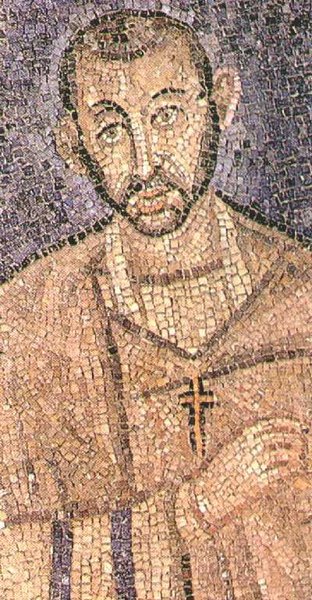
Tuesday: St. Ambrose of Milan (born in 339, died April 4,397) – Serving as Roman governor in Milan, Ambrose unexpectedly was appointed Bishop of Milan in 374 by popular acclamation after the death of Bishop Auxentius. Within a week, he was baptized, ordained and consecrated bishop, showing how quickly things can move in the Church when there is a very pressing need at hand! Known as a Doctor of the Church, he served as a mentor for St. Augustine, who was impressed by the content of his sermons which provided the most reasonable explanations of the Christian faith that he had ever heard before. Ambrose would eventually baptize Augustine. Ambrose also authored several extant theological discourses and hymns. While the Church celebrates his feast day on December 7, his consecration date as Bishop of Milan, Ambrose died on April 4, 397.
Tuesday: St. Isidore of Seville (born in 560, died April 4,636) – While his feast day is not widely celebrated as part of the US Liturgical calendar, Isidore, Archbishop of Seville in Spain holds an important recognition as the last Latin Father of the early Church. He played a pivotal role in converting the Arian Visigothic royalty of the area to Catholicism. Arianism, which was a heresy that plagued the early Church for centuries, taught that Jesus, as God the Son, was not coeternal with God the Father, having been made by the Father, and thus subordinate and distinct from God the Father. As a scholar, Isidore promoted the establishment of schools alongside the cathedrals in cities, establishing the beginnings of the education system in Spain. He also wrote many books, most notably the Etymologia, an encyclopedia that was widely used as a textbook throughout the Middle Ages. This work led to Pope St John Paul II’s declaration in 1997 of Isidore as the patron saint of the Internet because of his efforts to catalog everything known to man. Isidore died on April 4, 636.
The Upcoming Week in Church History: March 19-25
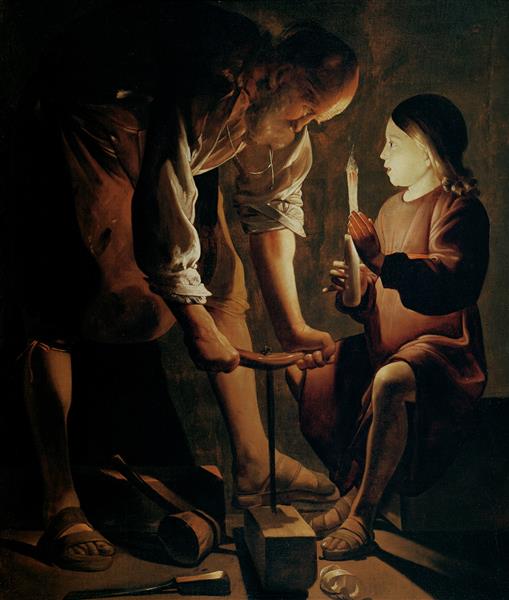
Two Solemnities highlight the upcoming week: St Joseph, the Husband of Mary and The Annunciation of the Lord. In focusing on the first one, what do we historically know about St. Joseph? Old widower? Young man? Somewhere in-between?
Monday: St Joseph, Husband of Mary (born approx 30-98 BC? died approx AD 16?) While there is little we can historically discern about Joseph from the Bible, we are told that he came from the line of King David, lived in Nazareth as a carpenter, was betrothed to Mary when she conceived Jesus by the Holy Spirit, and protected the Holy Family with the aid of a series of dreams that instructed the Holy Family to flee to Egypt and then later to return home. The last event in the Bible where Joseph is mentioned is from Luke’s unique account of Jesus being found in the Temple at the age of 12 years old. Since Joseph is not specifically mentioned in any of Jesus’ public ministry and at the Crucifixion Jesus instructed the Apostle John to take Mary into his house, it is presumed that Joseph died sometime beforehand.
Early traditions compiled within the History of Joseph the Carpenter, written in Egypt possibly as early as the 5th century, indicated that Joseph died at 111 when Jesus was about 19. The story follows the Eastern Orthodox tradition of Joseph being a widower with children from his previous marriage when he was betrothed to Mary, and thus an old man before Jesus was born.
There is also a more Western tradition of a younger Joseph based on arguments from St. Jerome in the 4th century concerning the use of “brothers,” “sisters,” or “brethren” of Jesus in Scripture as referring to Jesus’ first cousins instead of actually siblings (or more precisely, step-siblings from Joseph’s previous marriage). St Jerome’s argument comes from a combination of reflections on Jewish customs in describing familial relationships in the Old Testament writings, the lack of distinct words in the Hebrew language to clarify some of the differences in human family relationships, and how things got ultimately interpreted somewhat confusingly then into Greek translations. More recent historians also point to documents found concerning Jewish marriage practices around the 1st century showing that typically a Jewish man around 30 would be married to a woman in her mid to late teens.
At the end of the day, there is no conclusive evidence currently that makes any of these viewpoints concerning Joseph certain or incorrect. Many, including several saints, have presumed that Joseph’s body was also assumed into Heaven after his death as there is no known historical evidence confirming his burial location or what may have happened with any of his relics. The Church has not made any definitive proclamations on Joseph’s life prior to marrying Mary or his death. The Church has made it clear that Mary remained a virgin her entire life so any reference to Jesus’ siblings in the Bible are either cousins or step-siblings.
With that said, we know from the Bible that Joseph was a “just” man being completely open to all that God wanted to do for him. Joseph is the Saint of Carpenters, Fathers, and Families.
The Upcoming Week in Church History: March 12-18
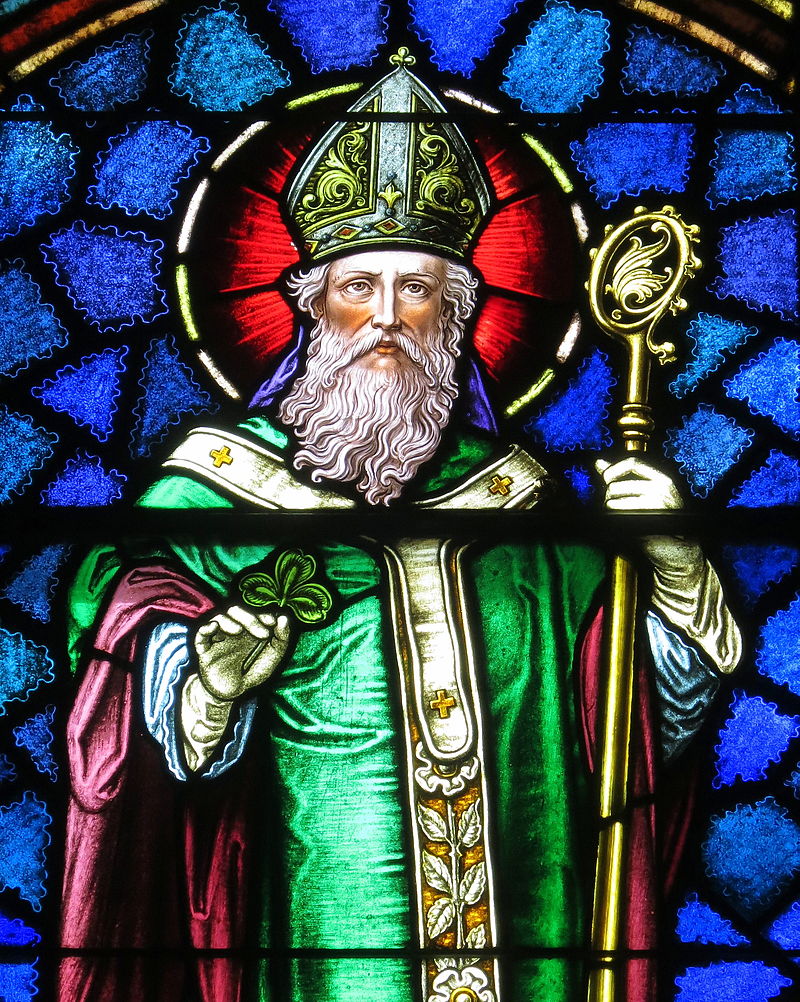
“The Lord took pity on me thousands upon thousands of times, because he saw within me that I was prepared, but that I was ignorant of what to do in view of my situation; because many were trying to prevent this mission.” These words by St. Patrick, one of two early bishops of the Church recognized this week with feast days, described his missionary work in Ireland.
Sunday: Pope St. Gregory the Great (died March 12, 604) – Known for missionary efforts and liturgical reforms, including the introduction of Gregorian chant, Gregory’s feast day is recognized on September 3rd, the anniversary date of his election as pope.
Monday: Pope Francis (elected pope March 13, 2013) – Jorge Bergoglio from Buenos Aires, Argentina becomes the first pope who was a Jesuit and from the Americas.
Wednesday: Jan Hus (excommunication published on March 15, 1411) – The papal bull excommunicating Jan Hus, a Bohemian priest and teacher, was published in Prague (Czech Republic). Jan was one of the early proponents of sola scriptura, the belief that the Bible is the only infallible authority on Christian faith, thus minimizing the role of tradition and Church authority.
Thursday: Catholic Church returns to Japan (March 16, 1865) – Priest Bernard Petitjean opens a church in Nagasaki, representing the public return of the faith in Japan which had to operate underground without priests since the late 1500s.
Friday: St. Patrick (approx 415-March 17,493) – Born in Britain, Patrick wrote in his Confessio, that he was a simple countryman who did not truly know God in his youth. At the age of 16 he was captured and sold into slavery in Ireland. Working as a shepherd for about 6 years he experienced a conversion towards God, praying frequently. During a dream he was told a ship was waiting for him to return to Britain, which prompted him to flee from his captor. Consecrated as a bishop several years later, he would experience another vision. This time hearing the “Voice of the Irish” Patrick gained a great zeal to return to Ireland as a missionary for the next 40 years. Legends such as Patrick’s banishing all snakes in Ireland (note: the geographical history and climate of the area explains why there are no native snakes) and using the shamrock to teach the Trinity surface in much later writings. The first recorded parade event in recognition of his feast day happened in St. Augustine, FL in 1601 (not Ireland or Boston).
Saturday: St Cyril of Jerusalem (approx 315-March 18,386) – A 4th century Doctor of the Church, Cyril was Bishop of Jerusalem during the time of the Arian heresy, which claimed that God the Son was not coeternal with God the Father, having been created at some point in time by the Father. Cyril wrote his Catecheses which serves as one of the earliest well-documented examples of the catechesis process for which new converts to the Christian faith were instructed and received into the Church.
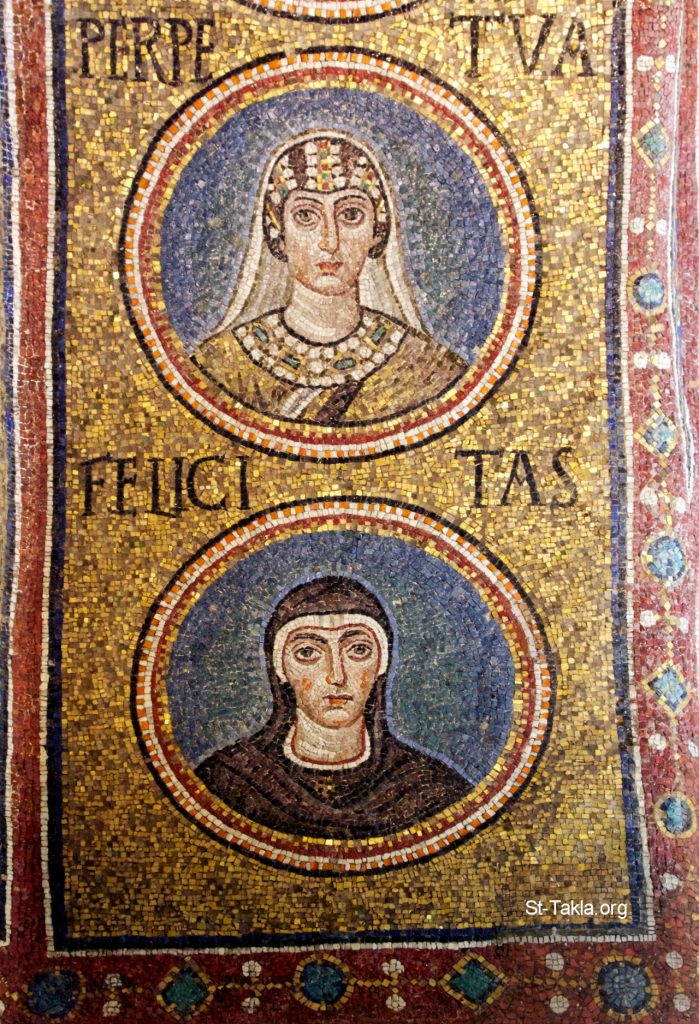
The Upcoming Week in Church History: March 5-11
“Stand fast in the faith, and love one another. Do not let our sufferings be a stumbling block to you.” This quote by Perpetua comes from the earliest preserved writings by a Christian female chronicling the zeal of faith held by two martyrs of the early Church who are among the Memorials recognized this upcoming week.
Tuesday: Sts. Perpetua and Felicity (died 203) – As a young noblewoman and mother from Carthage (modern day Tunis, Tunisia in N. Africa), Perpetua kept a diary that chronicled her final days of being imprisoned for her Christian faith in 203. She refused her pagan father’s pleas to renounce her faith, remaining loyal to Christ till her death as part of the public games. Alongside her were other imprisoned Christians including one known as Felicity, a slave woman who gave birth just days before her death. They are the Patron Saints of Widows and Mothers of Deceased Sons, and are among the list of saints that may be recited as part of Eucharistic Prayer I (aka the Roman Canon).
Wednesday: St John of God (born Joao Duarte Cidade March 8, 1495 – March 8, 1550) – Spending part of his childhood as an orphan near Toledo, Spain then a shepherd, Cidade eventually chose to become a soldier rather than marry. At one point he was tasked with guarding essentially a bunch of loot, much of which got stolen on his watch leading to a death sentence, but he was graciously pardoned by a more tolerant officer in charge. He would later continue performing military service across Europe, including fighting off the invading Turks, which at this time were advancing from the east into parts of Europe. At around the age of 40 he had something of a mid-life crisis and directed his life to service to God, journeying to Africa. After some good spiritual counseling he returned to Spain to only be accused of having a mental breakdown and being admitted into a hospital. A vision by the Infant Jesus is where the name John of God was given to him. A pilgrimage to a shrine and vision of Mary prompted him to turn his attention to hospital care, eventually establishing the Order of Hospitallers. He died on his 55th birthday. He is the Patron Saint for a number of people and institutions including Nurses, Hospitals and Firefighters.
Thursday: St Frances of Rome (1384 – March 9, 1440) – Born to an aristocratic Italian family, Frances desired to be a nun at a young age but ultimately had an arranged marriage. Known for a life of service and prayer, including the gifts of miracles and ecstasy, she sold all her possessions and money to help the sick during a devastating episode of plague which also killed two of her three children. She founded a society for women bound by no vows, they simply offered themselves to God and the service of the poor. She is the Patron Saint of Motorists and Widows.
Visit https://www.franciscanmedia.org/saint-of-the-day/ for more on each of these saints and others.
The Upcoming Week in Church History: February 26-March 4
From the birth of a Roman Emperor and the death of a young Prince to the feast days of a rather unknown monk and one of the foundresses of US Catholic education, this week offers an interesting mix of noteworthy events and figures.
Mon, Feb 27
St. Gregory of Narek (951-1003) – An Armenian monk and theologian born near Lake Van in modern-day eastern Turkey, Gregory was declared a Doctor of the Church in 2015 by Pope Francis. Little is known about him, especially in the West, but his Book of Lamentations is considered a masterpiece of mystical literature and beloved by the Armenian Apostolic and Catholic Churches, where its popularity is second only to the Bible.
Constantine the Great (Feb 27, 262) – Born on this day, Constantine would later legalize the Christian faith across the Roman Empire in 313 and play a pivotal role in calling together the first ecumenical council of the Church, First Council of Nicaea, in 325.
Tues, Feb 28, 2013
Pope Benedict XVI resigns – Citing the challenges of old age in performing his duties well, Benedict XVI became the first pope to resign since Gregory XII in 1415.
Fri, Mar 3
St. Katharine Drexel (Nov 26,1858 – Mar 3,1955) – Born in Philadelphia to a wealthy banking family, Katharine developed a keen interest in the plight of Native Americans and African Americans. She formed a new religious order called the Sisters of the Blessed Sacrament which opened its first boarding school in Santa Fe. Many more schools would follow including Xavier University in New Orleans, the first US Catholic university for African Americans. She died in 1955 at the age of 96. In 2000 she became the 2nd US-born canonized saint.
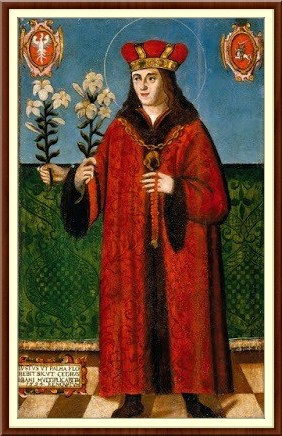
Sat, Mar 4
St. Casimir (Oct 3, 1458 – Mar 4, 1484) – Born into a noble family in Poland, Casimir was known for his intellect and piety. At a young age he was part of a failed military campaign intended to install him as King of Hungary. He would later develop lung issues, some believe it to be tuberculosis, and died in 1484 at only 25. Accounts of his miracles grew after his death including an appearance where he guided troops to a victory over the Russians around 1518. He was canonized a saint in 1522 and is the Patron Saint of Lithuania, Poland, and Russia.
(Note: The accompanying pic of a believed miraculous painting in Vilnius Cathedral in Lithuania shows Casimir with two right hands. Some believe the painter was simply trying to emphasize Casimir’s generosity but an earlier account suggests that the painter tried to redraw the right hand in a different spot but the original hand still miraculously reappeared)
The Upcoming Week in Church History: February 19-25
The Memorials this week of a Doctor of the Church and one of the early Church Fathers both offer great examples of “tough love” involving a balance of sterness in following the faith and holding people accountable to it while still showing mercy.
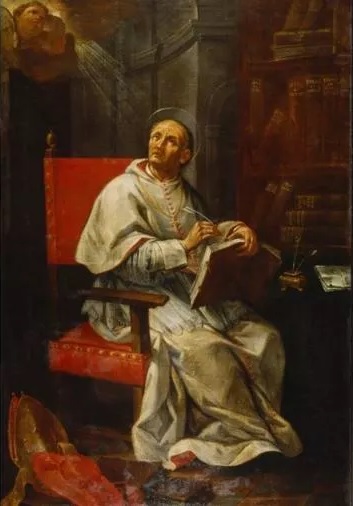
Tuesday, Feb 21 – Peter Damian (1007-1072) – Born in Ravenna, Italy, Peter’s parents died when he was at a young age so he bounced around under the care of a sister then a brother who mistreated him. Another brother, Damian, an archpriest, then took care of him and provided him with an excellent education which led to his becoming a teacher initially. It is presumed that Peter added the name Damian in gratitude to his brother’s care. Preferring a contemplative and solitude life, he aimed to become a hermit, establishing several monasteries, but also being called to be a preacher and eventually a cardinal. Known as the “Monitor of the Popes”, he reluctantly served the role of papal legate for several popes because he was so well respected. He helped resolve many conflicts and offered simple practical advice. Known as a theologian with many of his writings still extant and thus called a Doctor of the Church, he was not a fan of extensive philosophical and other secular studies. He was known for living and advocating a rather strict ascetic penitential life and pushed for reforms to clerical abuses of the time, especially the buying and selling of clerical positions. But he also advocated the importance of mercy! It is believed he died from an illness on Feb 21 or 22 in 1072 or 1073.
Thurs. Feb 23 – Polycarp (69-155) – As a 2nd century bishop of Smyrna (Turkey), Polycarp was one of the last living persons with a direct connection to an apostle, being a student of the Apostle John. One of his writings, a letter to the Philippians, still exists and serves as a glimpse into early Church life as he addressed in particular one of the age-old vices of man, greed. He is affectionately portrayed as an elderly fatherly figure, stern in teaching, condemning heresy over the belief that Jesus didn’t exist, but ever willing to offer a merciful hand. A recounting of Polycarp’s trip to Rome by his student, Irenaeus, another early Church Father, provides one of the earliest examples of how the Bishop of Rome (Pope) held a role of primacy in the universal Church over a debate on when to celebrate Easter (2 traditions had developed). Pope Anicetus agreed to honoring both traditions. In a full accounting of his martyrdom, it is mentioned that Polycarp at the age of at least 86 had to be killed by sword because efforts to burn him at the stake proved futile. While not certain, tradition holds his death to be on Feb 23.
The Upcoming Week in Church History: February 12-18
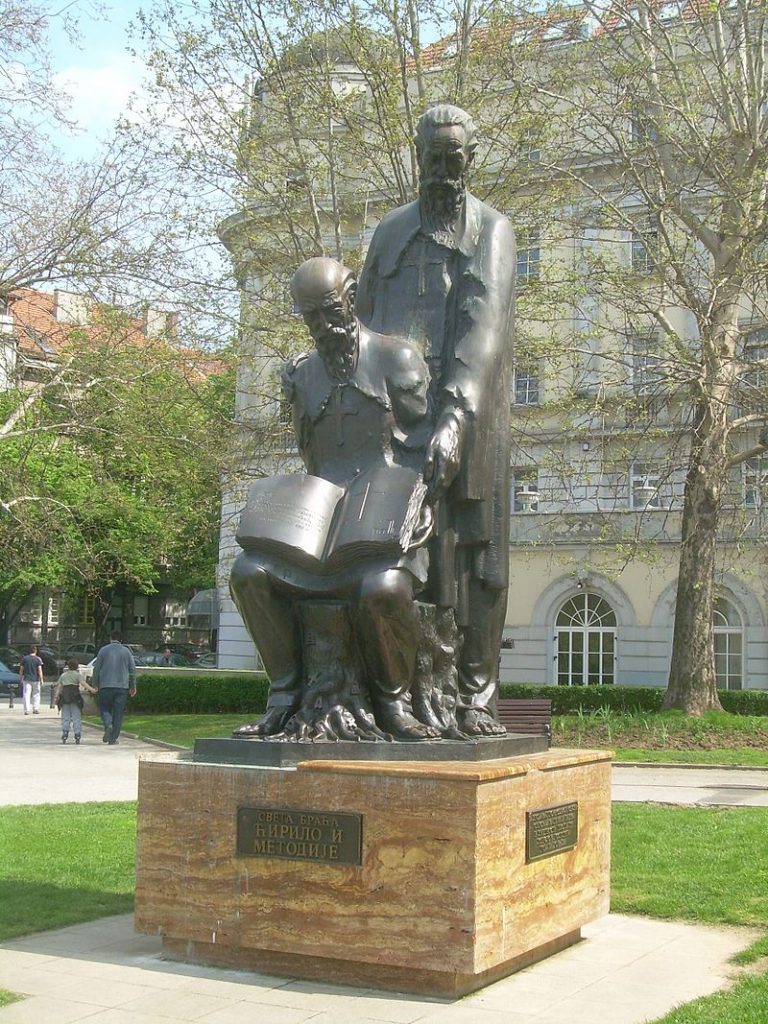
Valentine’s Day (Feb 14) is a day associated with flowers, chocolates, hearts and love, but do we know the origins of this holiday? Who was this “St. Valentine” originally associated with the day and why are Saints Cyril and Methodius recognized on this day instead in the liturgical calendar?
Ancient legends mention a 3rd century bishop Valentine of Terni, Italy who was known for preaching about Christ and performing miracles including the restoration of the eyesight of a judge’s daughter. He was jailed during ongoing Christian persecution and eventually put to death on Feb 14, 269 in Rome as a result of attempts to convince the emperor Claudius II Gothicus to embrace Christianity. Pope Gelasius I established in 496 a feast day for St. Valentine on Feb 14. Valentine’s association with love became more prominent as accounts circulated that he had secretly married young Christian couples so the men would not be forced into military service. Over the centuries there have been other Valentines (as many as 22 have been cited including a female martyr and even a Pope), which has added confusion to any historically accurate story. With little reliably known about the original Valentine and the mixing of several other Valentine figures, the Roman Catholic Church with an emphasis on recognizing feast days that have more universal importance to the Church removed St. Valentine as part of a general revamp of the liturgical calendar, but he is still recognized as a saint. The papal letter by Pope Paul VI was actually promulgated on Feb 14, 1969 (go figure).
This is when Saints Cyril and Methodius came to the forefront of the liturgical calendar on February 14. Their feast day was established back in 1880. Brothers from Greece, they were sent to part of Eastern Europe during the 800s, becoming affectionately known as the “apostles to the Slavs”, developing a written alphabet for the slavic language and paving the way for the embrace of Christianity in a large part of Europe. Cyril, who actually was called Constantine until he changed his name when becoming a monk near the end of his life, died in Rome on Feb 14, 869. His brother Methodius would continue evangelization work with the Slavs, becoming a bishop and supporting efforts to say Mass in the vernacular language instead of only Latin. He would die on April 6, 885.
Visit https://www.franciscanmedia.org/saint-of-the-day/ for more on these saints and others.
Last Week in Church History: February 5-11
Japanese martyrs, a teenage runaway, a kidnapped slave girl, the sister of the Father of Western Monasticism and Marian apparitions to a French girl highlight the Memorials recognized this upcoming week as part of the 2023 US Liturgical Calendar.
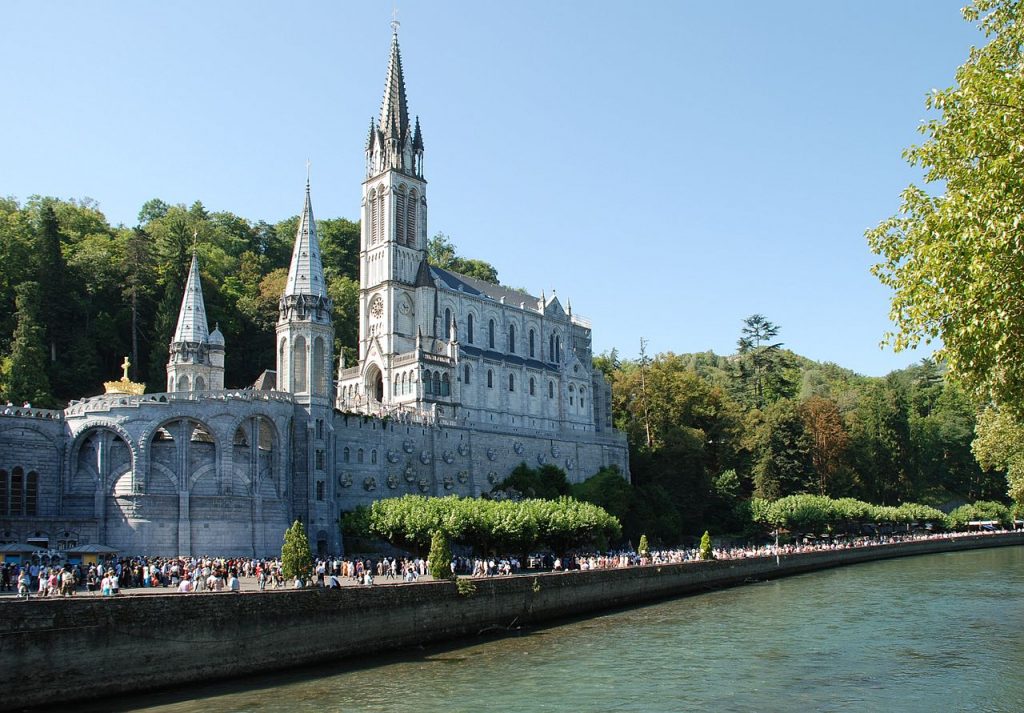
- Mon
- St. Paul Miki and Companions – A native and Jesuit priest in 16th century Japan, Paul and several Christians were crucified for their faith near Nagasaki. The faith ultimately survived underground until new missionaries arrived in the 1860s.
- Wed
- St. Jerome Emiliani (1486-1537) – Born in Venice, Italy Jerome became an orphan as a teenager and ran away to join the army. While protecting a fortress, he was taken prisoner. Attributing his liberation to the intercession of the Mother of God, his life work shifted to education, becoming a priest, and taking care of the sick and orphans. He helped establish several hospitals and orphanages and founded a religious order. Patron Saint of Orphans and Abandoned Children.
- St. Josephine Bakhita (1869-1947) – Born in southern Sudan, kidnapped and forced into slavery as a young girl, Josephine was ironically given the name Bakhita, Arabic for lucky or fortunate, by her slave traders. She converted to Catholicism while owned by a family in Italy and became a Conossian Sister shortly after being freed.
- Fri
- St. Scholastica (480-542) – Tradition holds Scholastica to be the twin sister of St Benedict. Both established religious orders near Monte Cassino, Italy. Their last annual visit together was extended through the night due to a sudden storm believed to be God’s answer to Scholastica’s prayer that Benedict stay longer as she sensed her time was ending soon. Scholastica died 3 days later. Patron Saint of Cloistered Nuns.
- Sat
- Our Lady of Lourdes (Feb 11, 1858) – This date represented the first Marian apparition to a young poor French girl named Bernadette Soubirous. As part of a later apparition, Bernadette was instructed to dig in a spot finding a spring that to this day has been a popular pilgrimage site known to bring about thousands of believed miraculous cures including at least 70 which have been officially declared scientifically inexplicable.
Visit here for more on each of these saints and others.
